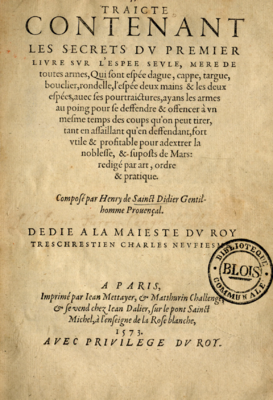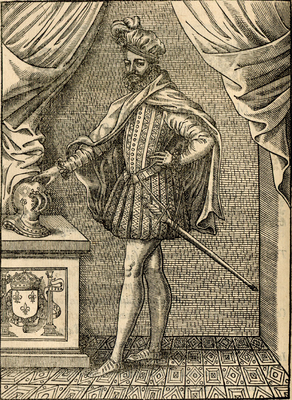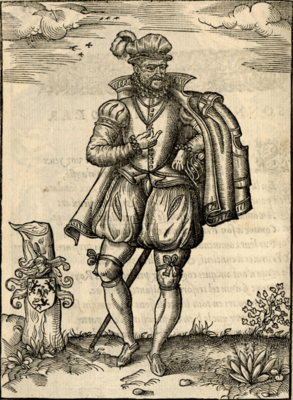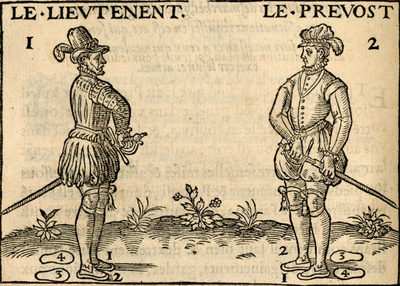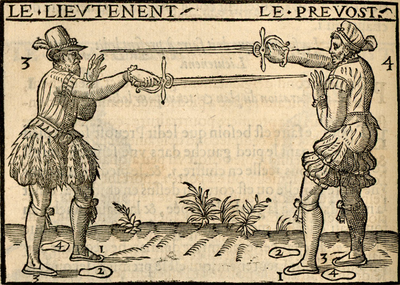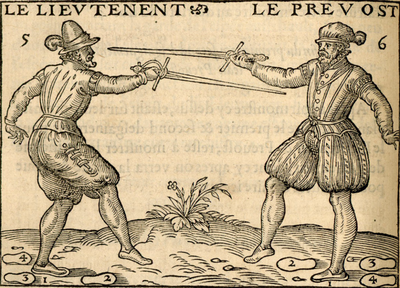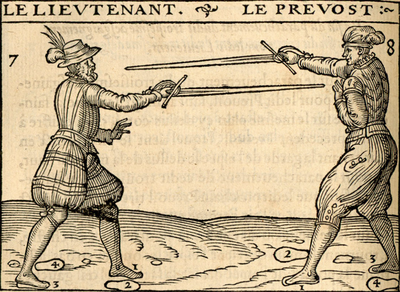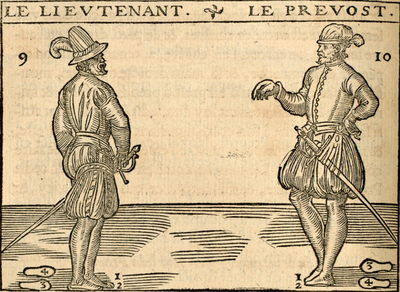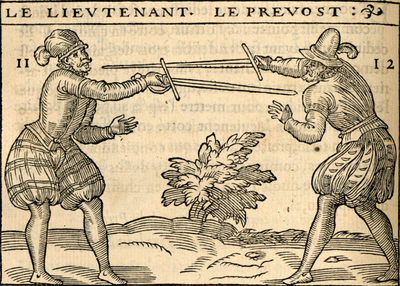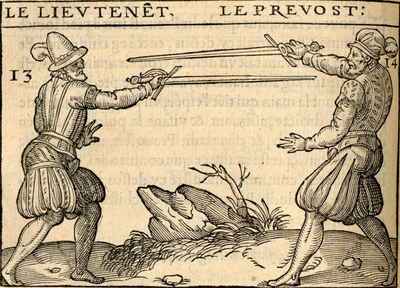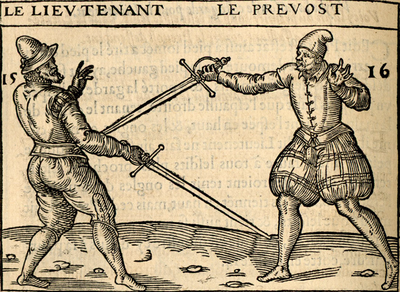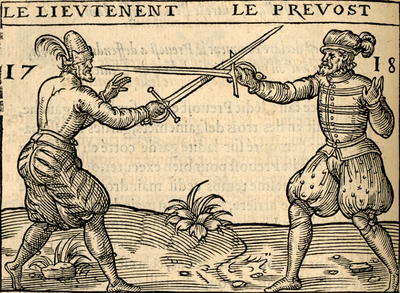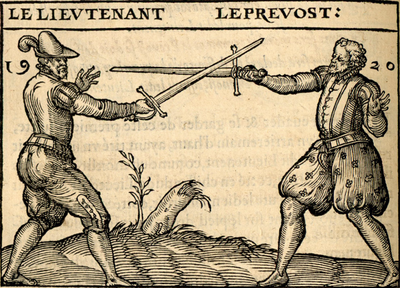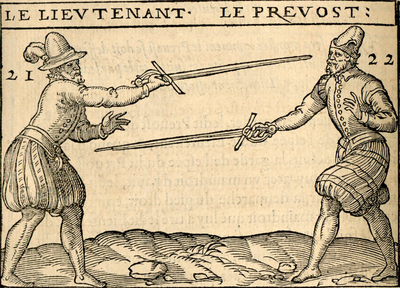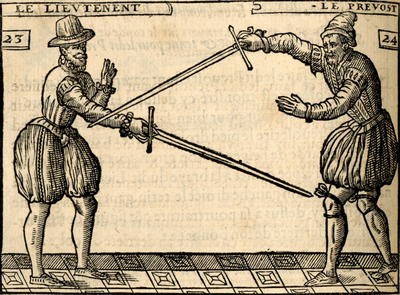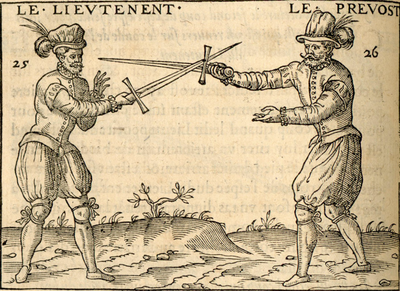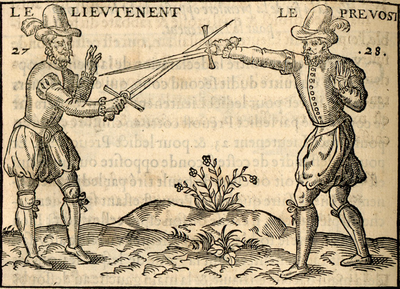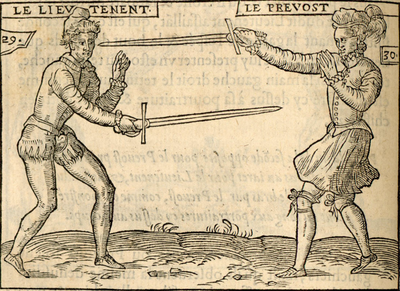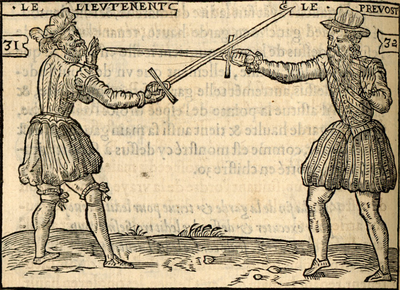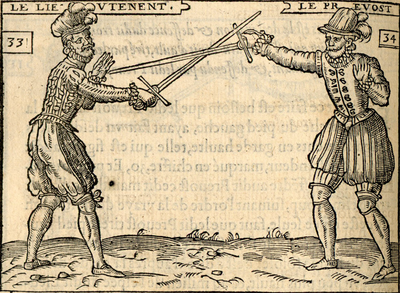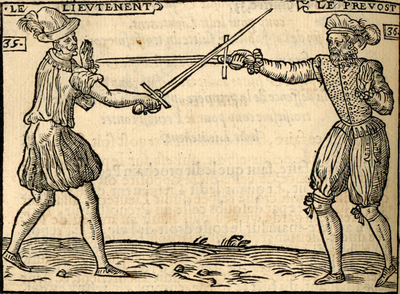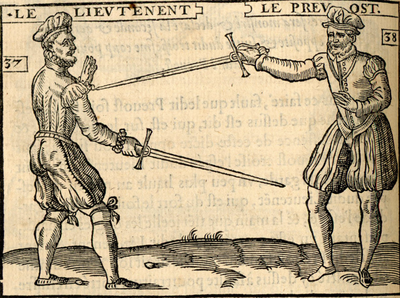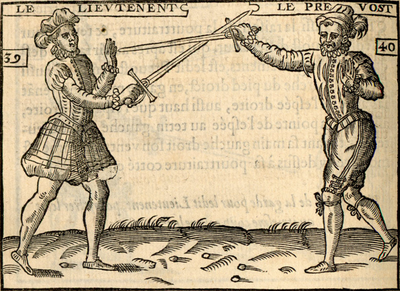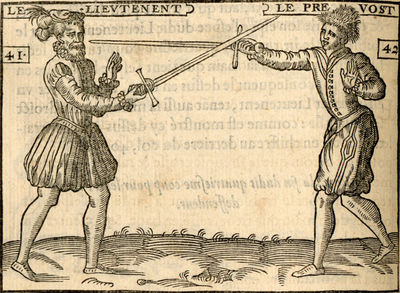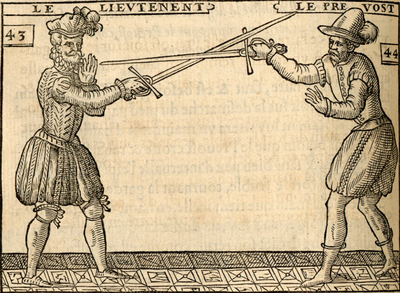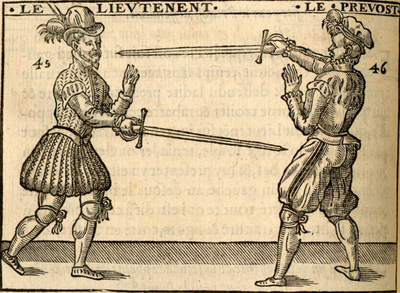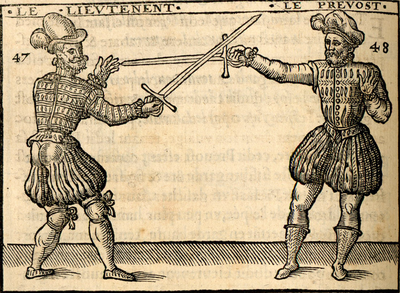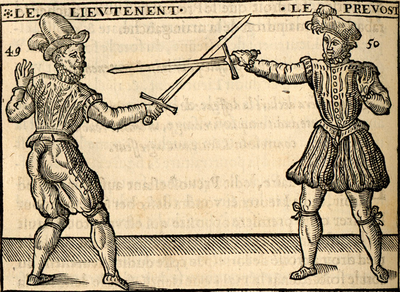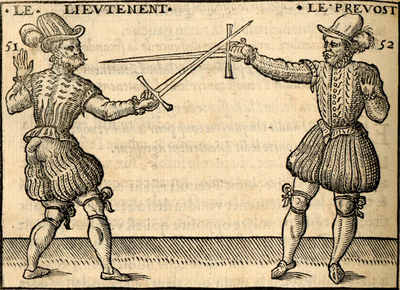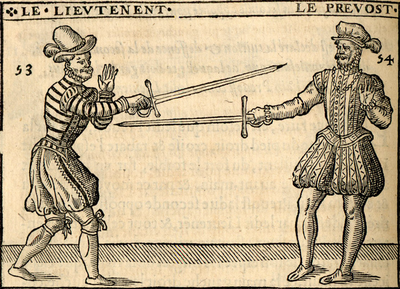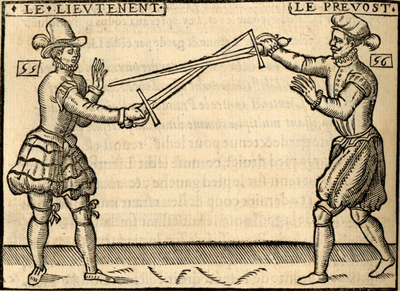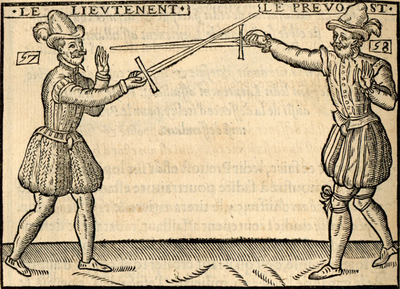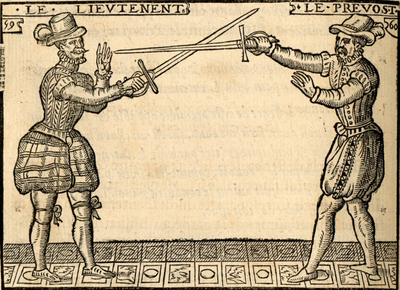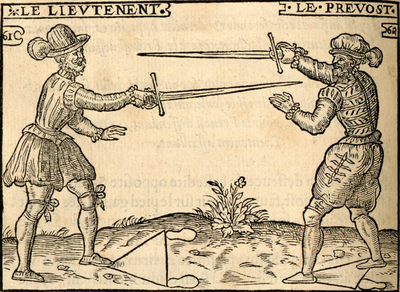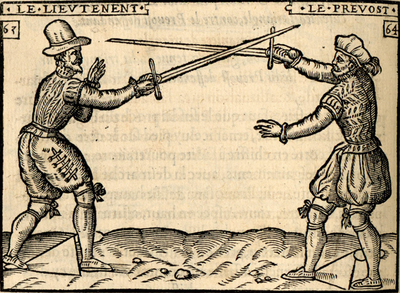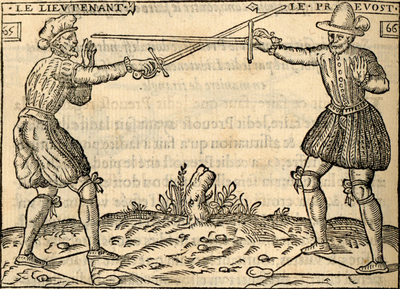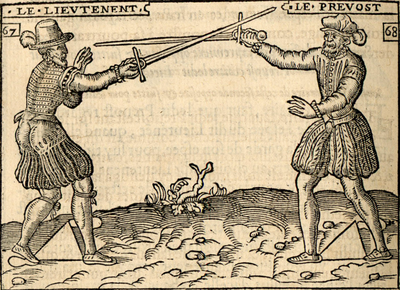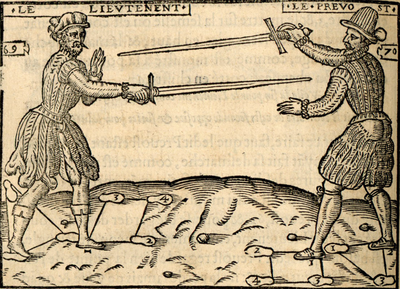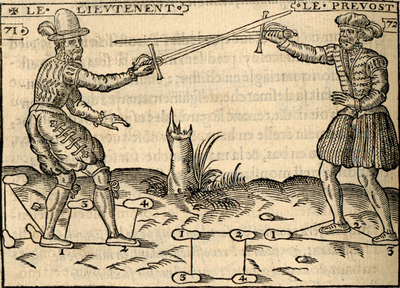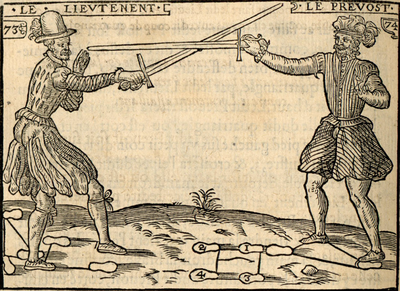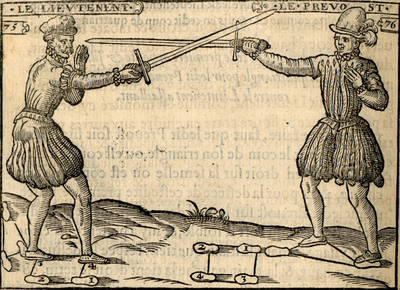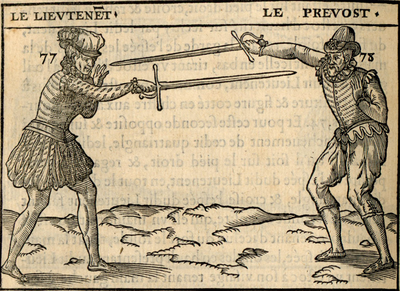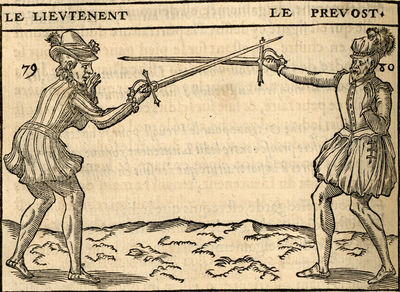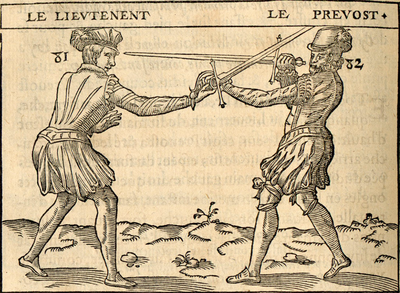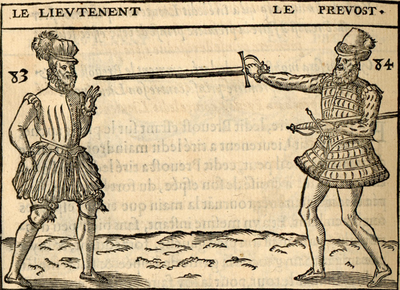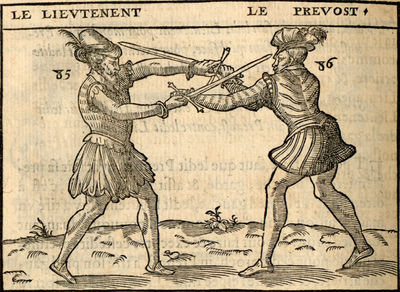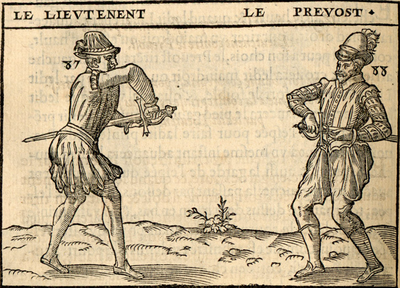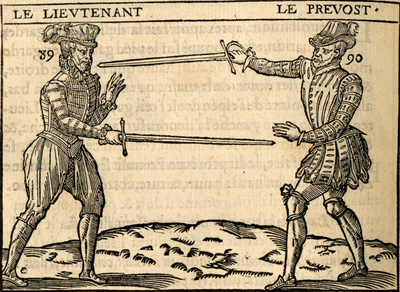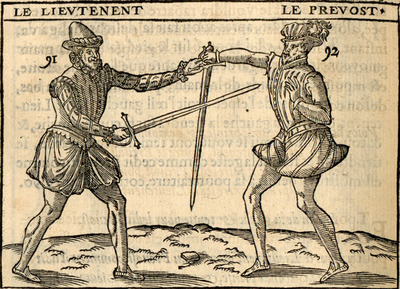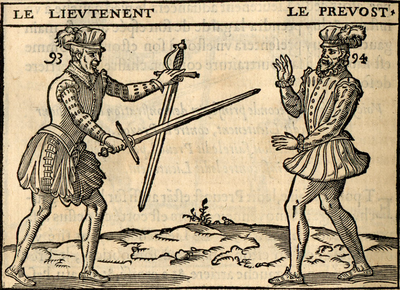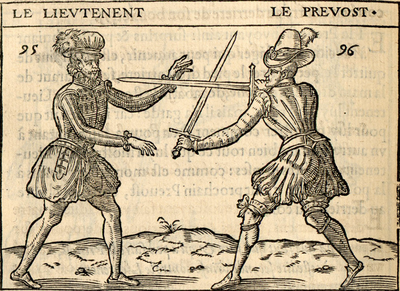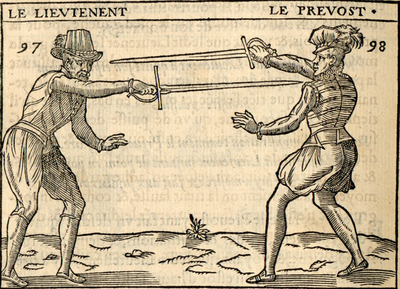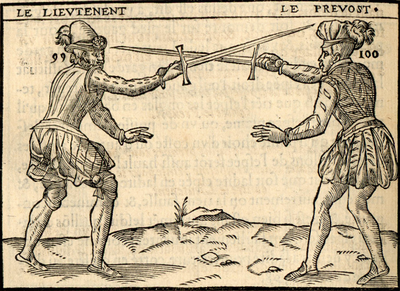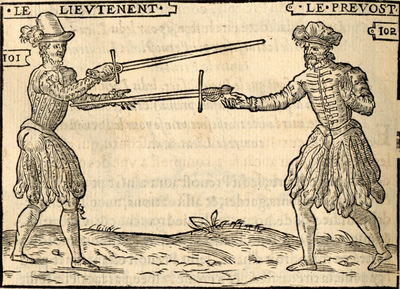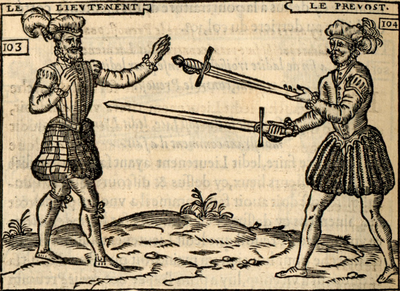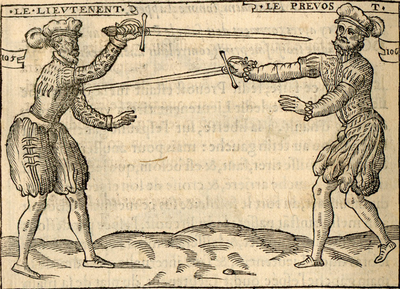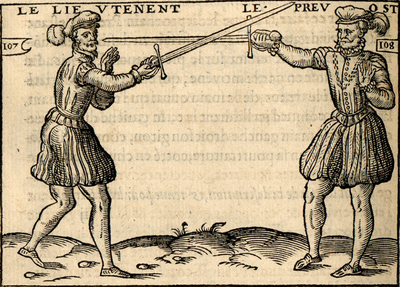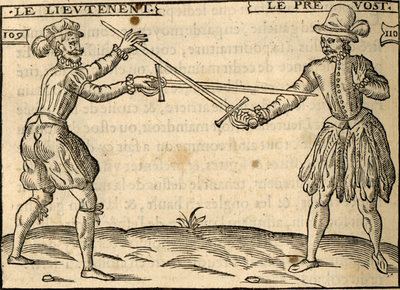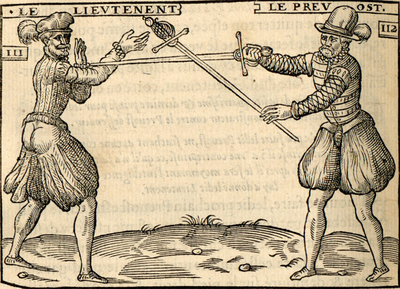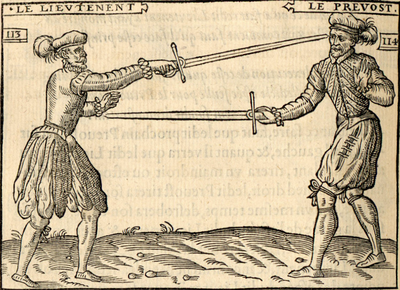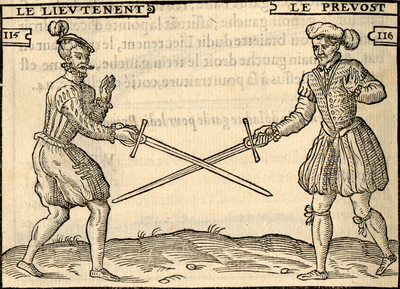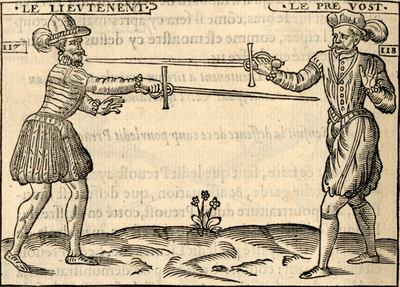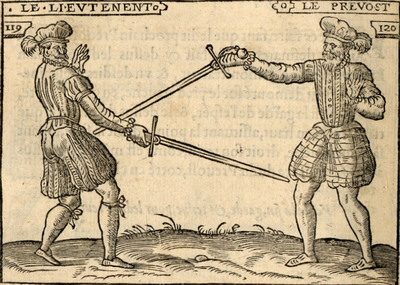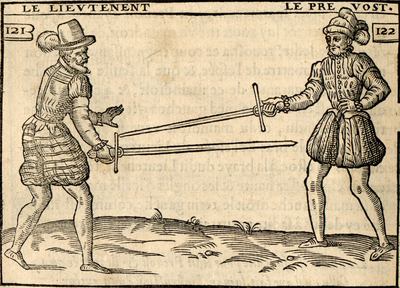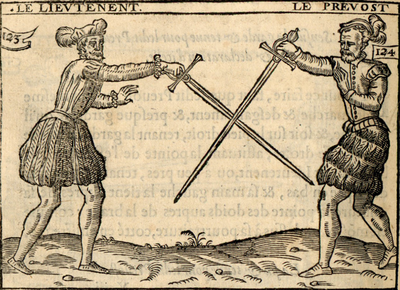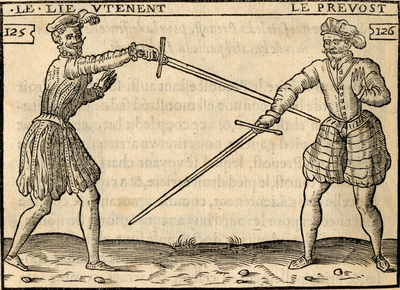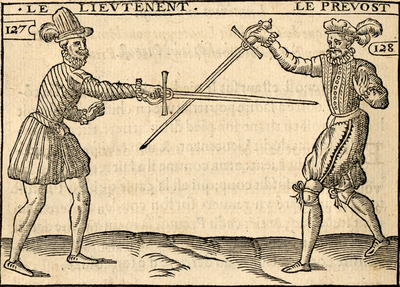|
|
You are not currently logged in. Are you accessing the unsecure (http) portal? Click here to switch to the secure portal. |
Difference between revisions of "Henry de Sainct Didier"
m (→Treatise: added one more "said") |
m (→Treatise: better english) |
||
| (5 intermediate revisions by the same user not shown) | |||
| Line 164: | Line 164: | ||
|- | |- | ||
| | | | ||
| − | | And to follow from the experienced and to imitate them, it is necessary to choose the best of two good things, and of two bad things, to avoid both if possible and if not at least avoid the worse, and in doing so, I advise all said adherents to take the better of the said two steps, which is the one you stand on the left foot for the first time with weapons in hand to make one of the said three | + | | And to follow from the experienced and to imitate them, it is necessary to choose the best of two good things, and of two bad things, to avoid both if possible and if not at least avoid the worse, and in doing so, I advise all said adherents to take the better of the said two steps, which is the one you stand on the left foot for the first time with weapons in hand to make one of the said three drawings. |
| Et pour bien suivre les doctes, & les immiter, faut de deux choses bonnes choisir la meilleure, & de deux mauvaises, eviter les deux, si faire se peut, sinon la pire, & en ce faisant, je conseille à tous lesdits suppots de prendre la meilleure desdites deux desmarches, qui est celle qu’on se tient sur le pied gauche pour la premiere fois, en mettant les armes au poing, faisant un desdits trois desgainements. | | Et pour bien suivre les doctes, & les immiter, faut de deux choses bonnes choisir la meilleure, & de deux mauvaises, eviter les deux, si faire se peut, sinon la pire, & en ce faisant, je conseille à tous lesdits suppots de prendre la meilleure desdites deux desmarches, qui est celle qu’on se tient sur le pied gauche pour la premiere fois, en mettant les armes au poing, faisant un desdits trois desgainements. | ||
| Line 702: | Line 702: | ||
|- | |- | ||
| | | | ||
| − | | The following below is how one must be planted to put the sword in hand, both in time of peace and in times of war, with the steps, guards, | + | | The following below is how one must be planted to put the sword in hand, both in time of peace and in times of war, with the steps, guards, drawings placements required in this art, which is very necessary to those who wish to practice the said fencing. |
| − | Four footprints are placed under the feet of the Lieutenant and Prevost, which is listed in number 1, and another in 2, and another in 3, and another in 4, which serves the Lieutenant and Prevost and everyone else, to teach how one must skillfully make all the steps, | + | Four footprints are placed under the feet of the Lieutenant and Prevost, which is listed in number 1, and another in 2, and another in 3, and another in 4, which serves the Lieutenant and Prevost and everyone else, to teach how one must skillfully make all the steps, drawings, guards, and placement of the weapons well as imagined in this rectangle. <br> |
1 2 <br> | 1 2 <br> | ||
4 3 | 4 3 | ||
| Line 720: | Line 720: | ||
''Here then is the declaration of this position and plan for the Lieutenant.'' | ''Here then is the declaration of this position and plan for the Lieutenant.'' | ||
| − | And to do this it is necessary that the Lieutenant first has the feet together thus placed, holding the left foot in the foot print where it is marked near number 1, and the right foot in the other footprint, where it is marked in number 2, holding the right hand at the guard of the sword, and the left hand on the scabbard of the sword, showing that he wants to teach the | + | And to do this it is necessary that the Lieutenant first has the feet together thus placed, holding the left foot in the foot print where it is marked near number 1, and the right foot in the other footprint, where it is marked in number 2, holding the right hand at the guard of the sword, and the left hand on the scabbard of the sword, showing that he wants to teach the Prevost how one must be faced: as is shown above here at the portrait of the said Lieutenant marked number 1 behind the hat. |
''The end of what the said Leiutenant must do.'' | ''The end of what the said Leiutenant must do.'' | ||
| Line 726: | Line 726: | ||
''The declaration of the plan and position of the said Prevost.'' | ''The declaration of the plan and position of the said Prevost.'' | ||
| − | And to do this the said Prevost needs to have the feet together, holding the left foot in the footprint where it is marked above here in number 1, and the right foot in the other footprint marked above in number 2, holding theright hand at the guard of the sword, and the left hand at the scabbard, showing that he is ready to make the necessary first step, as shown by the said Lieutenant, which is the first, second, and third | + | And to do this the said Prevost needs to have the feet together, holding the left foot in the footprint where it is marked above here in number 1, and the right foot in the other footprint marked above in number 2, holding theright hand at the guard of the sword, and the left hand at the scabbard, showing that he is ready to make the necessary first step, as shown by the said Lieutenant, which is the first, second, and third drawings, as is marked above at its portrait and figure in number 2. |
''Here is the end and declaration of the said first plan for the said Prevost.'' | ''Here is the end and declaration of the said first plan for the said Prevost.'' | ||
| Line 745: | Line 745: | ||
|- | |- | ||
| [[File:Sainct Didier 3-4.png|400x400px|center]] | | [[File:Sainct Didier 3-4.png|400x400px|center]] | ||
| − | | '' | + | | ''The guard to make and to execute the said first step and first and second drawings for the Lieutenant and Prevost.'' |
| − | And to do the said first step for the Lieutenant, he must have the feet together, as shown above at the first portraiture, marked in number 1, and being there, he must keep the right foot back on the footprint where it is marked number 3 above, which is for the first step. And at the same time, put the sword in hand, for the said first | + | And to do the said first step for the Lieutenant, he must have the feet together, as shown above at the first portraiture, marked in number 1, and being there, he must keep the right foot back on the footprint where it is marked number 3 above, which is for the first step. And at the same time, put the sword in hand, for the said first drawing carry the guard of the sword also higher than the right shoulder, placing the point of the sword straight at the left nipple, content 1, holding the left hand right of the face, as shown above at the portraiture of the said Lieutenant, marked in number 3 behind the collar. |
| − | ''Here is the end of the first | + | ''Here is the end of the first drawing for the said Lieutenant.'' |
| − | ''Following is the second | + | ''Following is the second drawing for the said Lieutenant.'' |
| − | For the second | + | For the second drawing for the Lieutenant, he must have have the feet together like so, as shown above at the first portraiture marked number 1. And to execute this said , he must keep the right foot a bit in the air, removing from the footprint which is marked 2, carrying the hilt of the sword, the drawing is also higher than the shoulder and the placement of this as above content 1. And in an instant pass the sword by the head, exetnding strong the arms, going to hold the guard of the sword higher than the right shoulder, placing the point of the sword at the left nipples of the Prevost, as shown in the said portraiture in number 3. |
| − | ''The end of the second | + | ''The end of the second drawing for the said Lieutenant.'' |
| − | ''Here is the declaration for the first and second | + | ''Here is the declaration for the first and second drawing for the said Prevost, which is to know how to put the sword in hand, as taught by the said Lieutenant.'' |
| − | And to do this, the said Prevost has to remember how he placed his said first plan as shown above in number 2, which is with the feet together, and being there, the said Prevost must make the said first | + | And to do this, the said Prevost has to remember how he placed his said first plan as shown above in number 2, which is with the feet together, and being there, the said Prevost must make the said first drawing by pulling the right foot he has on footprint 2 behind to the footprint which is marked number 3, which is also for the first step, and at the same time put the sword in hand, carrying the guard of the sword higher and a bit above the right shoulder, placing the point of the sword being on this high guard, straight at the left eye, holding the left hand right of the left nipple to deflect the point of the sword of the said Lietenant, if by fortune he wants to advance further, as is shown above in the portraiture marked in number 4. |
| − | ''Here is the end of the first | + | ''Here is the end of the first drawing of the said Prevost.'' |
| − | ''The following is the second | + | ''The following is the second drawing for the Prevost.'' |
| − | And to execute the second | + | And to execute the second drawing well, the Prevost must have the feet together, as shown in the said portraiture, marked at number 2, and being there, the said Prevost must pull the right foot out of the footprint where it was, which was in number 2, putting it down a bit, making the said second drawing, which is that he must carry the guard of the sword in the middle guard, and the point straight at the left nipple. And to begin the third drawing, he must pass the sword above the head, extending strongly the arms, and carrying the guard of the sword higher and a bit farther than the right shoulder, placing at the same time the point of the sword straight at the left eye of the said Lieutenant, and the left hand is holding right of the left nipple, as shown above in the first drawing, as is shown at the said portraiture marked behind the back of the person marked number 4. |
| − | ''The end of the first and second | + | ''The end of the first and second drawings for the said Prevost.'' |
| − | After having shown this first plan above, being to make the first and second | + | After having shown this first plan above, being to make the first and second drawings for the Lieutenant and the Prevost, stay for the demonstration of the third drawing, after which one will be able to see the guard and position to and to be able to execute and do it.'' |
| Line 802: | Line 802: | ||
|- | |- | ||
| [[File:Sainct Didier 5-6.png|400x400px|center]] | | [[File:Sainct Didier 5-6.png|400x400px|center]] | ||
| − | | ''Guard and position for commencing to make the third | + | | ''Guard and position for commencing to make the third drawing for the demonstrating Lieutenant at the defending Prevost.'' |
| − | This third | + | This third drawing for the Lieutenant, it is to be done with the feet together, as is stated above and shown at the said general plan, holding the left feet on the footprint where it is marked below number 1, and the right foot at the footprint where it is marked 2, and for starting well this said third drawing, the said Lieutenant must remove the right foot from the said footprint which is marked 2, and carry it forward in the air, making the first drawing, which can be seen above at its place in content 1, and while keeping the feet in the air, turn the guard of the sword, the top of the hand low, and the nails high, placing the point of the sword right at the belly, holding the left hand behind, as is shown aove at the portraiture marked number 5 behind the hat. |
| − | ''The end of the beginning of the said third | + | ''The end of the beginning of the said third drawing for the Lieutenant.'' |
| − | The third | + | The third drawing for the Prevost, is commenced and is done by having the feet together, as is shown above in the plan of the said Prevost, marked number 2, keeping the left foot in the footprint, where it is marked near number 1, and the right foot in the other footprint where it is marked 2, and to start and make the said third drawing, the Prevost must put the right foot which is on the footprint marked 2 a bit above in the air. And doing the first drawing that has been made by the said Prevost above in content 1. And to complete this said drawing, he must turn the nails on the hand of the sword upwards, content 2, placing the point of the sword straight at the eyes, holding the left hand behind, as is shown above at the portraiture and figure marked number 6 behind the bonnet. |
| − | ''Here is the end of the beginning of the said third | + | ''Here is the end of the beginning of the said third drawing for the said Prevost.'' |
| ''Garde & tenue pour commencer à faire troisiesme desgainement pour le Lieutenent demonstrateur, au Prevost deffendeur.'' | | ''Garde & tenue pour commencer à faire troisiesme desgainement pour le Lieutenent demonstrateur, au Prevost deffendeur.'' | ||
| Line 824: | Line 824: | ||
|- | |- | ||
| [[File:Sainct Didier 7-8.png|400x400px|center]] | | [[File:Sainct Didier 7-8.png|400x400px|center]] | ||
| − | | | + | | ''The last of the third drawing for the Lieutenant and the Prevost is left to declare its properties and significance below as portrayed and finished here.'' |
| + | |||
| + | To be good and graceful to finish the said third drawing for the Lieutenant, it is necessary that the plan portrayed above, where he keeps the right foot forward in the air after having made the said first and second drawing marked in number 5, is needed to be done by the said Lieutenant in order to complete this drawing, that is to pause the said right foot over the footprint marked number 3 in this portraiture, turning back the guard of the sword above the hand held high, as done by the Lieutenant marked number 3 since the artist made a mistake on this one. Yet this Lieutenant is to keep his left hand, making sure that he keeps it well under his sword arm as is shown at the portraiture number 7. | ||
| + | |||
| + | ''The last of the said final third drawing for the said Lieutenant.'' | ||
| + | |||
| + | And in order to finish the said third drawing for the Prevost, it is also necessary that he comes be on the same plan as the above marked number 5, as shown with the preceding Prevost, who keeps the right foot in the air, holding the guard of the sword above the hand held high, and in order to complete this said third drawing, it is necessary that the said Prevost holds the right foot back in the air as is said above, and to pause it on the fooprint where it is marked at the portraiture on number 3, turning the nails on the hand which is holding the sword downwards, placing the point of the sword straight at the face or the left eye, which is better, and holding the left hand right on the shoulder, as is shown above at the portraiture marked number 8. | ||
| + | |||
| + | ''Here is the last and final said third drawing for the said Prevost.'' | ||
| + | |||
| + | |||
| ''La fin du troisiesme desgainement pour le Lieutenent & Prevost, que voicy pourtraits & parachevez, reste à declarer cy dessous leurs proprietez & significations'' | | ''La fin du troisiesme desgainement pour le Lieutenent & Prevost, que voicy pourtraits & parachevez, reste à declarer cy dessous leurs proprietez & significations'' | ||
| − | Pour bien, & avec grace parachever ledit troisiesme desgainement pour ce Lieutenent, faut estant sur le plan cy dessus pourtraict, où il tient le pied droict<ref>Correction du texte d’origine donnant « peid ».</ref> en avant en l’air ayant fait ledit premier & second desgainement, cotté en chiffre, 5, est besoin que ledit Lieutenent, pour parachever ce desgainement, qu’il pause ledit pied droict qu’avoit en l’air, sur la semelle où est cotté à ceste pourtraiture en chiffre 3, retournant la garde de l’espée le dessus de la main en haut, comme fait le Lieutenent où est cotté en chiffre 3, car le pourtrayeur a faict faute à cestuy cy<ref>Cette correction sur les images d'Henri de Saint-Didier indique que celles-ci ont été réalisées avant la version finale | + | Pour bien, & avec grace parachever ledit troisiesme desgainement pour ce Lieutenent, faut estant sur le plan cy dessus pourtraict, où il tient le pied droict<ref>Correction du texte d’origine donnant « peid ».</ref> en avant en l’air ayant fait ledit premier & second desgainement, cotté en chiffre, 5, est besoin que ledit Lieutenent, pour parachever ce desgainement, qu’il pause ledit pied droict qu’avoit en l’air, sur la semelle où est cotté à ceste pourtraiture en chiffre 3, retournant la garde de l’espée le dessus de la main en haut, comme fait le Lieutenent où est cotté en chiffre 3, car le pourtrayeur a faict faute à cestuy cy<ref>Cette correction sur les images d'Henri de Saint-Didier indique que celles-ci ont été réalisées avant la version finale du texte.</ref>. Mais cestuy Lieutenent icy tient bien sa main gauche, attendu qu’il la tient soubs le coude du bras de l’espée, comme est monstré à sa pourtraiture cotté en chiffre 7. |
| − | du texte.</ref>. Mais cestuy Lieutenent icy tient bien sa main gauche, attendu qu’il la tient soubs le coude du bras de l’espée, comme est monstré à sa pourtraiture cotté en chiffre 7. | ||
''La fin du parachevement dudit troisiesme desgaignement pour ledit Lieutenent.'' | ''La fin du parachevement dudit troisiesme desgaignement pour ledit Lieutenent.'' | ||
| Line 838: | Line 847: | ||
|- | |- | ||
| [[File:Sainct Didier 9-10.png|400x400px|center]] | | [[File:Sainct Didier 9-10.png|400x400px|center]] | ||
| − | | | + | | ''General position for both the attacking Lieutenant as well as for the defending Prevost, in order to execute the art, order, and practice contained in this sword alone. |
| + | |||
| + | In order to show and declare this general position for the Lieutenant, he needs place his feet together for all strikes, where to roughly, hold the left foot in the footprint which is marked number 1, and the right foot in the other footprint which is also marked on number 2, holding the right hand at the guard of the sword, and the left hand at the scabbard, showing to the Prevost how he must do so, as is shown above at the portraiture, marked number 9. | ||
| + | |||
| + | ''The end of the position and plan for the said Lieutenant.'' | ||
| + | |||
| + | ''The following is the plan and position that the said defending Prevost must do, being instructed by the said Lieutenant.'' | ||
| + | |||
| + | And similarly to do this, the said Prevost is to place his feet together, keeping the left foot in the footprint that is marked number 1, and the right foot in the other footprint marked number 2, keeping also his sword on his left side, and his right hand open, showing by this that he is ready to take the sword, and to do what the said Lieutenant would say, the said Prevost also is keeping his left hand on his side, showing that he is nimble, and not far to put the sword in hand, and to do the said Lieutenant marked in number 9, and the said Prevost must do, and follow everything that is written here, and as is also written at the portraiture and figure marked at number 10. | ||
| + | |||
| + | ''The end of the position and plan for the said Prevost.'' | ||
| + | |||
| ''Tenue generalle, tant pour le Lieutenent assaillant, que pour le Prevost deffendant, pour executer l’art, ordre & pratique contenu en ceste espée seule.'' | | ''Tenue generalle, tant pour le Lieutenent assaillant, que pour le Prevost deffendant, pour executer l’art, ordre & pratique contenu en ceste espée seule.'' | ||
| Line 853: | Line 873: | ||
|- | |- | ||
| [[File:Sainct Didier 11-12.png|400x400px|center]] | | [[File:Sainct Didier 11-12.png|400x400px|center]] | ||
| − | | | + | | ''Postion and guard of the first strike of this sword alone, for the Lieutenant, which is a low right-hand at the leg of the Prevost, thrown by the Lieutenant, and defended by the Prevost, as will be seen after the first strike.'' |
| + | |||
| + | And to do this the Lieutenant is to have the feet together, as is shown above in the portraiture of the said Lieutenant marked number 9, will pull the right foot backwards a little apart, and in drawing his sword, will take the sword guard higher than his shoulder, placing the point straight at the left nipple of the Prevost, holding the left hand below the arm, as is shown above at the portraiture marked number 11 behind the bonnet. | ||
| + | |||
| + | ''Written for the first guard and position for the said Prevosit, in order to begin the section on this sword alone.'' | ||
| + | |||
| + | And to do this, the said Prevost must have his feet together as is portrayed above marked in number 10. And this said Prevost having made one of the said three drawings, is to remain in the high guard, having pulled the right foot back, holding the hand with the the sword a bit higher than the right shoulder, placing and aiming the point of the sword straight at the chin, and holding the left hand right of his nipple, ready to do whatever is acceptable, and will be needing afterwards as is shown above at the portraiture and figure of the said Prevost marked number 12 behind the hat. | ||
| + | |||
| + | ''The end of this first guard for the said Prevost.'' | ||
| + | |||
| ''Tenue & garde du premier coup de ceste espée seule, pour le Lieutenent, qui est un maindroit de bas au jarret du Prevost, tiré par le Lieutenent, & deffendu par le Prevost, comme se verra cy aprés au premier coup.'' | | ''Tenue & garde du premier coup de ceste espée seule, pour le Lieutenent, qui est un maindroit de bas au jarret du Prevost, tiré par le Lieutenent, & deffendu par le Prevost, comme se verra cy aprés au premier coup.'' | ||
| Line 1,054: | Line 1,083: | ||
''Here is the end of the position and guard for the attacking Lieutenant, which is to begin to throw the fourth strike.'' | ''Here is the end of the position and guard for the attacking Lieutenant, which is to begin to throw the fourth strike.'' | ||
| − | Following also the reasoning of the portraiture and positioning for the said defending Prevost, who after having made one of the said three | + | Following also the reasoning of the portraiture and positioning for the said defending Prevost, who after having made one of the said three drawings the said Prevost also remains upon the stepping of the right foot in middle guard, keeping the guard of the sword straight, higher than the right shoulder, placing the point of the sword at the left nipple of the said Lieutenant, and holding the left hand right of his stomach, as shown above at the portraiture marked in number 38. |
''Here is the end of the guard for the said Lieutenant to throw the fourth strike against the Prevost.'' | ''Here is the end of the guard for the said Lieutenant to throw the fourth strike against the Prevost.'' | ||
| Line 1,794: | Line 1,823: | ||
| ''The following is a treatise on exercise and certain points required to know the tennis, for all those who love it, written by the said Author, since it requires the same steps and to know the same strikes of the said fencing, as will be seen by this treatise, and the said Author because of the said affinity and friendship they have together, leads to alert and give instruction to the unlearned, which do not understand the terms of this exercise, and not for the learned and skillful.'' | | ''The following is a treatise on exercise and certain points required to know the tennis, for all those who love it, written by the said Author, since it requires the same steps and to know the same strikes of the said fencing, as will be seen by this treatise, and the said Author because of the said affinity and friendship they have together, leads to alert and give instruction to the unlearned, which do not understand the terms of this exercise, and not for the learned and skillful.'' | ||
| − | The said author having considered that tennis, and fencing are closely related, as was said above, and whoever will be able to play said tennis easily would also have learned to throw sword strikes, and so is the opposite, but the one better than the other is fencing, because they preserve the health and honor of those who are afraid of losing it. Anyone could ask why are said fencing and tennis related? The Author responds to this and says that from the same strikes that one | + | The said author having considered that tennis, and fencing are closely related, as was said above, and whoever will be able to play said tennis easily would also have learned to throw sword strikes, and so is the opposite, but the one better than the other is fencing, because they preserve the health and honor of those who are afraid of losing it. Anyone could ask why are said fencing and tennis related? The Author responds to this and says that from the same strikes that one throws from said weapons to overcome his enemy in times of peace or to win money or some celebration, which are. |
# Right-hand | # Right-hand | ||
Revision as of 21:31, 15 January 2021
| Henry de Sainct Didier | |
|---|---|
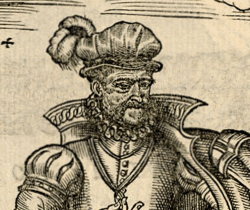 | |
| Born | 1530s (?) Pertuis, Provence |
| Died | after 1584 Paris, France (?) |
| Occupation | Fencing master |
| Patron | Charles IX of France |
| Influences | |
| Influenced | Salvator Fabris (?) |
| Genres | Fencing manual |
| Language | Middle French |
| Notable work(s) | Les secrets du premier livre sur l'espée seule (1573) |
| Translations | Traducción castellano |
| Signature | |
Henry de Sainct Didier, Esq. was a 16th century French fencing master. He was born to a noble family in Pertuis in the Provence region of France, son of Luc de Sainct Didier. Sainct Didier made his career in the French army, ultimately serving 25 years and seeing action in Piedmont, Italy from 1554 - 1555. He wrote of himself that he "lived his whole life learning to fight with the single sword" and eventually "reached a point of perfection" in his art. Apparently he became a fencing master of some renown, for in ca. 1573 he secured a royal privilege for a period of ten years for treatises on a number of weapons, including the dagger, single side sword, double side swords, sword and buckler, sword and cloak, sword and dagger, sword and shield (both rotella and targe), and greatsword. Unfortunately, only his treatise on the single side sword, titled Les secrets du premier livre sur l'espée seule ("Secrets of the Premier Book on the Single Sword") and printed on 4 June 1573, is known to survive; it seems likely that the others were never published at all.
Contents
Treatise
Illustrations |
by John Tse | |
|---|---|---|
| TREATY CONTAINS THE SECRETS OF THE FIRST BOOK ON THE SWORD ALONE, MOTHER OF
all fencing, Which are dagger, cape, targe, buckler, rondel, two handed swords, and dual swords, with pictures, having weapon in hand for throwing strikes to defend and offend at the same time, both offensively and defensively, very useful and profitable for being on the right of nobility, and disciples of Mars: written for art, order, and practice. Composed by Provencal Gentleman Henry de Sainct Didier. DEDICATED TO THE MAJESTY OF THE VERY CHRISTIAN KING CHARLES THE NINTH. PARIS, Printed by Jean Mettayer, and Matthurin Challenge, and is sold at Jean Dalier, on the Saint Michel bridge, to the sign of the White Rose, 1573. WITH PRIVILEGE OF THE KING. |
TRAICTE CONTENANT LES SECRETS DU PREMIER LIVRE SUR L’ESPEE SEULE, MERE DE
toutes armes, Qui sont espée dague, cappe, targue, bouclier, rondelle, l’espée deux mains & les deux espées, avec ses pourtraictures, ayans les armes au poing pour se deffendre & offencer à un mesme temps des coups qu’on peut tirer, tant en assaillant qu’en deffendant, fort utile & profitable pour adextrer la noblesse, & suposts de Mars : redigé par art, ordre & pratique. Composé par Henry de Sainct Didier Gentilhomme Provençal. DEDIÉ À LÀ MAJESTE DU ROY TRESCHRESTIEN CHARLES NEUVIESME. À PARIS, Imprimé par Jean Mettayer, & Matthurin Challenge, & se vend chez Jean Dalier, sur le pont Sainct Michel, à l’enseigne de la Rose blanche, 1573. AVEC PRIVILEGE DU ROY. | |
| LETTER TO THE KING.
SIRE, It does not please me to say how many are to be praised for those who strive (as they say) to help or even perfect the nature, of reducing the confusion to order, and in such a way that the face of it appeared rough, sick, and inaccessible; was made easy, accessible, and approachable by them. Even though the only harm that results from confusion and disorder, and among other things that are proper to the Gentlemen make them quite recommendable. Why would I turn my pen elsewhere to show you, that to restore a battle that is in disarray, and to put it back in its previous order, it is necessary that a leader to be familiar with two things. To make sure decision to save time and the place, where and when to stop the broken ranks and by a feint to divert the enemies, while the remaining troops reform and regroup. That decision cannot be acquired, even the reason for it cannot be believed without the second point that I the leader must make is truly necessary, which is having the experience of things, from which arises the aforementioned decision. (SIRE) whoever wants to put art or doctrine back in order to avoid confusion lest in the end it will be wasted decision is required, arises from the experience seen through the exercise of the said art, which I have from having served in doing battle, very much for your grandfather, as well as for your Majesty, for twenty years in Piedmont and elsewhere. I can justly attribute to myself having used my life to experience such arms, so much so that accumulating such evidence may have allowed me to to perfect the art and the practice of them. So seeing how confused, and disordered they have been and are for today by everyone shown, and practiced, have in my mind figured some model or idea, according to which as an example, I make sure that the order will not only be good, so the art that consists of it will be completely restored, and will reach closer to perfection, which I have longed for, both because of my powerlessness and extreme poverty ( the enemy of good spirits) as well as to be prevented from serving you, kept hidden and buried among my papers in my office, where the Muses after martial efforts made me, and hope that will keep me company. But I now have the desire to give you a most humble and pleasant service, far from the zeal that all my life I have had to fencing, and to those who love them, and who make a profession of them, have allowed little, that in this time (when Mars gives us some respite) I have not been emboldened to present myself to your Majesty, something not worthy of such a great Monarch, but very suitable for the exercise of a common man, both in war and peace, namely a treatise on the sword alone, mother of all fencing, that I wrote according to my opinions, which contains six points, that I declare has never been organized, and the proofs of it, both by reason and by effect attached to the end. Here (SIRE) will contain this little work, which is like a summary or collection of the first book that I still have beside me. If your Majesty appreciates this, by God giving me the grace to live, I hope by means of your Majesty to later enlighten others. Therefore (who is the first and foremost to extricate the nobility) I thought worthy of you, who is the protector and support of fencing, of this treatise, begging you most humbly, where and when it would be reputed by other, to please take my ardent affection, which for a long time has been dedicated to offer you most humble and pleasant service, in payment for employing me for something which this concerns, and I will be more than happy with endless opportunity and will, more than great to pray to the Sovereign Rector of the Universe to give you a long, and happy life. And for the boundary of your Empire to only be the Sea.
|
EPISTRE AU ROY.
SIRE, Je ne m’amuseray à vous descrire combien sont à louer ceux qui taschans (comme l’on dit) ayder voire parfaire la nature, ont reduit les choses confuses en ordres, & de telle sorte que ce que de primeface sembloit rude, malaisé, & inaccessible, a esté par eux rendu aisé, traictable, & facile à aborder. Veu mesmement que le seul mal qui provient de la confusion & desordre des choses, et entre autres de celle qui sont propres aux Gentils-hommes les rendent assez recommandables. Parquoy tourneray ailleurs ma plume à vous remonstrer, que pour restaurer une bataille qui est en derroute, & la remettre en son pristin[1] ordre, il est besoin à un chef avoir deux choses bien familieres. Assavoir le jugement, pour gaigner le temps & le lieu, où & quand il faut arrester les rancs rompus & par une fainte cargue amuser les ennemis, pendant que le reste des troupes se rassemble & reserre. Lequel jugement ne se peut acquerir, voire la raison d’iceluy ne se peut croire sans le second poinct que je dy au chef estre fort necessaire, qui est l’experience des choses, de laquelle naist le jugement susdit. (SIRE) quiconque veut remettre quelque art ou doctrine en son ordre ou la tirer de la confusion, de peur qu’en fin elle ne se gaste, il est requis qu’il soit fourny de jugement, nay de l’experience veue par lexercice dudit art, ce que je ne dy sans cause car ayant fait service au faict des armes, tant à voz ayeux, comme aussi à vostre Majesté, par l’espace de vingtcinq ans en Piedmont & ailleurs. Je me puis justement attribuer avoir usé ma vie à l’expérience desdites armes, tellement qu’une si longue preuve peut avoir en moy engendré quelque perfection de l’art & pratique d’icelles. De sorte que voyant combien confusément, & avec mauvais ordre elles ont esté & sont pour le jourd’huy par tout le monde monstrées, & pratiquées, ay en mon cerveau figuré quelque patron ou idée, suivant laquelle comme exemplaire, je me fay fort que l’ordre en sera non seulement bon, ains l’art qui y consiste sera du tout restauré, & atteindra plus prés sa perfection, lequel j’ay par longs jours, tant à cause de mon impuissance & extreme pauvreté (ennemie des bons esprits) comme aussi pour estre empesché à vostre service, tenu caché & ensevely parmy mes papiers en mon cabinet, où les Muses aprés les efforts martiaux m’ont fait, & espere que me feront compaignie. Mais maintenant le desir que j’ay de vous faire treshumble & tresagreable service, loinct le zelle que toute ma vie j’ay eu aux armes, & à ceux qui les aiment, & qui en font profession, n’ont peu permettre, qu’en ce temps (ou Mars nous donne quelque relasche) je ne me sois enhardy presenter à vostre Majesté, chose non digne d’un tel & si grand Monarque, mais fort propre pour l’exercice d’un commun père, tant des armes que de paix, scavoir, un traicté sur l’espée seule, mere de toutes armes, que j’ay composé suivant mon petit jugement, dans lequel sont contenus six poincts, par cy aprés declarez, avec un ordre, non encores jamais usité, & la preuve d’iceluy, tant par raison que par effait attaché au bout. Voyla (SIRE) que contiendra, à present ce petit œuvre, qui est comme un sommaire ou recueil du premier livre que j’ay encores par devers moy. Parquoy si vostre Majesté prent quelque goust à cestuy cy, Dieu me donnant la grace de vivre, j’espere par le moyen de vostredite Majesté en mettre par cy aprés d’autres en lumiere, Donc cestuy (qui est le premier & principal pour adextrer la noblesse) j’ay pensé digne de vous, qui estes le protecteur, & soustien des armes, desquelles il traicte, vous suppliant plusque treshumblement, là & quand il seroit reputé autre vous plaise prendre mon ardente affection, laquelle de long temps a esté dediée à vous offrir treshumble, & tresagreable service, en payement m’employant à quelque chose, qui concerne iceluy, & je me tiendray plus que tresheureux avec perpetuelle occasion & volonté, plus que grande de prier le souverain Recteur de l’univers vous donner treslongue, & tresheureuse vie. Et pour borne de vostre Empire la seule Mer Occeane. | |
| Your most humble, and obedient servant, Henry de S. Didier, Provencal Gentleman. |
Vostre treshumble, & obeïssant serviteur, Henry de S. Didier, Gentilhomme Provençal. | |
| The following six points are required to understand, and above all to best execute the secrets of the sword alone and of all the other weapons that are dependent.
The first is to know how many types of steps there are in the art of said fencing, and to choose the best, and explaining the reason. |
S’ensuivent les secrets de ceste espée seule, & de toutes les autres armes qui en dépendent, pour lesquels entendre, & sur tout mieux executer, six poinct sont requis.
Le premier est combien de desmarches il y a en tout l’art desdites armes, & eslire la meillleure, & en donner raison. | |
| The second, how many guards and placements there are of said fencing and to choose the best, and explain the reason. | Le second, combien de gardes, & situations y a ausdittes armes & eslire la meilleure, & par quelle raison. | |
| The third, how many strikes the aggressive enemy can offend the defender and then explaining the reason. | Le troisiesme, de combien de coups l’ennemy aggresseur peut offencer le deffendeur & en donner pareille raison. | |
| The fourth, how many clean targets can be listed for the said strikes on the person, both in attacking as well as in defending. | Le quatriesme, en combien de lieux propres se peuvent adapter lesdits coups sur la personne, tant en assaillant, qu’en deffendant. | |
| The fifth, is namely, to all those who make or will make, the profession of teaching the said fencing: being able to defend and offend at the same time a strike or strikes that can be thrown, and thus if they do not know, how will they be able to teach their disciples. | Le cinquiesme, sçavoir, à tous ceux qui font, ou feront, cy aprés profession de monstrer audites armes : soy deffendre & offencer à un mesme temps de quelque coup ou coups qu’on peut tirer, & par ainsi s’ils ne les sçavent comment les pourront ils monstrer à leurs disciples. | |
| By the sixth point, which is the last will behold a great secret, which is to decide which strike that the attacker can throw on the defender and will be explained. | Par le sixiesme poinct, qui est le dernier on verra un grand secret, qui est de juger du coup que l’assaillant peut tirer sur le deffendeur
& en sera donné raison. | |
| Regarding the first point, which is to know how many steps there are, I answer that there are no more than two, because we have no more than two feet. | Quand au premier poinct, c’est à sçavoir combien il y a de desmarches, je respond qu’il n’y en a[2]que deux, par ce que nous n’avons que deux pieds. | |
| Some stand on the right foot, others on the left foot, however none give good reasons for one step or the other. But for being well assured when he must take the sword in hand, knowing which of the said steps is best and is the most effective in this is necessary to be keep for executing the said art. | Les aucuns se tiennent sur le pied droict, les autres sur le pied gauche, toutefois en donnent bien peu de raisons, soy tenant sur l’une ou sur l’autre desmarche. Mais pour estre bien asseuré quand il est besoing de mettre l’espée au poing, faut sçavoir laquelle desdites deux desmarches est la meilleure & la plus certaine & superlative & en icelle comme dit est se faut tenir pour executer ledit art. | |
| As for me I favor with experience and reason the step which is done by standing on the left foot for the first time, in putting sword in hand, is better and more effective, both for attacking and for defending. How much do our older teachers stick to this, either on one or the other, give very little reason. For this reason I will conclude that there are no more than two steps in all the art, to start this off. | Quant à moy je soustiens avec l’esperience & preuve la desmarche qui se faict, soy tenant sur le pied gauche, pour la premiere foys, en mettant l’espée au poing, est la plus certaine & meilleure, tant pour l’assaillant que pour le deffendant. Combien que peu de noz encestres demonstrateurs s’y tiennent, & soy y tenant, tant sur l’un que sur l’autre, en donnent bien peu de raison. À ceste cause je concluray qu’il n’y a que deux desmarches en tout l’art, pour bien commencer iceluy. | |
| And to follow from the experienced and to imitate them, it is necessary to choose the best of two good things, and of two bad things, to avoid both if possible and if not at least avoid the worse, and in doing so, I advise all said adherents to take the better of the said two steps, which is the one you stand on the left foot for the first time with weapons in hand to make one of the said three drawings. | Et pour bien suivre les doctes, & les immiter, faut de deux choses bonnes choisir la meilleure, & de deux mauvaises, eviter les deux, si faire se peut, sinon la pire, & en ce faisant, je conseille à tous lesdits suppots de prendre la meilleure desdites deux desmarches, qui est celle qu’on se tient sur le pied gauche pour la premiere fois, en mettant les armes au poing, faisant un desdits trois desgainements. | |
| The following are the declaration and reasons of the said six points.
The first reason is that there are no more than two steps, the one on the right foot and the other on the left foot. |
Sensuivent cy aprés les declarations & raisons desdits six poincts.
La raison du premier est qu’il n’y a que deux desmarches, l’une se fait sur le pied droit, & l’autre sur le pied gauche. | |
| As for me I stick to the idea that the left foot is the best because one can be free to take more time and move farther than on stepping with the right foot, and therefore to attack well and to defend much better, as will be seen later in the section on the strikes. | Quant à moy je dy soy tenant sur le pied gauche est le meilleur, par ce que y estant on a liberté de prendre plus de temps, & grande course, que sur la desmarche du pied droict & par consequent de bien assaillir, & de beaucoup mieux se deffendre, comme se verra cy aprés à l’ordre des coups. | |
| This is the reason why we know that stepping with the left foot is better than the said right foot. | Voyla la raison pourquoy la desmarche qu’on faict sus ledit pied gauche, est meilleure que celle dudit pied droict. | |
The second is knowing how many guards and placements there are of said fencing. I say that there are no more than three guards and three principal placements.
|
La seconde est sçavoir combien de gardes & situations il y a ausdites armes. Je dis qu’il n’y a que trois gardes, & trois assituations principalles.
| |
| The false teachers, when they define the said guards, start at the top. As for me, I start on the lowest, since everything begin at the foundations. For example, learned people do not start by teaching science at a high level, neither do masons start on the buildings when they build houses, they start on the foundations. And so I start on the low guard, which is the foundation to guarding well. | Les aucuns demonstrateurs, quand ils definissent lesdites gardes, accommencent à la haute. Quant à moy, je commence à la basse, attendu que toutes choses se commencent aux fondements. Comme pour exemple, les gens doctes ne commencent à monstrer les sciences aux hautes, ne les maçons quand ils viennent à commencer à bastir les maisons, ne commencent pas à la tuille, ains au fondement. Et par ainsi je commence à la basse, qui est le fondement qu’on doit bien garder. | |
| It is true that this low guard can itself create two other lows, one on the right side, the other on the left side. | Bien est vray, que de ceste garde basse, s’en peut engendrer deux autres basses, l’une est sur le costé droit, l’autre sur le costé gauche. | |
| This one which is the right side, leaves the natural form and domain of the said original, and participates on the right side. | Celle qui se fait sur le costé droit, elle se faict laissant la nature, & proprieté de leurditte mere, & participer sur le costé droict. | |
| This one which is the left side, also leaves the natural form and being of its said originator, and participate on the left side. | Celle qui se fait sur le costé gauche, elle se fait aussi laissant la nature, & estre de saditte mere, & participer du costé gauche. | |
| These said two guards created by the said low, is done often for drawing some strikes of the ignorant, who will make a right-hand, or a high thrust; because we cannot use another strike, which we easily can trick and hit the attacking enemy who will stunned, and will not consider the accident which could come, being on these said two feigned guards. But the original low guard is the most effective, so there is no more than three guards, as is said. | Cesdites deux gardes engendrées de ladite basse, elle se font bien souvent pour attirer quelque coup des ignorans, qui fera un maindroict, ou un estoc haut ; car autre coup on ne peut, sur lesquels facilement on peut attraper & toucher l’ennemy assaillant qui sera estourdy, & ne considerera l’accident qui peut venir, estant sur sesdittes deux gardes faintes. Mais la garde basse leur mere est la plus certaine, de sorte qu’il n’y a que trois gardes, comme dit est. | |
The third point that one must know how many strikes the attacking enemy can offend the defendant. As for me I say that the attacker and defendant can offend with no more than three strikes. Which are,
|
Le troisiesme poinct est qu’il faut scavoir de combien de coups l’ennemy assaillant peut offencer le deffendant. Quant à moy, je dy que l’assaillant & deffendant ne se peuvent offencer que de trois coups. Qui sont,
| |
| It is true that they can be multiplied in six clean targets on the human body, which must be kept well, as well as a good tennis player must keep the es[3] well, that the ball of the opposing party does not touch it. Also a good fencer must be careful that one of the three strikes do not hit the six targets that can be adapted as said, which will be seen later.
|
Bien est vray qu’ils se peuvent multiplier en six lieux propres sur corps humain, qui faut bien garder, tout ainsi qu’un bon joueur de paulme faut qu’il garde bien l’es,[4] que lesteu[5] de partie adverse ne le touche. Aussi faut il qu’un bon tireur d’armes garde bien qu’un desdits trois coups ne touchent aux six lieux ausquels se peuvent adapter comme dit est, dont se verront cy apres. | |
| It should be noted that fencing and tennis are related, and whoever will know how to play tennis well, will be able to strike well easily and early with weapons. | Faut noter que les armes, & la paulme sont cousins germains, & qui scaura bien jouer à la paulme, facilement & tost scaura bien tirer des armes. | |
| The fourth point is, that attacking and defending can offend with no more than three said strikes: it is true that they can be multiplied and adapted as have been promised above at six clean targets on a person, either in attacking or in defending, and wh will know the means of defending and offending at the same time as the said three strikes can, which is above and will be definited later, when multiplied can know a hundred strikes. | Le quatriesme poinct est, que l’assaillant & deffendant ne se peuvent offencer que desdicts trois coups : bien est vray qu’ils se peuvent multiplier, & adapter comme avons promis si dessus en six lieux propres sur la person ne, soit en assaillant, ou en deffendant, & qui scaura le moyen de soy deffendre, & offencer à un mesme temps, comme ce peult, desdicts trois coups, qui sont cy dessus & seront si aprés definis, estant multipliez il en scaura cent. | |
The following names of said six clean targets, where one must, and can throw the said three strikes are called,
|
Sensuivent les noms desdits six lieux propres, ou fault, & se peuvent tirer les susdicts trois coups, c’est à dire,
| |
| The first strike and target, is a Right-Hand, low to the left leg of the defendant. | Le premier coup & lieu, est un maindroict, de bas au jarret gauche du deffendant. | |
| The second strike and target, is Backhand, low to the right leg of the defender, if he is right, and if he left, it will be done at his left leg. | Le second coup & lieu, est un renvers, de bas au jarret droict du deffendeur, s’il est droictié, & s’il est gauché, se fera au jarret gauche. | |
| The third target, the said Right-Hand is multiplied once from above on the left side of the defendant. | Le troisieme lieu, ledict maindroict est multiplié une fois d’hault sur le costé gauche du deffendant. | |
| The fourth target is a Backhand from above on the right shoulders of the defendant, multiplied once. | Le quatriesme lieu est un renvers d’hault sur l’espaulle droicte du deffendant, estans multiplié une fois. | |
| The fifth target, is the left nipple, to which the attacking Lieutenant throws a thrust to the Prevost, which is the said third strike. | Le cinquiesme lieu, est le tetin gauche, auquel le Lieutenent assaillant tirera un estoc au Prevost, qui est ledict troisieme coup. | |
| The sixth and final target, is the right nipple of the said Prevost to which the Lieutenant throws a thrust, which is the said third strike, being multiplied once like the Right-Hand and the Backhand. | Le sixiesme & dernier lieu, est le tetin droict dudict Prevost auquel le Lieutenent tirera un estoc, qui est ledict troisiesme coup, estant multiplié une fois comme ledict Maindroict, & Renvers. | |
| End of the said six targets, which is also the end of the fourth point. | Fin desdicts six lieux, qui est aussi la fin du quatriesme poinct. | |
| The fifth is that it is necessary to be defending and offending at the same time with the said three strikes, adapting and throwing at the said targets, both in attacking and in defending observing well the time that is required. All of which will then be shown and declared at length in the instruction of this sword only. | Le cinquiesme est, qu’il fault sçavoir soy deffendre & offencer à un mesme temps desdits trois coups, adaptez & tirez aux susdits lieux, tant en assaillant qu’en deffendant observant bien le temps qui est requis. Dont le tout sera cy aprés monstré & declaré au long à l’instruction de ceste espée seule. | |
| The sixth and last point is one of the good ones that is required to know in all of the art, which is to decide which the strikes that could be thrown, both in attacking and in defending, because being able to decide easily will find a remedy, otherwise it will not. And to do this we must look at the point of the sword, and never lose sight of it, and in doing so, we will easily decide which strike, deciding we will find a way of defending and offending at the same time, as I promised. | Le sixiesme & et dernier poinct est un des bons qui soit requis de sçavoir en tout l’art, qui est juger du coup qui se peut tirer, tant en assaillant qu’en deffendant, car le jugeant facilement on y trouvera son remede, autrement non. Et pour ce faire faut regarder la pointe de l’espée, & ne la perdre jamais de veue, & en ce faisant, facilement on jugera du coup, le jugeant on trouvera moyen de soy deffendre & offencer, comme j’ay promis à un mesme temps. | |
| The reason for deciding the said strikes is that outside, which is the said point of the sword, directs and leads by the inside, which is the will, and not knowing the point of the sword, which is the outside, is to be so skillful that the observation, and consequently the observation of deciding the strike and gaining time. The observation and the gained time could succeed and preceed the said outside, which is the said strikes that the Lieutenant could throw on the defending Prevost, and there we can find the remedy. | La raison pour juger d’un desdits coups est que l’exterieur, qui est ladite pointe de l’espée, se conduit & meine par l’interieur, qui est la volonté, & ne scauroit la pointe de l’espée, qui est l’exterieur, estre si habile que la veue, & par consequent la veue fait juger du coup, & gaigner le temps. La veue & le temps gaignées peuvent succeder & prealler[6] ledit exterieur, qui est l’un desdits coups que le Lieutenant peut tirer sur le Prevost deffendant, & par là on peut trouver son remede. | |
| Here is the end and declaration of the sixth and last point, which is necessary to know all, for understanding of this weapon, and all the others of the same subject.
Following the aforementioned six points, someone named Fabrice and Jules came to see me once, with some of his people, because they had heard talks of me, and they were told that I was writing a book on fencing and that I had dedicated it to the King. Avaricious and willing to know even more of the said fencing than they knew, begged me to show them the said book, which I refused, (until the said Majesty had seen it) and then seeing their good will, and who had not come to me to chatter, so to try to see the contents of the said book, I am excited to discuss with them some points contained in the said fencing and asked them certain questions, which we will be able to see later, with their responses, by which we can easily judge who best touches the goal of the true definition and demonstration of said fencing.
|
Voicy la fin & declaration du sixiesme & dernier poinct, qui est necessaire de scavoir à tous, pour l’intelligence de ceste arme, & de toutes les autres qui sont du mesme subjet.
Suyvant les dessusdits six poincts, un nommé Fabrice[7] & Jule, me vindrent une fois voir, avec quelques uns de leur païs, par ce qu’ils avoient ouy parler de moy, & leur avoit on dit que je composois un livre sus les armes & que je l’avois dedié au Roy. Eux cupides & volontaires, de sçavoir encores plus ausdites armes qu’ils ne sçavoient, me prierent de leur monstrer ledit livre, ce que je leur fis refus, (jusques à ce que ladite Majesté l’eust veu) & alors voyant leurs volontez bonnes, & qui n’estoient venus à moy pour eux jacter, ains pour tascher à voir le contenu dudit livre, cela m’esmeut de discourir avecques eux quelques poincts contenuz ausdites armes, & leurs fis certaines interrogations, qu’on pourra voir cy aprés avec leurs responses, par lesquelles on pourra facillement juger qui touche mieux au but de la vraye definition, & demonstration desdites armes. | |
| And so I come attacking first the said Fabrice, and say to him Sir Fabrice, before asking at present with you, without other than the said fencing, I can know how many strikes the attacking enemy can offend the defendant. And yet, with your grace, I pray you tell me. | Et alors je me viens atacquer premierement audit Fabrice, & luy dis Seigneur Fabrice, avant que tirer à present avec vous, ny avec autre ausdites armes, je veux sçavoir de combien de coups l’ennemy assaillant peut offencer le deffendant. Et pourtant, de grace vous prie, le moy dire. | |
| And so responding the said Fabrice and said, there are many blows, blows in Neapolitan what is called strikes in French. And again hearing this response uttered by the said Fabrice the said Author answered, this answer is endless and uncertain. Responding again the said Fabrice and said sir why do you say that my response is impertinent. | Et alors respondit ledit Fabrice & dit, de plusieurs bottes, bottes en napollitain vaut autant à dire que coups en françois. Et encores oyant ledit Autheur cette response proferée par ledit Fabrice, estre infinie et incertaine. Respondit encore ledit Fabrice & dist seigneur pourquoy dictes vous que ma reponse est impertinente. | |
| Responding the said de Sainct Didier say that all endless responses are vague, to this said response the said Fabrice responded that many blows are impertinent. | Respond ledit de Sainct Didier & dit que toute response infinie n’a point de certitude, à ceste cause ladite response qu’a ledit Fabrice respondu de plusieurs bottes est impertinente. | |
And so the said Fabrice saw that I was moving from the test, meaning that he did not answer me pertinently. The said Fabrice comes to his senses, and gives another response, and say that there are five blows the attacking enemy could offend the defendant: And again I told him to define them, and this time he says,
And hearing this response uttered by the said Fabrice, when he said the above five Blows. |
Et alors ledit Fabrice voyant que je remuois la teste, signifiant par là qu’il ne m’avoit respondu pertinement. Va ledit Fabrice un petit reprendre ses esprits, & feit autre response, & dit que de cinq bottes l’ennemy assaillant pouvoit offencer le deffendant : Et encores je luy dis definissez les, & à ceste heure il dit d’un,
Et oyant ceste responce proferée par ledit Fabrice, quand il dit cy dessus de cinq Bottes. | |
| So the said Author, without a moment passing answered him and said that such responses contain two leads which he responded wrong, whereas one is a response that is plural, and the other is singular. The plural is worthless, given the above reason, the singular which is when he said above about being the five blow is also not pertinent. The reason is because there are too many and so some must be removed. | Alors le dit Autheur, sans bien peu d’intervalle luy respondit & dit que telles responses contenoient deux chefs, par lesquels il avoit mal respondu, attendu qu’il y a une response qui est plurielle, & l’autre singuliere. La plurielle ne vaut rien, la raison est cy dessus donnée, la singuliere qui est quand il a dit cy dessus de cinq bottes n’est aussi pertinente. La raison par ce que il en y a trop & par ainsi en faut oster. | |
| Seeing this the said Fabrice, that I say we must remove some of the strikes of the said blows, replied to know of my true definition and secret, and said to me, Sir S. Didier, why have you said these responses that I said above, that of many blows and of five blows are not correctly answered by me? | Voyant ce, ledit Fabrice, que je dits qu’il falloit oster quelques coups desdites bottes, me repliqua pour scavoir de moy la vraye definition & secret, & me dit, Seigneur de S. Didier, pourquoy avez-vous dit que les responses, que je dy cy dessus, de plusieurs & de cinq bottes n’estoient par moy bien ne deuement respondues ? | |
| Responding a second time the said Author, and saying that truly such above responses are worthless, at least the plural, as has been defined above, and will be shown later as an example. | Respond derechef ledit Autheur, & dit que veritablement telles susdites responses ne valloient rien, au moins la plurielle, comme a esté definy cy dessus, & sera monstré cy aprés comme par exemple. | |
| If one will say to and will interrogate a camp master, and one asked him how many times the enemy can come to a camp, and he answered from several: I say that such a response would be uncertain and consequently not pertinent, whereas when we ask such aforementioned questions to a camp or other masters, such must be certain of their responses. Otherwise they are not worthy to rule or govern a camp nor republic, since it is necessary to be sure of how many times the enemy can come to a camp, to that end that we can put as many as a hundred, for the preservation and guarding of it. | Si on disoit & interrogoit un maistre de camp, & on luy demandast de combien d’advenues l’ennemy peut venir sur un camp, & qu’il respondit de plusieurs : Je dy que telle response seroit incertaine, & par consequent n’est pertinente, attendu que quand on fait telle susdittes interrogations à un maistre de camp ou autres, tels doivent estre certains de leurs responses. Autrement ne sont dignes de regir ne gouverner un camp, ne republiques, attendu qu’il faut estre certain de combien d’advenues l’ennemy peut venir sur un camp, à celle fin qu’on y puisse mettre autant de centinelles, pour la conservation & garde d’iceluy. | |
| And to respond and to conclude, to what was said above we need to know how many strikes the enemy can offend us, to know how to remedy and defend our body and honor, like a camp master who has a camp of a hundred or fifty thousand men because it is our specific interest. As for me, I say with the learned that what can be done with little is better than what can be done with a lot. Because of this I will remove two of the said five blows that Fabrice have because I say they are redundant, which is Fendante and Imbronccade, and will remain no more than three, which are defined above, and will be here after. | Et pour respondre & conclure, à ce que dessus est dit nous avons autant de besoin de scavoir de combien de coups l’ennemy nous peut offenser, pour scavoir à iceux remedier & deffendre nostre corps & honneur, comme un Maistre de camps qui a un camp de cent ou cinquante mille hommes car c’est nostre interest particulier. Quant à moy je dis avec les doctes que ce qui ce peut faire avec peu est meilleur que ce qui ce fait avec beaucoup. À ceste cause j’osteray deux desdites cinq bottes que tient le dit Fabrice par ce que je les dy estre superflus, qui sont Fendant, & Imbronccade, & n’en demeurera plus que trois, qui sont cy dessus par moy definis, & seront cy apres. | |
| The following is the declaration and reason hereafter why the said Author remove the said Fendente, against the opinion of the said Fabrice and Jules and many others, this nevertheless always put them and put in the row of the said strikes.
The reason why I first removed the said Fedante is because it could not be done properly. Because any Fendente that is clean must hold and must not leave the top and middle of the thing you want to slash. Or is it that I do not know a man, as long as he is practiced in all sciences or arts, that having a sword in hand, cutlass, or another weapons that can properly slash, whatever strikes that he can do, do not participate either side or the other, gives up the middle. And yet if such a strike is thrown in the right side, is not Fedente but is Right-Hand, and if kept on the left side, it is not Fendente but will be Backhand. |
S’ensuit la declaration & raison cy aprés pourquoy ledit Autheur oste ledit Fendant, contre l’opinion desdits Fabrice & Julle, & plusieurs autres, ce neantmoins de tout temps les ont mis & mettent au ranc desdits coups.
La raison pourquoy j’oste premierement ledit Fendant est par ce qu’il ne se peut faire proprement. Car tout Fendant qui est propre faut qu’il tienne & ne laisse le sommet & meillieu de la chose qu’on veut fendre. Or est il que je ne sache homme, tant soit il exercé en toutes sciences ou arts, qu’ayant une espée au poing, couttellats, ou autres armes à ce propres à fendre, que quelque coup qu’il puisse faire, ne participe ou d’un costé ou d’autre, laissant le meillieu. Et pourtant si tel coup tiré participe du costé droict, n’est Fendant, ains Maindroict, & s’il tient plus du costé gauche, n’est aussi Fendant, mais sera un Renvers. | |
| This is the reason why the said Fendente is removed by the said Author: of the number of the said blows that were held by the said Fabrice, and in it remains no more than four. | Voyla la raison pourquoy ledit Fendant est osté par ledit Autheur : du nombre desdites cinq bottes que tient le susdit Fabrice, & n’en demourera plus que quatre. | |
| Here is also declared why by the author that he removed the said Imbrocatta from the number of the said five blows.
The reason is because Stoccata and Imbrocatta are both the same, like grapejuice green and green grapejuice, which are also the same. Because by asking for one or the other, one will never present that they are the same. Also, a Stoccata and an Imbrocatta are the same thing, since it is only the point that makes the difference. And by removing the Fendente and Imbrocatta as stated, there will remain no more than three of the said strikes that are above declared in the said third point. |
Cy aprés est aussi declaré pourquoy ledit autheur oste ladite Imbronccade du nombre desdites cinq bottes.
La raison, par ce qu’Estoccade & Imbronccade, c’est tout un, comme verjus verd, & verd verjus,[8] c’est aussi tout un. Car en demandant l’un ou l’autre, on ne vous apportera jamais que le mesme. Aussi une Estoccade, & une Imbronccade, c’est une mesme chose, attendu que cest tousjours la pointe qui faict la faction. Et par ainsi ostant comme dit est, le Fendant & imbronccade, n’en demoureront plus que lesdits trois coups qui sont cy dessus declarez audit troisiesme poinct. | |
| Here is the end of all that is required and necessary to know and to understand, who want to be skillful in the said fencing.
To truly understand the said fencing, and to discover the art, order and pratice of it, one had to create three personas: the first is the Author, the second the Lieutenant, the third the Prevost. The Author will describe all the orders that the said Lieutenant and Prevost must follow in the art of this sword alone, which follows after this, and is now commencing. END. |
Voicy la fin de tout ce qui est requis & necessaire de scavoir & entendre à un chacun, qui veut estre adroit ausdites armes
Pour bien donner entendre lesdites armes, & discourir de l’art, ordre & pratique d’icelle, il a fallu feindre trois personnages : lLe premier c’est l’Autheur, le second le Lieutenant, le troisiesme le Prevost. Par l’Autheur sera descrit cy aprés tout l’ordre que doit tenir ledit Lieutenant & Prevost en l’art de ceste espée seule, laquelle s’ensuit cy aprés & le commencement d’icelle. FIN. | |
| Au Roy.
Par Estienne de la Guette, gentilhomme. SIRE, il est tout certain que les hommes sont faits | ||
| Sonnet à l’auteur, par Monsieur de l’Aigle.
Je voy ja, Sainct Didier, au flair de ton beau livre | ||
Illustrations |
by John Tse | |
|---|---|---|
| The following below is how one must be planted to put the sword in hand, both in time of peace and in times of war, with the steps, guards, drawings placements required in this art, which is very necessary to those who wish to practice the said fencing.
Four footprints are placed under the feet of the Lieutenant and Prevost, which is listed in number 1, and another in 2, and another in 3, and another in 4, which serves the Lieutenant and Prevost and everyone else, to teach how one must skillfully make all the steps, drawings, guards, and placement of the weapons well as imagined in this rectangle. |
Sensuit cy aprés comment il se fault planter pour bien mettre l’espée au poing, tant en temps de paix qu’en temps de guerre, avec les desmarches, gardes, desgainements, & assituations requises en cest art, qui sont fort necessaires à ceux qui veulent exercer lesdites armes.
Cy aprés quatre semelles mises & assituées au dessous des pieds du Lieutenent & Prevost, dont à l’une est cotté en chiffre 1, & à l’autre 2, & à l’autre 3, & l’autre 4, qui servent au Lieutenent & Prevost, & à tous autres, monstrans comment il faut bien & dextrement faires toutes les desmarches, desgainements, gardes, & assituations aux armes faignant un tel quadriangle, | |
| Position and general plan, to make the first step and the first, second, and third drawings, which is necessary to know, both for the attacking Lieutenant as well as for the defending Prevost, and all those who love fencing, to carry the sword on their side.
Here then is the declaration of this position and plan for the Lieutenant. And to do this it is necessary that the Lieutenant first has the feet together thus placed, holding the left foot in the foot print where it is marked near number 1, and the right foot in the other footprint, where it is marked in number 2, holding the right hand at the guard of the sword, and the left hand on the scabbard of the sword, showing that he wants to teach the Prevost how one must be faced: as is shown above here at the portrait of the said Lieutenant marked number 1 behind the hat. The end of what the said Leiutenant must do. The declaration of the plan and position of the said Prevost. And to do this the said Prevost needs to have the feet together, holding the left foot in the footprint where it is marked above here in number 1, and the right foot in the other footprint marked above in number 2, holding theright hand at the guard of the sword, and the left hand at the scabbard, showing that he is ready to make the necessary first step, as shown by the said Lieutenant, which is the first, second, and third drawings, as is marked above at its portrait and figure in number 2. Here is the end and declaration of the said first plan for the said Prevost. |
Tenue & plan general, pour faire la premiere desmarche & le premier, second, & tiers desgainements, qui sont necessaires scavoir, tant pour le Lieutenent assaillant, que pour le Prevost deffendant, & à tous autres qui aiment les armes, portans espée en leurs costez.
Icy ensuit la declaration de ceste tenue & plan pour le Lieutenent. Et pour ce faire faut que cestuy premier Lieutenant soit à pied joinct, ainsi placé, tenant le pied gauche dans une semelle, où il y a cotté auprés en chiffre 1, & le pied droict dans l’autre semelle, où il y a auprés cotté en chiffre 2, tenant la main droicte à la garde de son espée, & la main gauche au fourreau de l’espée, monstrant par cela qu’il veut monstrer au Prevost comment il faut qu’il face par cy aprés : comme est monstré cy dessus à la pourtraicture dudit Lieutenent cotté en chiffre au derriere du chappeau 1. La fin de ce que doit faire à present ledit Lieutenent. La declaration du plan & tenue pour ledit Prevost. Et pour ce faire est besoin que ledit Prevost soit à pied joinct, tenant le pied gauche dans une semelle où est cotté au dessous icelle en chiffre 1, & le pied droict dans une autre semelle où est cotté au dessus en chiffre 2, tenant la main droicte à la garde de l’espée, & la main gauche au fourreau d’icelle, monstrant qu’il est prest à faire ce que est necessaire en ceste premiere desmarche, comme luy a monstré ledit Lieutenent, qui est le premier, second, & tiers desgainement, comme est cotté cy dessus à sa pourtraiture & figure en chiffre 2. Voyla la fin & declaration dudit premier plan pour ledit Prevost. | |
| The guard to make and to execute the said first step and first and second drawings for the Lieutenant and Prevost.
And to do the said first step for the Lieutenant, he must have the feet together, as shown above at the first portraiture, marked in number 1, and being there, he must keep the right foot back on the footprint where it is marked number 3 above, which is for the first step. And at the same time, put the sword in hand, for the said first drawing carry the guard of the sword also higher than the right shoulder, placing the point of the sword straight at the left nipple, content 1, holding the left hand right of the face, as shown above at the portraiture of the said Lieutenant, marked in number 3 behind the collar. Here is the end of the first drawing for the said Lieutenant. Following is the second drawing for the said Lieutenant. For the second drawing for the Lieutenant, he must have have the feet together like so, as shown above at the first portraiture marked number 1. And to execute this said , he must keep the right foot a bit in the air, removing from the footprint which is marked 2, carrying the hilt of the sword, the drawing is also higher than the shoulder and the placement of this as above content 1. And in an instant pass the sword by the head, exetnding strong the arms, going to hold the guard of the sword higher than the right shoulder, placing the point of the sword at the left nipples of the Prevost, as shown in the said portraiture in number 3. The end of the second drawing for the said Lieutenant. Here is the declaration for the first and second drawing for the said Prevost, which is to know how to put the sword in hand, as taught by the said Lieutenant. And to do this, the said Prevost has to remember how he placed his said first plan as shown above in number 2, which is with the feet together, and being there, the said Prevost must make the said first drawing by pulling the right foot he has on footprint 2 behind to the footprint which is marked number 3, which is also for the first step, and at the same time put the sword in hand, carrying the guard of the sword higher and a bit above the right shoulder, placing the point of the sword being on this high guard, straight at the left eye, holding the left hand right of the left nipple to deflect the point of the sword of the said Lietenant, if by fortune he wants to advance further, as is shown above in the portraiture marked in number 4. Here is the end of the first drawing of the said Prevost. The following is the second drawing for the Prevost. And to execute the second drawing well, the Prevost must have the feet together, as shown in the said portraiture, marked at number 2, and being there, the said Prevost must pull the right foot out of the footprint where it was, which was in number 2, putting it down a bit, making the said second drawing, which is that he must carry the guard of the sword in the middle guard, and the point straight at the left nipple. And to begin the third drawing, he must pass the sword above the head, extending strongly the arms, and carrying the guard of the sword higher and a bit farther than the right shoulder, placing at the same time the point of the sword straight at the left eye of the said Lieutenant, and the left hand is holding right of the left nipple, as shown above in the first drawing, as is shown at the said portraiture marked behind the back of the person marked number 4. The end of the first and second drawings for the said Prevost. After having shown this first plan above, being to make the first and second drawings for the Lieutenant and the Prevost, stay for the demonstration of the third drawing, after which one will be able to see the guard and position to and to be able to execute and do it.
|
Garde pour faire, & executer ladite premiere desmarche, premier & second desgainement, pour le Lieutenent & Prevost.
Et pour faire ledit premier desgainement pour ce Lieutenent, est besoing qu’il soit à pied joinct, comme est monstré cy dessus à sa premiere pourtraiture, cotté en chiffre 1, & y estant, faut qu’il tire le pied droict arriere sur la semelle où est cotté au dessoubs d’icelle en chiffre 3, qui est pour la premiere desmarche. Et à un mesmes temps, mettre l’espée au poing, pour ledit premier desguainement portant la garde de l’espée aussi haut que l’espaule droite, assituant la pointe de l’espée droit le tetin gauche, contant 1, tenant la main gauche droict le visage, comme est monstré si dessus à la pourtraiture dudit Lieutenant, cotté en chiffre au derriere du col 3. Voyla la fin du premier desgainement pour ledit Lieutenent. Sensuit le second desgainement pour ledit Lieutenent. Pour le second desgainement pour ledict Lieutenent, faut qu’il soit ainsi placé à pied joinct, comme est monstré cy dessus, à la premiere pourtraiture, cotté en chiffre 1. Et pour executer cedit second desgainement est besoin, & faut qu’il tienne le pied droit un peu à quartier en l’air, l’ostant de la semelle où est cotté 2, portant la garde de l’espée, la desgainant aussi haute que l’espaule & la situation d’icelle comme dessus contant 1. Et à un instant passer l’espée par dessus la teste, estendant fort le bras, allant pauser ladicte garde de l’espée aussi haute que l’espaulle droitte, assituant la pointe de l’espée au tetin gauche du prevost, comme est cotté à sadite pourtraiture en chiffre 3. La fin du second desgainement pour ledit Lieutenent. Cy aprés est declaré le premier & second desgainement pour ledit Prevost, qui est pour scavoir bien mettre les armes au poing, comme luy monstre ledit Lieutenent. Et pour ce faire fault que ledit Prevost se souvienne comme il estoit placé cy dessus à sondit premier plan cotté en chiffre 2, qui est à pied joinct, & y estant, faut que cedit Prevost, pour faire cedit premier desgainement qu’il tire le pied droict qu’il a sur la semelle cottée 2, arriere sur la semelle où est cotté en chiffre 3, qui est aussi pour la premiere desmarche, & à un mesme temps mettre l’espée au poing, portant la garde de l’espée aussi hault, & un peu d’avantage que l’espaulle droict assituant la poincte de l’espée, estant sur ceste garde haulte, droit l’œil gauche, tenant sa main gauche droict son tetin gauche pour détourner la pointe de l’espée dudit Lieutenent, si par fortune la vouloit advancer davantage, comme est monstré cy dessus à sa pourtraiture cotté en chiffre 4. Voyla la fin de ce premier desgainement pour ledit Prevost. Sensuyt pour iceluy Prevost le second desgainement. Et pour bien executer le second desgainement, fault que ledit Prevost soit à pied joinct, comme est monstré a sadite pourtraiture, cotté en chiffre 2, & y estant, faut que cedit Prevost tire le pied droict hors de la semelle où il estoit, qui est cotté en chiffre 2, la posant un peu à cartier, faisant ledit second desgainement, qui est qu’il faut porter la garde de l’espée en garde moyenne, & la pointe droit le tetin gauche. Et pour commencer ce tiers desgainement, faut passer l’espée par dessus la teste, estendant bien fort le bras que tient icelle, & porter la garde de l’espée aussi haut, & un peu davantage que laditte espaulle droicte, assituant à un mesme temps la pointe de l’espée droict à l’œil gauche dudit Lieutenent, & la main gauche la tenant droict son tetin gauche, comme est dit cy dessus au premier desgainement, & comme est monstré à sadite pourtraiture cotté en chiffre au derriere du dos 4. La fin du premier & second desgaignement pour ledit Prevost. Aprés avoir monstré cy dessus, estant sur ledit premier plan, pour faire le premier & second desgainement pour le Lieutenent & Prevost, reste à monstrer le troisiesme desgainement, dont cy aprés on verra la garde & tenue pour executer & faire iceluy.
| |
| Guard and position for commencing to make the third drawing for the demonstrating Lieutenant at the defending Prevost.
This third drawing for the Lieutenant, it is to be done with the feet together, as is stated above and shown at the said general plan, holding the left feet on the footprint where it is marked below number 1, and the right foot at the footprint where it is marked 2, and for starting well this said third drawing, the said Lieutenant must remove the right foot from the said footprint which is marked 2, and carry it forward in the air, making the first drawing, which can be seen above at its place in content 1, and while keeping the feet in the air, turn the guard of the sword, the top of the hand low, and the nails high, placing the point of the sword right at the belly, holding the left hand behind, as is shown aove at the portraiture marked number 5 behind the hat. The end of the beginning of the said third drawing for the Lieutenant. The third drawing for the Prevost, is commenced and is done by having the feet together, as is shown above in the plan of the said Prevost, marked number 2, keeping the left foot in the footprint, where it is marked near number 1, and the right foot in the other footprint where it is marked 2, and to start and make the said third drawing, the Prevost must put the right foot which is on the footprint marked 2 a bit above in the air. And doing the first drawing that has been made by the said Prevost above in content 1. And to complete this said drawing, he must turn the nails on the hand of the sword upwards, content 2, placing the point of the sword straight at the eyes, holding the left hand behind, as is shown above at the portraiture and figure marked number 6 behind the bonnet. Here is the end of the beginning of the said third drawing for the said Prevost. |
Garde & tenue pour commencer à faire troisiesme desgainement pour le Lieutenent demonstrateur, au Prevost deffendeur.
Ce troisiesme desgainement pour ce Lieutenent, il se fait estant à pied joinct, comme est dit cy dessus, & monstré audit plan general, tenant le pied gauche sur la semelle où est cotté au dessous en chiffre 1, & le pied droict à la semelle où est cotté 2, & pour bien commencer cedit troisiesme desgainement, faut que ledit Lieutenent oste le pied droict de ladite semelle, où est cotté 2, & la porter en avant en l’air, faisant le premier desgainement, voy en son lieu cy dessus, contant un, & tenant tousjours le pied en l’air, tournant la garde de l’espée, le dessus de la main en bas, & les ongles en haut, assituant la pointe de l’espée droict au ventre, tenant la main gauche derriere, comme est monstré cy dessus à sa pourtraiture cotté en chiffre au derriere du chappeau 5. La fin du commencement dudit troisiesme desgainement pour le Lieutenent. Le troisiesme desgainement pour ledit Prevost, il se commence & se faict estant à pied joinct, comme est monstré cy dessus au plan dudit Prevost, cotté en chiffre 2, tenant le pied gauche dans une semelle, où est cotté en chiffre auprés 1, & le pied droict dans une autre semelle où est cotté 2, & pour commencer & faire ledit troisiesme desgainement faut que le Prevost mette le pied droict qui est sur la semelle cotté 2 un peu à cartier en l’air. Et faisant le premier desgainement qu’a faict ledit Prevost cy dessus contant 1. Et pour parachever cedict desgainement fault tourner la main de l’espée les ongles en hault, contant 2, assituant la pointe de l’espée droit à la veue, tenant la main gauche derriere, comme est monstré cy dessus à sa pourtraiture & figure cotté en chiffre au derriere du bonnet 6. Voila la fin du commencement dudit troisiesme desgainement pour ledit Prevost. | |
| The last of the third drawing for the Lieutenant and the Prevost is left to declare its properties and significance below as portrayed and finished here.
To be good and graceful to finish the said third drawing for the Lieutenant, it is necessary that the plan portrayed above, where he keeps the right foot forward in the air after having made the said first and second drawing marked in number 5, is needed to be done by the said Lieutenant in order to complete this drawing, that is to pause the said right foot over the footprint marked number 3 in this portraiture, turning back the guard of the sword above the hand held high, as done by the Lieutenant marked number 3 since the artist made a mistake on this one. Yet this Lieutenant is to keep his left hand, making sure that he keeps it well under his sword arm as is shown at the portraiture number 7. The last of the said final third drawing for the said Lieutenant. And in order to finish the said third drawing for the Prevost, it is also necessary that he comes be on the same plan as the above marked number 5, as shown with the preceding Prevost, who keeps the right foot in the air, holding the guard of the sword above the hand held high, and in order to complete this said third drawing, it is necessary that the said Prevost holds the right foot back in the air as is said above, and to pause it on the fooprint where it is marked at the portraiture on number 3, turning the nails on the hand which is holding the sword downwards, placing the point of the sword straight at the face or the left eye, which is better, and holding the left hand right on the shoulder, as is shown above at the portraiture marked number 8. Here is the last and final said third drawing for the said Prevost.
|
La fin du troisiesme desgainement pour le Lieutenent & Prevost, que voicy pourtraits & parachevez, reste à declarer cy dessous leurs proprietez & significations
Pour bien, & avec grace parachever ledit troisiesme desgainement pour ce Lieutenent, faut estant sur le plan cy dessus pourtraict, où il tient le pied droict[14] en avant en l’air ayant fait ledit premier & second desgainement, cotté en chiffre, 5, est besoin que ledit Lieutenent, pour parachever ce desgainement, qu’il pause ledit pied droict qu’avoit en l’air, sur la semelle où est cotté à ceste pourtraiture en chiffre 3, retournant la garde de l’espée le dessus de la main en haut, comme fait le Lieutenent où est cotté en chiffre 3, car le pourtrayeur a faict faute à cestuy cy[15]. Mais cestuy Lieutenent icy tient bien sa main gauche, attendu qu’il la tient soubs le coude du bras de l’espée, comme est monstré à sa pourtraiture cotté en chiffre 7. La fin du parachevement dudit troisiesme desgaignement pour ledit Lieutenent. Et pour le parachevement dudit troisiesme desgainement pour ledit Prevost, faut aussi qu’il vienne à faindre estre sur le mesme plan cy dessus cotté 5, en chiffre à l’autre precedent Prevost, lequel tient le pied droict en l’air, tenant la garde de l’espée le dessus de la main en haut, & pour le parachevement de cedit troisiesme desgainement, faut que ledit prochain Prevost tire son pied droict arriere qu’avoit en l’air, comme est dit cy dessus, & le pauser sur la semelle où est cotté à sa pourtraiture en chiffre 3, tournant la main qui tient l’espée les ongles en bas, assituant la pointe de l’espée droict la face, ou l’œil gauche, qui est le mieux, & tenant la main gauche droict son espaulle, comme est monstré cy dessus à sa pourtraiture cotté en chiffre 8. Voyla la fin & parachevement dudit troisiesme[16] desgainement pour ledit Prevost. | |
| General position for both the attacking Lieutenant as well as for the defending Prevost, in order to execute the art, order, and practice contained in this sword alone.
In order to show and declare this general position for the Lieutenant, he needs place his feet together for all strikes, where to roughly, hold the left foot in the footprint which is marked number 1, and the right foot in the other footprint which is also marked on number 2, holding the right hand at the guard of the sword, and the left hand at the scabbard, showing to the Prevost how he must do so, as is shown above at the portraiture, marked number 9. The end of the position and plan for the said Lieutenant. The following is the plan and position that the said defending Prevost must do, being instructed by the said Lieutenant. And similarly to do this, the said Prevost is to place his feet together, keeping the left foot in the footprint that is marked number 1, and the right foot in the other footprint marked number 2, keeping also his sword on his left side, and his right hand open, showing by this that he is ready to take the sword, and to do what the said Lieutenant would say, the said Prevost also is keeping his left hand on his side, showing that he is nimble, and not far to put the sword in hand, and to do the said Lieutenant marked in number 9, and the said Prevost must do, and follow everything that is written here, and as is also written at the portraiture and figure marked at number 10. The end of the position and plan for the said Prevost. |
Tenue generalle, tant pour le Lieutenent assaillant, que pour le Prevost deffendant, pour executer l’art, ordre & pratique contenu en ceste espée seule.
Pour monstrer & declarer ceste tenue generalle pour le Lieutenent, est besoing, & faut à tous coups qu’il soit ainsi placé à pied joinct, ou à peu prés, tenant le pied gauche dans la semelle où est cotté en chiffre 1, & le pied droict dans une autre semelle où est cotté aussi en chiffre 2, tenant la main droicte à la garde l’espée, & la main gauche au fourreau d’icelle, monstrant au Prevost comment il doit faire, comme est monstré cy dessus à sa pourtraiture, cotté en chiffre 9. La fin de ceste tenue & plan pour ledit Lieutenent. S’ensuit le plan & tenue que faut que ledit Prevost deffendant fasse, estant instruit par ledit Lieutenent. Et pour ce faire faut pareillement, que ledit Prevost soit ainsi placé à pied joinct, tenant le pied gauche dans une semelle où est cotté en chiffre 1, & le pied droict en l’autre semelle, où est cotté en chiffre 2, tenant aussi son espée au costé gauche, & sa main droicte ouverte, monstrant par ce signe qu’il est prest à prendre l’espée, & faire ce que ledit Lieutenent luy dira, ledit Prevost tient aussi sa main gauche à son costé, signifiant qui la tient preste, & n’est gueres loin pour mettre l’espée au poing, & faire comme fait ledit Lieutenent cotté en chiffre 9, & cedit Prevost doit faire, & suivre tout ce qui est escrit icy, &[17] comme est aussi escrit à sa pourtraiture, & figure cotté en chiffre 10. La fin de la tenue & plan pour ledit Prevost. | |
| Postion and guard of the first strike of this sword alone, for the Lieutenant, which is a low right-hand at the leg of the Prevost, thrown by the Lieutenant, and defended by the Prevost, as will be seen after the first strike.
And to do this the Lieutenant is to have the feet together, as is shown above in the portraiture of the said Lieutenant marked number 9, will pull the right foot backwards a little apart, and in drawing his sword, will take the sword guard higher than his shoulder, placing the point straight at the left nipple of the Prevost, holding the left hand below the arm, as is shown above at the portraiture marked number 11 behind the bonnet. Written for the first guard and position for the said Prevosit, in order to begin the section on this sword alone. And to do this, the said Prevost must have his feet together as is portrayed above marked in number 10. And this said Prevost having made one of the said three drawings, is to remain in the high guard, having pulled the right foot back, holding the hand with the the sword a bit higher than the right shoulder, placing and aiming the point of the sword straight at the chin, and holding the left hand right of his nipple, ready to do whatever is acceptable, and will be needing afterwards as is shown above at the portraiture and figure of the said Prevost marked number 12 behind the hat. The end of this first guard for the said Prevost. |
Tenue & garde du premier coup de ceste espée seule, pour le Lieutenent, qui est un maindroit de bas au jarret du Prevost, tiré par le Lieutenent, & deffendu par le Prevost, comme se verra cy aprés au premier coup.
Et pour ce faire le Lieutenent estant à pied joinct, comme est monstré cy dessus à la pourtraiture dudit Lieutenent cotté en chiffre 9, cedit Lieutenent tirera le pied droict arriere, un peu à cartier, en desgainant son espée, portera la garde d’icelle, en un mesme temps, aussi haute que son espaulle, assituant la pointe droit le tetin gauche du Prevost, tenant la main gauche au dessous du bras, comme est monstré cy dessus à sa pourtraiture cotté en chiffre au derriere du bonnet 11. Escrit pour la premiere garde & tenue pour ledit Prevost, pour commencer l’ordre de ceste espée seule. Et pour ce faire, faut que ledit Prevost soit à pied joinct comme est pourtrait cy dessus, cotté en chiffre 10. Et cedit Prevost ayant fait un desdits trois desgainemens, est demouré sur la garde haute, ayant tiré le pied droict arriere, tenant la main qui tient l’espée, un peu plus haute que l’espaulle droicte, assituant & visant la pointe de l’espée droict le menton, & tient ledit Prevost la main gauche droit son tetin, preste à faire ce que conviendra, & sera besoin cy aprés comme est monstré cy dessus à la pourtraiture & figure dudit Prevost cotté en chiffre au derriere du chappeau 12. La fin de ceste premiere garde pour ledit Prevost. | |
| Cette garde est presque semblable à la sudite, il n’y a guere de difference, & pourtant ne serviront que d’une, pour faire, & executer ledit premier coup de ceste espée seule, pour le Lieutenent & Prevost.
Pour declarer ceste garde, pour ce Lieutenent, faut estant à pied joinct tirer le pied droit[18] arriere un peu à cartier, portant la garde de l’espée aussi haute que l’espaulle droicte, assituant la pointe de l’espée droict à la gorge, la garde du Lieutenent cy dessus cotté en chifffre 11, est de mesmes, mais la situation non, par ce qu’il assitue la pointe de son espée droict le tetin gauche, & cestuy comme est dit à la gorge, tenant sa main gauche au desoubs le bras de l’espée, comme est monstré cy dessus à sa pourtraiture, cotté en chiffre, 13. Voyla la raison de ceste garde pour le Lieutenent. Cedit Prevost estant ainsi à pied joinct a tiré le pied droit arriere, & est demouré sur le pied gauche, ayant fait un desdits trois desgainements, & a porté la garde de l’espée un peu plus haut que l’espaulle droitte, tenant le dessus de la main que tient l’espée en haut, & les ongles en bas, comme il doit, & le dit Lieutenent ne fait, ainsi attendu que le peintre a fait faute à tous lesdits plus prochains Lieutenens, car ils devroient tenir les ongles de la main de l’espée en bas[19], & les tiennent en haut, mais cedit Prevost fait mieux que lesdits, & tient aussi sa main gauche au dessus du giron gauche, comme est monstré cy dessus à sa pourtraiture, cotté en chiffre 14. Voicy la fin de ceste seconde tenue, qui ne sert que d’une pour ledit Prevost deffendeur. | ||
| Sensuyt le premier coup de ceste espée seule pour le Lieutenent assaillant, contre le Prevost deffendant.
Et pour ce faire, faut que cedit prochain Lieutenent ayant fait la desmarche, & un desdits desgainemens, estant demouré sur le pied gauche, comme est sur la pourtraiture cy dessus cotté en chiffre 13, & pour faire & executer ce premier coup de ceste espée seule, ledit Lieutenent advancera le pied droit, estant sur ladite garde cotté 13, & tirera un maindroit de bas au jarret gauche du Prevost, haussant la garde de l’espée aussi haulte presque l’espaulle gauche, baissant bien la pointe de l’espée en bas, pour faire plus perfectement cedit maindroit au jarret, tenant la main gauche, comme est monstré cy dessus à la pourtraiture dudit Lieutenent cotté en chiffre 15. Voicy la fin du premier coup de ceste espée seule, pour le Lieutenent assaillant, contre le Prevost deffendant. Cy aprés est declaré comment le Prevost a deffendu son jarret, & a tiré un maindroit sur le bras du Lieutenent. Et pour ce faire, ledit Prevost estant sur le pied gauche, ayant fait un des trois desgainements, gardes & assituations, estant demouré sur la dite garde cotté en chiffre cy dessus 14, a ledit Prevost pour bien executer, deffendre, & offencer, à un mesme temps cedit maindroit de bas, tire son pied gauche arriere, & a tiré un maindroit sur le bras de l’espée dudit Lieutenent, & non comme ont fait aucuns demonstrateurs ignorans qui croisent l’espée contre espée, quand un coup vient de bas, cela est bon, car par là on se deffend : mais ce coup est meilleur, car par iceluy on se deffent, & si on offence, & par ainsi de deux choses bonnes, je vous conseille de prendre la meilleure, comme cedit Prevost tient aussi en executant cedit coup, tenant sa main gauche, comme est monstré à sa pourtraiture, cotté en chiffre, 16. Voila la deffence dudit maindroit de bas au jarret deffendu par le Prevost contre ledit Lieutenent. | ||
| Sensuit la premiere opposite & suitte, du premier coup, qui est pour le Lieutenent assaillant, & pour le Prevost deffendant.
Et pour ce faire, le Lieutenent, estant encores sur le pied droit, ayant tiré ledit maindroit de bas au jarret, le Prevost luy a tiré à un mesme temps un maindroit sur le bras de l’espée, comme est cotté cy dessus audit Lieutenent en chiffre 15, & au Prevost 16. Cedit Lieutenent estant encores sur le pied droit, se voyant frappé d’un maindroit sur le bras de l’espée, a incontinent monté & porté sont espée en haut, & tiré un arrieremain sur le costé de l’espaulle droite du Prevost, tenant ledit Lieutenent, sa main droite les ongles des doids regardant du costé gauche, & sa main gauche la tenant droit son visage, comme est monstré cy dessus à sa pourtraiture, cotté en chiffre au derriere de son col 17. La fin de la premiere opposite du premier coup de ceste espée seule, pour ledit Lieutenent[20]. Cy aprés sera declaré la deffence de la premiere opposite & suitte pour le Prevost, contre ledit Lieutenent. Et pour evader & se garder de ceste premiere suitte, qui est un arrieremain d’haut, ayant tiré un maindroit sur le bras dudit Lieutenent, comme est monstré cy dessus à sa pourtraiture, cotté en chiffre dudit Lieutenent 15, & au Prevost qui execute ledit maindroit, cotté en chiffre 16, ledit Prevost estant sur le pied droit, pour se garder & deffendre de cestedite premiere opposite, croisera l’espée dudit Lieutenent, du fort le foible, luy presentant un estoc au visage dudit Lieutenent, tiendra ledit Prevost sa main gauche auprés de son tetin, comme est monstré cy dessus à sa pourtraiture, cotté en chiffre 18. La fin de la premiere opposite & suitte pour ledit Prevost, s’estant bien deffendu d’icelle, contre ledit Lieutenent. | ||
| Sensuit la seconde opposite & suitte pour le Lieutenent & Prevost du premier coup de ceste espée seule, qui est un maindroit.
Et pour bien faire & parachever ceste seconde suitte par ledit Lieutenent, faut qu’il soit encores sur le pied droit, & ayant fait la dite seconde opposite & suitte, ayant veu que ledit Prevost s’est deffendu, a ledit Lieutenent encores pour ceste seconde suitte desrobbé son espée par dessous la garde de l’espée du Prevost, & a tiré un maindroit d’hault sur ledit Prevost, tenant le dessus de la main que tient l’espée en bas, & les ongles en hault, & la main gauche droit son visage, comme est monstré cy dessus à sa pourtraiture & figure, cotté en chiffre 19. La fin de ceste seconde suitte dudit premier coup pour le Lieutenent. Cy aprés sera monstré comment le Prevost se doit deffendre de ladite seconde opposite & suitte, tirée par ledit Lieutenent assaillant. Et pour s’en bien garder, ledit Prevost doit regarder la pointe de l’espée dudit Lieutenent, & quand il l’a desrobbé par desous la garde de l’espée dudit Prevost, comme il doit, pour luy tirer un maindroit d’hault, ledit Prevost ne s’ostant sur la desmarche du pied droit, comme il est, croisera ledit maindroit que luy a tiré ledit Lieutenent du fort le foible, & luy presentera un estoc au visage dudit Lieutenent, tenant sa main gauche droit son espaule, comme est monstré cy dessus à sa pourtraiture & figure, cotté en chiffre, 20. Voici la fin de ceste seconde opposite & suitte de cedit premier coup pour ledit Prevost, | ||
| En ces deux pourtraitures qui sensuivent est monstrée la garde & tenue pour faire le second coup pour le Lieutenent & Prevost, suivant l’ordre de ceste espée seule.
Pour bien faire cestedite garde pour le Lieutenent faut qu’il soit à pied joinct, comme dit est cy dessus, à la tenue generalle dudit Lieutenent, où est cotté en chiffre 9, qui est pour monstrer comment faut faire toutes les gardes, qui sont requises à toutes les susdites armes. Et pour faire ceste garde icy pour ledit Lieutenent est besoin, estant ainsi placé comme dit est, qu’il tire le pied droict arriere un peu à cartier sus le costé droict, & à mesme temps mettre l’espée au poing, portant la garde de l’espée un peu plus haute[21] que l’espaulle droicte qui est en garde haute, assituant la pointe de l’espée droict à la veue, tenant sa main gauche sus la cuisse gauche, comme est cotté en chiffre à sa pourtraiture 21. La fin de ceste garde pour ledit Lieutenent. Sensuit l’escrit de la garde & tenue pour ledit Prevost. Et pour ce faire ledit Prevost estant pareillement à pied joinct, comme est monstré cy dessus à sa pourtraiture cotté en chiffre 10, faut pour bien faire ceste garde basse que ledit Prevost tire le pied tire le pied droict arriere en desgainant portant la garde de l’espée sus son giron gauche, assituant la pointe de l’espée droict à la braye dudit Lieutenent, tenant aussi sa main gauche droict le tetin gauche, comme est monstré cy dessus à sa pourtraiture, & figure cotté en chiffre au derriere de son bonnet 22. La fin de ladite garde & tenue pour ledit Prevost. | ||
| Sensuit le second coup de ceste espée seule, suivant l’ordre d’icelle, qui est un renvers de bas au jarret droict du Prevost, tiré par le Lieutenent, & deffendu proprement par le Prevost.
Et pour ce faire, le Lieutenent estant sur le pied droict ayant faict & tiré ladite premiere & seconde opposite, & pour executer & faire cedit second coup advance le pied gauche, & tire un arriere main au jarret droict du Prevost, tenant la main gauche droict son visage, comme est monstré cy dessus à sa pourtraiture & figure cotté en chiffre 23. Voila la fin dudit second coup pour le Lieutenent. Cedit Lieutenent feint ne scavoir le remede de cedit renvers, mais il le fait comme ce verra cy aprés : car il ne se veult deffendre, ne faire le remede, attendu qu’il montre audit Prevost, comment il doit faire. Cy aprés sera declaré le second coup de ceste espée seule, pour ledit Prevost, qui est un renvers sur le coude de l’espée du Lieutenent. Et pour ce faire ledict Prevost ayant faict la premiere garde & desgainement estant sus le pied gauche pour executer ce coup quand ledit Lieutenent a advancé le pied gauche pour luy tirer un arrieremain de bas au jarret, le Prevost a tiré le pied droict arriere, & a tiré un renvers sur le coude du bras de l’espée dudit Lieutenent, & n’est allé à l’espée comme font un tas d’ignorans tenant la main gauche sur le giron gauche, comme est monstré cy dessus à sa portraiture & figure cotté en chiffre au derriere du col, 24. La fin du second coup qui est un renvers sus le coude du bras de l’espée dudit Lieutenent, tiré par cedict Prevost. | ||
| Sensuivent les opposites & suittes, & declarations d’icelles dudit second coup, qui est un renvers de bas au jarret gauche du Prevost tiré par le Lieutenent.
Et pour ce faire ledit Lieutenent estant sur le pied gauche, se voyant touché sur le coude du bras de son espée comme dit est aux autres susdites figures, cotté en chiffre, 23, & 24, incontinent se prochain Lieutenant a faict ceste premiere opposite, ou suitte, & est remonté d’un main droict, ou estoc d’haut, comme il pouvoit & a faict, tenant la garde de l’espée la pointe des doids regardant le costé gauche, & tenant la main gauche droict son epaulle, comme est monstré cy dessus à sa pourtraiture, cotté en chiffre 25. Voyla la fin de la premiere opposite dudit second coup pour le Lieutenent. Cy aprés sera monstré la declaration de la premiere opposite ou suitte dudit second coup, qui est un renvers de bas au jarret pour ledict Lieutenent, & un renvers sur le coude, tiré par ledict Prevost cotté en chiffre cy dessus, pour ledict Lieutenent 23. & pour ledict Prevost 24. Et pour se deffendre de ceste seconde opposite ou suitte, qui est un main droit ou estoc de hault tiré par ledict Lieutenent, est necessaire que ledict Prevost estant sur la demarche du pié gauche, il croise de son espée celle dudict Lieutenent, du fort le foible, & luy presenter un estoc au visaige dudit Lieutenent, tenant la garde de l’espée les ongles de la main d’icelle en hault, & la main gauche au dessoubs le coude du bras de l’espée, comme est monstré cy dessus à sa pourtraiture & figure cotté en chiffre 26. Voila la fin de la premiere opposite dudict second coup pour ledict Prevost. | ||
| Declaration de la seconde opposite dudit second coup pour le Lieutenent & Prevost.
Et pour ce faire faut & est besoin, que le Lieutenent susdict estant sus la démarche du pied droict desrobera son espée par desoubs la garde de l’espée du Prevost, & tirera encores un renvers ou estoc d’hault pour la seconde opposite & suitte à son chois sus le costé droict, tenant la garde de son espée ses ongles regardant du costé gauche, & la main gauche droict son visaige, comme est monstré cy dessus à sa portraiture cotté en chiffre, 27. La fin de la seconde opposite pour le Lieutenent provenante du second coup. Declaration de la seconde opposite pour le Prevost deffendant contre ledict Lieutenent. Et pour ce faire est besoing que ledict Prevost soit aussi sus le pied droict & qu’il croise & rabbate du fort le foible, l’espée dudit Lieutenent assaillant, qui est ceste seconde suitte, tenant la garde de l’espée & le bout des doids que tient icelle en bas, & luy presenter un estoc au tetin gauche, tenant aussi la main gauche droit le tetin gauche, comme est monstré cy dessus à sa pourtraiture & figure cotté en chiffre, 28, Voicy la fin de la seconde opposite pour le Prevost provenante du renvers de bas au jarret pour le Lieutenent, & deffendue & tiré sur le bras par le Prevost, comme est monstré tout au long aux portraitures cy dessus aux coups. Et si c’est qu’aucuns Lieutenens, ou Prevosts soient gauchiers, fault qu’ils observent la mesme dessusdite desmarche garde & assituations, s’ils veullent bien & parfaictement monstrer lesdites armes. | ||
| Sensuit la garde & tenue du troisiesme coup, qui est un maindroit d’hault pour le Lieutenent assaillant contre le Prevost deffendant.
Et pour ce faire est besoin que ledit Lieutenent aye fait une desdites desmarches & desgainement, & soit demouré sur le pied gauche, en garde basse, tenant la main de l’espée le trenchant en bas, & la pointe l’assituant un peu au dessus la braye du Prevost, tient aussi cedit Lieutenent la main gauche droict son menton, comme est monstré cy dessus à sa pourtraiture & figure, cotté en chiffre au derriere du chapeau 29. Fin de la garde & tenue pour ledit Lieutenent. Sensuit la garde & tenue dudit troisiesme coup pour ledit Prevost deffendeur. Et pour ce faire, faut que ledit Prevost soit aussi sur le pied gauche ayant fait ladite desmarche, & soit demouré sur le pied gauche en garde haute, tenant la garde de l’espée, le dessus de la main que tient icelle en haut, & que icelle espée soit plaine, tellement que un de y puisse demourer dessus, autrement telle garde seroit imperfaite, & fault qu’il assitue la pointe de l’espée droict l’oeil gauche, qui est la garde haulte & tient aussi sa main gauche droict son estomac, comme est monstré cy dessus à sa portraiture & figure cotté en chiffre 30. Voila la fin de la garde & tenue pour ledit Prevost pour executer & deffendre ledit troisiesme coup de ceste espée seule contre ledit Lieutenent. | ||
| Le troisiesme coup de ceste espée seule pour le Lieutenent & Prevost est un maindroit d’hault suivant l’ordre des susdits lieux propres.
Et pour ce faire, fault que ledit Lieutenent assaillant demonstrateur, comme avons dit en plusieurs lieux, estant comme dit est sur la desmarche du pied gauche, comme est cotté cy dessus à la pourtraiture dudit Lieutenent, non à ceste icy, mais aux autres, cotté en chiffre 29. Et pour cedit troisiesme coup, qui est un maindroit d’hault sur l’espaulle gauche dudit Prevost, faut que ledit Lieutenent advance le pied droit, & tirer un maindroit sur l’espaulle gauche dudit Prevost deffendeur, tenant le dessus de la main que tient l’espée en hault[22], & sa main gauche droit son menton : comme est monstré cy dessus à sa pourtraiture cotté en chiffre, 31. Si aprés est la declaration & deffence dudit troisiesme coup qui est un main-droit d’ault, tiré par ledit assaillant, & deffendu par ledit Prevost. Et pour ce faire est besoin[23] que ledit Prevost soit sur la desmarche du pied gauche, ayant fait un desdits trois desgainements en garde haulte, telle qui est figuré audit Prevost deffendeur, marqué en chiffre 30. Et pour bien executer & deffendre audit Prevost cedit maindroit d’hault troisiesme coup, suivant l’ordre de la vraye demonstration de ceste espée seule, faut que ledit Prevost tire le pied gauche arriere, croise de son espée celle dudit lieutenent assaillant du fort le foible, c’est à dire d’auprés la garde de l’espée, un peu plus hault, & au milieu de l’espée dudit Lieutenent, tenant la main que tient l’espée, les ongles en hault, assituant & tirant un estoc droit le menton dudit Lieutenent, & tient sa main gauche droit son tetin comme est monstré cy dessus à sa pourtraiture, & figure, cotté en chiffre, 32. La fin dudit troisiesme coup pour ledit Prevost. | ||
| Sensuit la premiere opposite & suitte pour le Lieutenent & Prevost, pour ledit troisiesme coup de l’espée seule.
Pour bien faire ceste premiere oposite & suitte pour ledit troisiesme coup qui est un maindroit d’hault fault que ledit Lieutenent soit sus le pied droit ayant tiré ledit maindroit contre le Prevost, comme est cotté en sa figure & pourtraiture cy dessus en chiffre 31. Et à un mesme instant pour bien executer & faire ceste premiere opposite & suitte fault que ledit Lieutenent desrobe son espée en passant un avant-main par dessoubs la garde de l’espée du Prevost, & luy tirer un renvers ou bien arriere-main d’hault sur l’espaule gauche du Prevost, tenant les doids de la main de son espée vers le costé gauche & la main gauche droit le menton, pour rabbatre d’icelle la pointe de l’espée du Prevost, comme est monstré cy dessus en la figure dudit Lieutenent, cotté en chiffre, 33. La fin de l’opposite & suitte du troisiesme coup pour le Lieutenent. Sensuit la deffence de la premiere opposite & suitte dudit troisiesme coup pour le Prevost contre ledit Lieutenent. Et pour ce faire, faut que ledit prochain Prevost soit sur le pied droit. Et quant ledit Lieutenent desrobera & passera son espée par desoubs celle du Prevost pour luy tirer un arriere-main sur le costé droit de l’espée, le Prevost soy tenant ferme sur le pied droit pour deffendre ceste suite ledit Prevost croisera de son espée l’espée dudit Lieutenent assaillant, du fort le foible, comme est definy cy dessus en plusieurs lieux aux autres opposites & suittes, tenant la main que tient l’espée les ongles en bas, luy presentant un estoc à l’estomac dudit Lieutenent, & tient aussi sa main gauche droit son tetin, comme est monstré cy dessus à sa portraiture & figure cotté en chiffre 34. La fin de ceste premiere opposite dudit troisiesme coup pour le Prevost. | ||
| Seconde opposite & suitte dudit troisiesme coup pour le Lieutenent & Prevost.
Et pour bien faire ceste seconde opposite & suitte dudit troisiesme coup pour ledit Lieutenent, fault & est necessaire que ce present Lieutenent soit sur le pied droit, & estant l’espée dudit Lieutenent sur le renvers, en ceste mesme desmarche du pied droit, passera & desrobera son espée par desous la garde de l’espée du Prevost & tirera pour ceste seconde opposite & suitte un avant-main[24] sur l’espaule gauche du Prevost, tenant la main que tient l’espée, les doids regardant vers le cotté[25] gauche & la main gauche droit le visaige, comme est monstré cy dessus à sa pourtraiture cotté en chiffre 35. La fin de la seconde opposite & suitte dudit troisiesme coup pour ledit Lieutenent. Si aprés sera monstré & declaré la seconde & derniere opposite & suitte dudit troisiesme coup pour ledict Prevost. Et pour ce faire, fault que ledit Prevost soit sur la desmarche que dessus est dit, qui est sur le pied droit, & pour la deffence de ceste-dicte opposite ou suitte, faut que ledit Prevost croise l’espée dudit Lieutenent assaillant d’auprés la garde, un peu plus hault au milieu de l’espée dudit Lieutenent, qui est du fort le foible, tenant la garde de l’espée, & la main que tient icelle les ongles en hault, presentant un estoc au visaige dudit Lieutenent, & tient aussi ledit Prevost sa main gauche droit son tetin comme est monstré cy dessus à sadite pourtraiture cotté en chiffre au derriere du dos, 36. Voicy la fin de la seconde & derniere opposite dudit troisiesme coup, qui est un maindroit d’hault pour ledit Lieutenent cotté 33, & deffendue par cedit Prevost cotté 36. | ||
| Following is the declaration, guard, and positioning of the fourth cut, which is a high backhand next on the order of the said sword alone for the Lieutenant and Prevost, and everything that must be done.
And to do this, it is necessary that the Lieutenant here have the feet together to first make one of the said two drawings as said, and here is where the said Lieutenant places his right foot, which demonstrates the difference from where the left foot is placed, and this said Lieutenant holds the guard of the sword on the right lap, in low guard placing the point of the sword straight at the lap of the Prevost, holding the left hand opposite of his chin, as shown above at the portraiture and figure of the said Lieutenant, marked in number 37. Here is the end of the position and guard for the attacking Lieutenant, which is to begin to throw the fourth strike. Following also the reasoning of the portraiture and positioning for the said defending Prevost, who after having made one of the said three drawings the said Prevost also remains upon the stepping of the right foot in middle guard, keeping the guard of the sword straight, higher than the right shoulder, placing the point of the sword at the left nipple of the said Lieutenant, and holding the left hand right of his stomach, as shown above at the portraiture marked in number 38. Here is the end of the guard for the said Lieutenant to throw the fourth strike against the Prevost. |
Sensuit la declaration, garde & tenue du quatriesme coup, qui est un renvers d’hault suivant l’ordre de ceste dicte espée seule pour le Lieutenent & Prevost, & de tout ce qu’il faut qu’ils fassent.
Et pour ce faire, fault que ce present Lieutenent estant à pied joinct a faict un desdits deux desgainemens premiers susdits, & à cestuy icy s’est mis ledit Lieutenent sur le pied droict, pour monstrer la difference qu’a à l’endroit d’iceluy qui se fait sur le pied gauche, & tient cedit Lieutenent la garde de son espée sur le giron droit, en garde basse assituant la pointe de l’espée droit le giron du Prevost, tenant la main gauche vis à vis de son menton, comme est monstré cy dessus à sa pourtraiture & figure dudit Lieutenent, cotté en chiffre 37. Voila[26] la fin de la tenue & garde pour le Lieutenent assaillant, qui est pour commencer à tirer le quatriesme coup. Sensuit aussi la raison de la pourtraiture, & tenue pour ledit Prevost deffendeur, qui est aprés avoir fait un desdits trois desgainements, est ledit Prevost demouré aussi sur la desmarche du pied droict, en garde moyenne, tenant la garde de l’espée droite, aussi haut que l’espaulle droite, assituant la pointe de l’espée au tetin gauche dudit Lieutenent, tenant sa main gauche droit son ventre, comme est monstré cy dessus à sa pourtraiture cotté en chiffre, 38. Voyla la fin de la garde pour ledit Lieutenent, pour tirer ledit quatriesme coup contre le Prevost. | |
| Cy aprés sera monstré & declaré le quatriesme coup de ceste espée seule, qui est un renvers d’hault, estant multiplié pour le Lieutenent assaillant, contre le Prevost deffendant.
Et pour l’executer, faut que cedit Lieutenent, estant sur le pied droict avance le pied gauche, & tirer un renvers sur l’espaulle droicte du Prevost, ayant fait semblant de luy tirer un estoc au visage, tenant sa main gauche droict son menton, comme est monstré cy dessus à sa pourtraiture cotté en chiffre 39. Voyla la fin du quatriesme coup pour le Lieutenent. Aussi aprés est monstré la deffence dudit quatriesme coup pour le Prevost deffendeur, qui est un renvers d’hault, tiré par ledit Lieutenent agresseur. Et pour ce faire, faut que ledit Prevost estant sur le pied droict en garde moyenne, comme est cotté cy dessus à sa pourtraiture & figure en chiffre 38, faut qu’il tire le pied droict arriere, & croiser de son espée l’espée dudit Lieutenent, du fort le foible, sur ledit renvers, quatriesme coup tiré par ledit Lieutenent, tenant la main que tient l’espée les ongles en bas, & par consequent le dessus en haut, & presenter un estoc audit Lieutenent, tenant aussi sa main gauche droict son espaulle, comme est monstré cy dessus à sa pourtraiture cotté en chiffre au derriere du col 40. Voyla la fin dudit quatriesme coup pour ledit Prevost deffendeur. | ||
| Sensuit la premiere opposite & suitte dudit quatriesme coup pour le Lieutenent assaillant, contre le Prevost deffendant.
Et pour ce faire, faut que ce present Lieutenent soit, & demeure sur la mesme desmarche du pied gauche, & à un mesme instant qu’il aura tiré ledit renvers d’haut, desrobera son espée, par dessous celle du Prevost, & tirera pour la premiere opposite un maindroit d’hault sur ledit Prevost, estant comme dict est sur le pied gauche, tenant la main de l’espée les ongles en haut, & la main gauche droit sa poitrine, comme est monstré cy dessus à sa pourtraiture & figure, cotté en chiffre 40. La fin de la premiere opposite pour le Lieutenent demonstrateur. Icy aprés est monstré la deffence de la premiere opposite du quatriesme coup pour le Prevost, contre ledit Lieutenent. Et pour ce faire, faut & est besoing que ledit prochain Prevost soit sus la desmarche du pied gauche, & quand ledit Lieutenent luy tirera un maindroit d’hault, pour opposite est besoin que le Prevost croise & rabate à un mesme temps, & sans bien peu d’intervalle l’espée dudit Lieutenent, du fort le foible, tournant la garde de l’espée les ongles de la main que tient icelle, en haut, & presenter un estoc à la gorge, ou à la veue dudit Lieutenent, tenant la main gauche droict son tetin comme est monstré cy dessus à sa pourtraiture, cotté en chiffre 42. Voyla la deffence de la premiere opposite, provenant dudit quatriesme coup pour ledit Prevost. | ||
| Sensuit cy aprés la seconde & derniere opposite dudit quatiresme coup, qui est un renvers d’hault, & sera aussi maintenant sur le pied gauche pour ceste opposite, pour ce present Lieutenent assaillant, & deffendue aussi par ce present Prevost.
Et pour ce faire, faut que ce present Lieutenent, sans s’oster de la desmarche où il est à present planté, qui est sur le pied gauche, pour bien executer ceste seconde opposite, faut qu’il desrobe l’espée par dessoubs celle du Prevost, & tirer un renvers d’hault, comme son susdit coup propre, tenant le dessus de la main qui tient l’espée en hault, & la main gauche droict le menton, comme le tout est figuré cy dessus à sadite pourtraiture & figure, cotté en chiffre au derriere du bonnet 43. Aprés ayant declaré la seconde opposite par ledit Lieutenent assaillant. Reste à traiter & declarer ceste seconde opposite pour le Prevost deffendant. Et pour ce faire, faut que le Prevost soit sur le pied gauche & à un mesme temps sans bien peu d’intervalle aprés ayant tiré & deffendu ladite premiere opposite & suitte, qu’il retourne croiser & rabatre ceste seconde opposite que tire ledit Lieutenent sus un renvers d’hault, & faut que soit aussi du fort le foible, tenant les ongles de la main que tient l’espée en bas, & luy presenter un estoc à la gorge, tenant aussi sa main gauche au desous le bras de l’espée comme est monstré tout ce qui est dit à cedit prochain escrit à sadite pourtraiture & figure, cotté en chiffre 44. Voicy la fin de la deffence de la seconde opposite dudit quatriesme coup pour le Prevost. | ||
| Sensuit la tenue & garde pour le Lieutenent assaillant, & pour le Prevost deffendant, pour executer, & tirer un estoc d’haut, pour le cinquiesme coup.
Et pour ce faire, ce Lieutenent estant à pied joint comme est dit à un desdits premiers plans, fault pour bien faire ceste premiere garde basse, qu’il tire le pied droit arriere, en desgainant l’espée, & porter la garde d’icelle droit le giron gauche, le tranchant en bas, assituant la pointe droit la braye ou à peu-prés, tenant aussi sa main gauche droit son tetin comme est monstré cy dessus à la prochaine pourtraiture dudit Lieutenent, cotté en chiffre au derriere du haut de son collet 45. Voila la fin de la garde & tenue pour faire ledit cinquiesme coup de ceste espée seule, suivant l’ordre pour le Lieutenent. Si aprés est declaré la garde & tenue pour ledit prochain Prevost, pour soy deffendre dudit estoc cinquiesme coup tiré cy aprés par le Lieutenent. Et pour ce faire, cedit Prevost estant aussi à pied joint pour faire ceste susdite garde & tenue, faut qu’il tire le pied droit arriere, & face un desdits trois desgainemens, & porte la garde de l’espée un peu plus haut que l’espaulle droite, & soy mettant en garde haute, tenant la main que tient l’espée le dessus d’icelle en haut, assituant la pointe de l’espée à la bouche dudit Lieutenent, tenant aussi sa main gauche droit la poictrine comme est monstré & se peult voir cy dessus à sadite pourtraiture cotté en chiffre 46. Voici la fin de la tenue & garde pour ledit prochain Prevost, pour soy deffendre & garder dudit estoc, cinquiesme coup, que tirera cy aprés le Lieutenent assaillant. | ||
| Sensuit le cinquiesme coup, qui est un estoc d’hault sur le maindroit, suivant l’ordre de ceste espée seule pour le Lieutenent assaillant, contre le Prevost deffendant.
Et pour ce faire, faut que ce prochain Lieutenent estant sur le pied gauche comme est cotté cy dessus à l’autre pourtraiture en chiffre 45, advancer le pied droit, & tirer un estoc au tetin gauche du Prevost, tournant la garde de l’espée les ongles en hault, & la main gauche droit son visaige comme est monstré appertement tout ce que est dit par cest escript à sadicte pourtraiture, cotté en chiffre au derriere du sommet de sa teste 47. Voila le cinquiesme coup de ceste espée seule, tiré par ledit Lieutenent assaillant. Sensuyt la deffence dudit cinquiesme coup, qui est un estoc d’hault, participant du maindroit d’hault pour ledit Prevost deffendant, contre ledit Lieutenent assaillant. Et pour ce faire, faut que ledit Prevost estant sur le pied droit, tire le pied gauche arriere, & rabate & croise l’espée dudit Lieutenent de la sienne, du fort le foible, c’est à dire, d’auprés de la garde, au millieu, un peu plus haut vers la pointe de l’espée, les ongles[27] en hault, presentant un estoc audit Lieutenent droit son visage, tenant ledit Prevost sa main gauche droit son tetin gauche, comme le tout est monstré cy dessus à sa pourtraiture & figure cotté en chiffre 48. Et si ledit Prevost est gaucher, faut que ledit Lieutenant droiturier luy tire cest estoc, advançant le pied droit arriere, & croisera l’espée dudit Lieutenent, du fort le foible, comme se pourra voir par exemple & praticque contre un gaucher. Bien est vray que si le Prevost est gaucher, ledit Lieutenent ou autre se doit adapter au Prevost gaucher à la demonstration, c’est à dire, qu’il se doit faire gaucher, & faire la desmarche premiere estant à pied joint, & tirer le pied gauche sur la semelle cotté aux premieres pourtraitures, 4, & laisser la semelle où est cotté, 1, vaccue[28] comme se peult voir & en son lieu. La fin & declaration dudit cinquiesme coup, pour ledit Lieutenent & Prevost combien que l’un ou l’autre soit gaucher. | ||
| Sensuit la premiere opposite & suitte dudit cinquiesme coup, qui est sur l’estoc d’hault, tiré par le Lieutenent assaillant, contre le Prevost deffendant que voicy.
Et pour ce faire, faut que cedit Lieutenent estant sur la desmarche du pied droit pour faire ceste presente opposite & suitte un peu de temps aprés qu’il a eu tiré ledit estoc cinquiesme coup sur le maindroit, a ledit Lieutenent desrobé son espée par dessous la garde de l’espée du Prevost, & a tiré cedit present Lieutenent, pour la premiere opposite & suitte un autre sur le renvers, qui est sur le costé droit du Prevost, tenant la main gauche droit le tetin comme est monstré cy dessus à sa pourtraiture & figure, cotté en chiffre 49, Et si ledit Lieutenent est gaucher, faut qu’il tire les coups tout à l’opposite de ce qu’a esté tiré cy dessus, tant de la desmarche que ladite opposite & suitte, c’est à dire, que si ledit Lieutenent tiroit un renvers estant droiturier, faudroit que le Prevost s’il estoit gaucher le rabatit d’un maindroit de la main gauche. La fin de ceste opposite pour ledit Lieutenent. Si aprés sera declaré la deffence de ceste premiere opposite & suitte dudit cinquiesme coup pour ledit Prevost, contre ledit Lieutenent agresseur. Et pour ce faire, ledit Prevost estant aussi sur le pied droit, ledit Lieutenent voudra desrober son espée pour luy tirer ceste premiere opposite qui est un estoc d’hault sur le costé droit. Cedit Prevost voyant ce, estant sur ledit pied droit a croisé de son espée celle dudit Lieutenent du fort le foible, tenant la main que tient l’espée le dessus de la main en haut, & luy a presenté un estoc à la gorge, tenant la main gauche droit son tetin gauche comme est monstre cy dessus à sa pourtraiture & figure cotté en chiffre 50. Voyla la fin de cestedite opposite pour ledit Prevost. | ||
| Sensuit la seconde opposite & suitte dudit cinquiesme coup de ceste espée seule, qui est un estoc d’hault pour le Lieutenent assaillant, & pour le Prevost deffendant.
Pour declarer, & bien donner à entendre ceste dite seconde opposite & suitte pour ledit prochain Lieutenent, faut qu’iceluy soit sur la desmarche du pied droit, comme il estoit quand il a tiré ledit estoc cinquiesme coup d’hault, passant son espée en la desrobant sur un ariere-main par desoubs la garde de l’espée du Prevost, & à un instant ledit Lieutenent pour ceste seconde suitte tirera encores un estoc ou maindroit d’hault à son chois sur le costé gauche du Prevost deffendeur, tenant la main que tient l’espée le dessus d’icelle en bas, & les ongles en hault, & la main gauche la tenant droit son tetin comme est monstré cy dessus à sa pourtraiture & figure cotté en chiffre 51. La fin de la seconde opposite pour ledit Lieutenent. Si aprés est declaré la tuition[29] & deffence de la seconde opposite dudit cinquiesme coup, de laquelle ce doit garder ledit plus prochain Prevost contre ledit Lieutenent. Et pour ce faire, est besoin que ledit Prevost, estant sur la desmarche du pied droit, croise & rabate l’espée dudit Lieutenent assaillant, du fort le foible, sur un maindroit autrement appellé avant-main, & par ce moyen deffendra & evitera ledit Prevost ladite seconde opposite & suitte, tirée cy dessus par ledit Lieutenent, & tout cela fait presentera ledit Prevost un estoc au visaige dudit Lieutenent, tenant la garde de son espée les ongles de la main que tient icelle en hault, & la main gauche droit le tetin gauche, comme est monstré cy dessus à sadite prochaine pourtraiture, cotté en chiffre au derriere de son chappeau 52. La fin de la seconde opposite & suitte dudit cinquiesme coup, qui est un estoc d’hault sur le maindroit, deffendu par ledit Prevost contre ledit Lieutenant demonstrateur. | ||
| Voicy la garde & tenue du Lieutenent & Prevost pour l’estoc sixiesme coup, estant multiplié au sixiesme lieu propre sur le deffendeur.
Faut declarer ceste garde & tenue prochaine, pour faire & executer l’estoc sixiesme & dernier coup & lieu, estant comme dit est multiplié en plusieurs coups & opposites de ceste espée seule cy dessus. Et à cestui cy est multiplié sur le costé droit. On le pourroit commencer à tirer sur le pied gauche, mais faudroit multiplier les coups, ou les executer avec une fainte. Mais à cestedite garde, pour commencer par ledit Lieutenent cedit sixiesme coup, il se tiendra sur le pied droit en garde moyenne, tenant le dessus de la main que tient l’espée en hault, assituant la pointe de l’espée droit la veue du Prevost, & la main gauche la tenant droit son menton, comme est monstré à sa pourtraiture cotté en chiffre au derriere du col 53. Fault noter que le gaucher pour bien deffendre cedit estoc d’hault, il est necessaire qu’il se tienne sur le pié gauche, & croiser l’espée du fort le foible, pour la defendre, comme se verra cy aprés aux coup qui ensuivent. La fin & declaration de la tenue & garde par cedit Lieutenent. Sensuit la declaration, de la garde & tenue pour ledit Prevost,pour se preparer à deffendre dudit estoc d’hault, qui sera tiré cy aprés par le Lieutenent contre le Prevost, au sixiesme & dernier coup, estant multiplié comme dit est au sixiesme lieu. Cestedite garde & tenue pour ledit Prevost est, qu’il faut estre sur le pied droict, comme ledit Lieutenent, combien qu’on se peut tenir sur le pied gauche, & avancer le pied droit, mais à ce dernier coup & lieu estant multiplié, nous traicterons de la garde qui se fait estant sur le pied droict. Pour ce faire, ledit Prevost sera sur le pied droict en garde basse, tenant la main que tient l’espée les ongles en bas, assituant la pointe de l’espée droit l’estomac dudit Lieutenent, & sa main gauche la tenant droit le tetin, comme on peut voir cy dessus à sa pourtraiture & figure, cotté en chiffre, auprés du panache de son bonnet 54. Fault noter que tous les gauchers qui ensuyvent l’instruction que je mets, tant pour le Lieutenent que Prevost facent la desmarche à l’opposite, & les desgainemens semblables, & les coups aussi à l’opposite d’iceux droicturiers, & se trouveront fort bien ceux qui tascheront à suyvre cesdictes raisons. Car l’experience leur fera trouver bonnes. Voila la fin de ladite tenue & garde pour le Prevost, pour soy deffendre du sixiesme coup, qui sera cy aprés tiré par le Lieutenent demonstrateur. | ||
| Sensuit le sixiesme & dernier coup & lieu de ceste espée seule, estant multiplié, qui est un estoc d’hault sur le renvers tiré par le Lieutenent assaillant, contre le Prevost deffendant.
Et pour ce faire, faut que ce prochain Lieutenent estant sur ladite garde, desmarche, que dessus est dit & monstré à sadite pourtraiture, cotté en chiffre 53. Cedit prochain Lieutenent estant sur le pied droit, comme il est dit, fera semblant de tirer un estoc au costé gauche du Prevost sur ledit pied droit, & à un instant advancera le pied gauche, desrobant son espée, par dessous la garde de l’espée du Prevost, & luy tirera un estoc au costé droit, tenant la garde de l’espée, & la main que tient icelle la pointe des doids regardant le costé gauche, & sa main gauche la tient droit son tetin gauche, comme est monstré cy dessus à sa portraiture cotté en chiffre au derriere du collet dudit Lieutenent 55. La fin & declaration de cedit sixiesme & dernier coup de ceste espée seulle pour le Lieutenent assaillant. Aprés ayant traité dudit sixiesme & dernier coup, de ceste espée seulle pour ledit Lieutenent assaillant. Reste à traiter aussi de la deffence d’iceluy pour le Prevost deffendant. Et pour ce faire, ledit Prevost estant sur le pied droit, comme est monstré à sadite pourtraiture estant en sa garde où est cotté en chiffre 54, le tirera arriere & croisera de son espée celle dudit Lieutenent assaillant, rabatant & deffendant ledit estoc du fort le foible, declarant encores qui est le fort le foible, c’est qu’il faut croiser tous coups d’auprés de la garde de l’espée au milieu de l’espée de l’ennemy, & voila du fort le foible, & ce fait ledit Prevost presentera un estoc à la poitrine dudit Lieutenent assaillant, tenant la main que tient l’espée le dessus d’icelle en haut, & la main gauche dessous le coude du bras que tient l’espée, comme est monstré cy dessus à sa pourtraiture cotté en chiffre, 56. La fin & declaration de la deffence dudit sixiesme & dernier coup pour ledit Prevost deffendant, contre ledit Lieutenent assaillant. | ||
| Sensuit la premiere opposite & suitte dudit sixiesme & dernier coup, estant multiplié, qui est un estoc d’hault pour le Lieutenent assaillant, & deffendu par le Prevost que voicy.
Icy est monstré par Henry de S. Didier auteur, comment cedit Lieutenent doit faire pour bien assaillir le Prevost, sur cedit dernier coup & lieu de cestedite espée seulle, suivant ledit art & ordre d’icelle. Et pour ce faire, cedit Lieutenent estant sur le pied gauche, ayant tire ledit sixiesme coup comme est monstré cy dessus à sa pourtraiture cotté en chiffre 55. Son espée estant sur l’arieremain, & pour bien faire & executer ceste premiere suitte, ce Lieutenent prochain desrobera son espée par desous la garde de l’espée du Prevost, & luy tirera un estoc sur le maindroit pour ceste premiere opposite, tournant la main que tient l’espée les ongles en haut, & sa main gauche droit son visaige, pour obvier à la pointe de l’espée du Prevost comme est monstré cy dessus à sa pourtraiture & figure cotté en chiffre au derriere du col dudit Lieutenent 57. La fin de la premiere opposite & suite de ce sixiesme coup & lieu pour ledit Lieutenent assaillant. Ici aprés est la deffence de ceste premiere opposite & suitte pour ledit Prevost dudit sixiesme coup, qui est un estoc d’hault estant comme dit est multiplié & tiré par ledit Lieutenent assaillant, & deffendu par le Prevost[30], comme sera veu par cest escript cy aprés dont ledit auteur le conduit & monstre, comme il se doit deffendre de cedit estoc. Et pour ce faire, ledit Prevost doit demourer ferme & stable sur la desmarche du pied gauche, & pour la deffence & conservation de cestedite opposite, qui sera un estoc le Prevost croisera de son espée, l’espée dudit Lieutenent du fort le foible venant du costé d’un maindroit, portant les ongles de la main que tient l’espée en haut presentant un estoc au visaige dudit Lieutenent, tenant aussi ledit Prevost sa main gauche droit le tetin gauche, comme est monstre cy dessus à sa pourtraiture cotté en chiffre 58. Voyla la fin & deffence de la premiere opposite & suitte du[31] sixiesme & dernier coup, pour ledit Prevost deffendeur. | ||
| Icy est la seconde & derniere opposite & suitte, dudit sixiesme coup, estant multiplié, qui est un estoc d’hault,sur le renvers, venant dudit estoc sur le maindroit pour le Lieutenent, contre le Prevost, dont la voicy executée.
Et pour ce faire, faut que cedit prochain Lieutenent, estant sur le pied gauche, & son espée sur ladite premiere opposite, qui est sur le maindroit ou estoc d’icely, comme est monstré à sa pourtraiture cotté 57. Est besoing, & faut pour executer ceste seconde & derniere opposite, pour ce Lieutenent, qu’il desrobe son espée par dessoubs la garde de l’espée du Prevost, & tirer un autre estoc sur ledit arrieremain, tenant la main que tient l’espée le dessus en haut, & sa main gauche droite le visage, pour deffendre la pointe de l’espée du Prevost, si la poussoit plus avant, comme est monstré cy dessus à sa pourtraiture, cotté en chiffre au derriere du chappeau 59. Icy est la fin de ceste seconde & derniere opposite & suitte, pour le Lieutenent, assaillant, contre le Prevost deffendant. La deffence de ceste seconde opposite ou suitte, dudit sixiesme, & dernier coup de ceste espée seule, qui est un estoc d’hault, sur le renvers, pour le Prevost deffendant, contre ledit Lieutenent assaillant. Et pour la deffence de cestedite opposite & suitte, pour ledit Prevost, faut qu’il soit sur le pied gauche, & y estant doit croiser de son espée celle dudit Lieutenent, du fort le foible, qui est auprés de la garde, au milieu de l’espée comme a esté dit cy dessus en plusieurs lieux, & presente un estoc au tetin gauche, ou à l’oeil dudit Lieutenent, ayant la main que tient l’espée les ongles en bas, & la main gauche droit son estomac, qui est par dessous le coulde du bras, que tient l’espée comme est monstré en sa pourtraiture, cotté en chiffre au derriere du chapeau 60. Voicy la fin des six susdits coups, estans multipliez ausdits lieux propres, comme a esté dit cy dessus, avec ses opposites & suittes, tant pour ledit Lieutenent assaillant, que pour le Prevost deffendant. | ||
| Icy est monstré la garde & tenue pour faire deux bons & subtils coups, en mainiere de triangle, & quadriangle, pour le Lieutenent assaillant, contre le Prevost deffendant.
Et pour ce faire, ce present[32] Lieutenent ayant faict un desdits trois desgainements, avec sa desmarche à ce propres est demouré sur le pied gauche lequel est planté & pausé sur la semelle du triangle où est cotté en chiffre 1 & est en garde moyenne, assituant la pointe de l’espée droit le tetin gauche du Prevost, tenant la main gauche sur le giron gauche comme est cotté cy dessus en chiffre à sa pourtraiture au derriere de son chapeau 61. Et s’il est gauché, faut qu’il tienne son pied droit sur ledit triangle, s’il veut bien executer & faire le principal coup, comme se verra cy aprés, & se tiendra en mesme garde, s’il est assaillant, comme est cotté en chiffre à cestedite pourtraiture dudit Lieutenent droictié 61. Voyla la fin, garde & tenue pour ledit Lieutenent, pour executer ledit triangle, contre le Prevost deffendant. Sensuit la declaration, garde & tenue dudit triangle, pour ledit Prevost deffendeur. Et pour ce faire, faut que le susdit prochain Prevost soit sur le pied gauche, tenant iceluy pied sur le coin du triangle, où est cotté en chiffre à sadite pourtraiture 1, ayant fait un desdits desgainements, avec la desmarche à ce propre, & est demouré cedit Prevost en garde haute, tenant le dessus de la main que tient l’espée en haut, assituant la pointe de l’espée droit l’oeil gauche dudit Lieutenent, & la main gauche droit son tetin, preste à destourner la pointe de l’espée dudit Lieutenent assaillant, comme est figuré cy dessus à sa pourtraiture, cotté en chiffre 62. La fin de la garde & tenue pour ledit Prevost deffendant. | ||
| Sensuit comment il faut faire, pour executer un fort bon & subtil coup, faignant en terre un triangle par le Lieutenent assaillant, le voullant faire contre le Prevost deffendant, dont ont tous deux soubs leurs pieds le portrait & figure d’iceluy pour le bien faire.
Et pour le bien commencer, ce Lieutenent advancera le pied droit qu’il tenoit arriere, à ladite pourtraiture cotté en chiffre 61, sur la semele où est auprés du coin du triangle où il y a cotté en chiffre 2, & tirer un estoc au visaige du Prevost, tenant la main que tient l’espée, les ongles en haut, & la main gauche, droit son visaige, comme est monstré apertement icy à ceste pourtraiture de ce Lieutenent cotté en chiffre 63. Voila comment doit tirer ledit Lieutenent un estoc qui servira d’espion pour commencer à faire cedit triangle. Sensuit comment le Prevost se doit deffendre dudit estoc, tiré par ledit Lieutenent sur une figure en manière de triangle. Et pour ce faire, ledit Prevost ayant fait ladite desmarche, garde, & assituation qu’a fait à sadite pourtraiture cotté en chiffre 62, a cedit Prevost tiré le pied gauche arriere, & l’a mis sur la semelle, où est ou doit estre cotté en chiffre 2, & a croisé cedit Prevost l’espée venant sur un estoc, tiré par ledit Lieutenent, du fort le foible, lequel est declaré en plusieurs lieux, tant desdits coups que aux opposites & suittes, tournant la main que tient l’espée, les ongles[33] en haut, & presenter un estoc au visaige dudit Lieutenent, tenant sa main gauche droit & dessus la cuisse, comme est cy dessus à sa pourtraiture cotté en chiffre 64[34]. Voila la fin & deffence du commencement & premier coup que tirera ledit Lieutenent contre ledit Prevost. | ||
| Et pour la premiere opposite, & suitte dudit triangle, pour le Lieutenent assaillant, contre le Prevost deffendant, il se fait sur un estoc ou renvers d’hault, pour le Lieutenent.
Pour bien faire ceste premiere opposite & suitte, pour ledit Lieutenent, faut ayant le pied gauche sur la semelle du triangle, où est cotté aux pourtraitures susdites en chiffre 1, advancer le pied droit sur la semelle où est cotté, ou doit estre 3, en chiffre, & passer la pointe de l’espée par dessous la garde de l’espée du Prevost, ayant fait & tiré le susdit coup, & tirer un estoc d’haut sur le costé droit du Prevost, pour ceste premiere opposite & suitte, tenant la main que tient l’espée les ongles en bas, & la main gauche droit le tetin, comme est monstré à sadite pourtraiture, cotté en chiffre, 65. La fin de la premiere opposite & suitte dudit triangle, pour le Lieutenent assaillant, contre le Prevost deffendant. Sensuit la deffence de la premiere opposite & suitte, pour ledit Prevost contre ledit Lieutenent. Et pour ce faire, faut que ledit Prevost regardant la pointe de l’espée dudit Lieutenent, quand elle passera par dessous la garde de son espée, pour luy tirer un estoc d’haut, ou renvers, au chois dudit Lieutenent, attendu qu’il est assaillant, & pour la conservation de ceste premiere opposite & suitte de cedit triangle, fait par le Lieutenent, est besoin que ledit Prevost croise l’espée dudit Lieutenent, du fort le foible, estant sur son pied droit, & presenter un estoc au visage dudit Lieutenent, tenant la main que tient l’espée le dessus d’icelle en haut, & la main gauche droit le tetin, comme est monstré cy dessus à sa pourtraiture, cotté en chiffre 66. Voila la fin & deffence de la premiere opposite dudit triangle pour ledit Prevost. | ||
| Sensuit la seconde opposite, & suitte, qui est un estoc ou maindroit d’hault, provenant dudit coup du triangle pour le Lieutenent assaillant, contre le Prevost deffendant.
Et encores cedit Lieutenent pour ceste seconde opposite dudit triangle, si ledit Lieutenent voit que ledit Prevost se soit deffendu de ceste susdite premiere opposite, faite & tirée sur l’arrieremain, comme est cotté audit Prevost en chiffre 66. & qu’il soit adroit. Ce present Lieutenent ayant demouré sur la mesme desmarche du pied droit desrobbera son espée, par dessous la garde de l’espée du Prevost, par un arrieremain, & fera semblant de tirer un arrieremain à la cuisse du Prevost, montant à un mesme instant son espée en haut, & pour executer ceste seconde opposite, croisera l’espée du Prevost du fort le foible, & luy presentera un estoc au corps ou au visaige, changeant le pied droit, qui estoit sus le coin du triangle, où est cotté en chiffre 3, & le mettre sur la semelle où est cotté 2, tenant la main de l’espée les ongles en haut & la main gauche droit le visaige, comme est monstré à sa pourtraiture au derriere du chappeau cotté en chiffre 67. Voila la fin pour le Lieutenent contre le Prevost. Sensuit le contraire de ceste seconde opposite & suitte pour ledit Prevost. Et pour ce faire, faut que ledit Prevost estant sur le pied gauche ayant fait sa desmarche, comme est dit cy dessus ausdites figures desdits trois desgainemens, cotté en chiffre 2, & 4 & comme est aussi monstré cy dessus à la pourtraiture dudit Prevost 62, & pour se bien garder de cedit coup tiré par ledit Lieutenent, en maniere & façon de triangle, est besoin que ledit Prevost regarde bien la pointe de l’espée dudit Lieutenent, & ne la perde jamais de veue & quand le Lieutenent susdit advancera son pied droit pour tirer un estoc ou renvers d’hault, faut que ledit prochain Prevost croise iceux coups, du fort le foible, & luy presenter un estoc au visaige, comme est monstré cy dessus à sadite pourtraiture cotté en chiffre 64, & pour faire & executer ceste seconde opposite, pour cedit Prevost, il sera sur le pied droit & croisera l’estoc venant sur le renvers qu’aura tiré ledit Lieutenent, du fort le foible, tenant la main que tient l’espée, les ongles en haut presentant un estoc au visaige dudit Lieutenent, & tiendra sa main gauche ledit Prevost droit la braye, comme est cotté cy dessus en chiffre 68. Voila la fin & deffence dudit coup, pour ledit Prevost. | ||
| Tenue & garde du premier coup, pour executer & faire le quatriangle pour le Lieutenent & Prevost.
Faut bien notter que pour faire & executer cedit quatriangle pour le Lieutenent, faut qu’il aye le pied gauche sur le coin dudit quatriangle, cotté en chiffre 1, ayant fait un desdits trois desgainemens, avec sa desmarche, & à ceste garde faut qu’elle soit moyennement basse, le trenchant de l’espée en bas, & la pointe de l’espée droit le ventre, tenant la main gauche droit l’estomac, comme est monstré cy dessus à sa pourtraiture, cotté en chiffre 69. Voila la fin garde & tenue pour ledit Lieutenent, pour commencer, faire & executer le quatriangle, contre le Prevost deffendant. Definition, garde & tenue pour ledit Prevost deffendant, pour se garder & deffendre dudit quatriangle tiré par ledit Lieutenent assaillant, contre le Prevost deffendant. Et pour ce faire, faut que ledit Prevost soit sur le pied gauche, dont iceluy pied sera mis sur la semelle, où est cotté en son quatriangle en chiffre 1, estant en garde moyenne ayant fait sa desmarche, desgainement que dessus est en plusieurs lieux dit, tenant la garde de l’espée le dessus de la main que tient icelle en haut, & par consequent les ongles d’icelle main en bas, & la main gauche sur son giron gauche, comme est monstré cy dessus à sa pourtraiture & figure, cotté en chiffre 70. Si aprés sera monstré un fort bon coup pour le Lieutenent assaillant, & pour le Prevost deffendant, en maniere de quatriangle & tout ce que y est requis scavoir par lesdits Lieutenens & Prevosts, & par consequent aux autres suppots. | ||
| Premier coup & suitte du quatriangle, pour le Lieutenent & Prevost.
Et pour le bien faire, est besoin pour le premier coup que le Lieutenent, ayant fait un desdits desgainements demoure sur le pied gauche, qui est sur la semelle cotté en chiffre 1, & pour executer ce coup faut que cedit Lieutenent advance le pied droit sur la semelle où est cotté en chiffre 2, & tirer un roide estoc d’hault, tenant la main que tient l’espée les ongles en haut, & la main gauche sur son giron droit, comme est monstré cy dessus à sa pourtraiture, cotté en chiffre au derriere du chapeau 71. Voila comment il faut que ledit Lieutenent commence à faire ce coup, en maniere de quatriangle, le feignant ainsi estre en terre. Sensuit comment il faut que ledit Prevost se deffende de ce coup, fait & tiré par ledit Lieutenent, faignant & figurant un quatriangle en terre, tel que cestuy cy dessus. Et pour ce faire, faut que ledit Prevost soit sur le pied gauche, comme est monstré & dit cy dessus à sa premiere tenue. Et pour bien deffendre cedit coup, fait comme dit est, en quatriangle, par ledit Lieutenent, sur un estoc ou maindroit d’haut. Ledit Prevost tirera ledit pied gauche, de la semelle dudit quatriangle, où est cotté en chiffre 1, & pausera le pied gauche sus un petit coin du triangle, où est cotté en chiffre 3, & croisera l’espée dudit Lieutenent, du fort le foible, detournant le maindroit ou estoc, tiré par ledit Lieutenent en quatriangle, comme dit est, presentant par ledit Prevost un estoc, droit l’oeil gauche dudit Lieutenent, & tiendra la main que tient l’espée les ongles en haut, & la main gauche droit sa braye, comme est monstré cy dessus à la portraiture dudit Prevost, cotté en chiffre 72. Voila ce que doit faire ledit Prevost, pour soy deffendre dudit quatriangle, tiré par ledit Lieutenent assaillant. | ||
| Premiere opposite & suitte du quatriangle pour le Lieutenent & Prevost.
Et pour continuer, faire executer ceste premiere opposite ou suitte dudit quatriangle pour le Lieutenent, est encores besoing qu’il face une suitte, voyant que ledit Prevost a esté adroit, & non ignorant, attendu qu’il s’est bien deffendu, à ceste cause doit ledit Lieutenent[35] desrober son espée par desous la garde de l’espée du Prevost, & mettre le pied gauche sur la semelle où est cotté en chiffre 3. En passant un maindroit, tirant un peu le corps en arriere, & oster le pied droit du lieu où estoit cotté en chiffre 2[36]. Et comme est monstré cy dessus à sa pourtraiture cotté en chiffre au derriere du chapeau 73. Voila que doit encores faire ledit Lieutenent, pour la premiere opposite, comme est requis en cedit coup de quatriangle. Sensuit la deffence de ceste premiere opposite & suitte, de cedit quatriangle pour ledit Prevost deffendant, contre le Lieutenent assaillant. Et pour ce faire, faut que ledit Prevost soit sur le pied gauche, sur le coin de son triangle, où est cotté en chiffre 1, & le pied droit sur la semelle où est cotté aussi en chiffre 2. Et pour la deffence de cestedite premiere suitte, estant ledit Prevost sur le pied droit, a croisé l’espée dudit Lieutenent, du fort le foible, & luy a presenté un estoc à son visage, tenant la main que tient l’espée le dessus d’icelle en haut, & la main gauche la tient droit le tetin, comme est monstré cy dessus à sa pourtraiture, & figure cotté en chiffre 74. Voila que doit faire ledit Prevost, pour se garder de cestedite opposite, qu’a tiré ledit Lieutenent jusques icy. | ||
| Sensuit le parachevement dudit quatriangle, qui est sur un maindroit ou estoc d’hault, tiré par ledit Lieutenent, contre le Prevost.
Pour bien parachever cedit quatriangle pour ledit Lieutenent contre le Prevost, faut que ledit Lieutenent, ayant le pied droit sur la semelle cotté en chiffre 4, & le pied gauche sur la semelle cotté 3, desrobera son espée par dessous la garde de l’espée du Prevost, & tirera un maindroit ou estoc d’haut, pour parachever ledit quatriangle, tenant ledit Lieutenent la main de l’espée les ongles en bas, & la main gauche droit son visage, comme est monstré cy dessus à sa pourtraiture, cotté en chiffre 75. Voicy le parachevement dudit coup, fait en façon de quatriangle, pour ledit Lieutenent, contre le Prevost deffendant. Sensuit la deffence & parachevement dudit coup, avec ses deux suittes, en facon de quatriangle pour ledit Prevost deffendant, contre ledit Lieutenent assaillant. Et pour ce faire, faut que ledit Prevost pour la premiere suitte, estant sur le pied droit, croise & rabate ledit renvers ou estoc d’hault tiré sur iceluy par ledit Lieutenent, du fort le foible, tenant la garde de l’espée les ongles de la main que tient icelle en bas, tirant un estoc d’hault, à l’oeil gauche dudit Lieutenent, comme est monstré cy dessus à sa pourtraiture & figure cotté en chiffre aux autres pourtraitures 74. Et pour ceste seconde opposite & suitte, qui est le parachevement de cedit quatriangle, ledit Prevost faut aussi qu’il soit sur le pied droit, & regarde bien la pointe de l’espée dudit Lieutenent, en tout le discours dudit quatriangle, & croise l’espée dudit Lieutenent faisant cestedite seconde opposite, qui est un maindroit ou estoc d’hault provenant d’iceluy du fort le foible, tenant la main que tient l’espée, les ongles en hault presentant audit Lieutenent un estoc à son visaige tenant la main gauche à son tetin, comme est monstré cy dessus à sa pourtraiture cotté en chiffre 76. La fin dudit quatriangle pour ledit Prevost. Aprés avoir traicté cy dessus de tout l’art, ordre & praticque de ladite espée seulle, & defini tout ce que y est requis, tant en assaillant que en deffendant, j’ay bien voulu cy aprés traicter & monstrer quatre fort bonnes & subtilles prinzes qui se peuvent faire, tant en assaillant que en deffendant comme se verra cy aprés à leurs pourtraitures. | ||
| Cy aprés est monstré & declaré le plan, & tenue du Lieutenent assaillant, pour monstrer à faire la premiere prinse, contre le Prevost.
Et pour ce faire, faut que cedit prochain Lieutenent soit sur le pied gauche, ayant fait comme dit est, sa desmarche, garde & assituation susdite, aux premiers plans, & à ceste cy faut qu’il se tienne sur le pied droit, en garde moyenne, tenant la main de l’espée les ongles en bas, & la main gauche droit le visage, pour estre plus prés à rabatre d’icelle un estoc d’haut[37], s’il advenoit que ledit Prevost, ou autre deffendeur luy tirast, car tous estocs sont aisez à deffendre, & à detourner de la main : mais qu’on ne les faille, attendu que la pointe est en l’air, & loin de la force dont elle procedde[38], qui est de son tireur. Et tout chose qui est en l’air est facille à detourner. comme il est prest à faire, s’il advenoit que le Prevost avançast sa pointe davantage, comme est monstré cy dessus à sa pourtraiture, cotté en chiffre au derriere du col 77. La fin de la garde & tenue pour ledit Lieutenent assaillant, lequel veut monstrer au Prevost à faire la premiere prinse. Sensuit la garde & tenue pour le Prevost, pour se deffendre de la premiere prinse contre ledit Lieutenent, comme ce verra cy aprés à la portraiture que s’ensuit en chiffre, 90. Et pour ceste garde, est requis que ledit Prevost aye fait mesme desmarche, garde & assituation, que dessus est dit, à un desdits desgainements, ayant tiré le pied droit arriere, & soit demouré sur le pied gauche, en garde haulte, tenant la main que tient son espée les ongles en bas, assituant la pointe d’icelle droit l’oeil gauche dudit Lieutenent, tenant aussi la main gauche droit son tetin, comme est monstré cy dessus à sadite pourtraiture cotté en chiffre au derriere de son chappeau 78[39]. La fin de ladite garde & tenue pour ledit Prevost deffendant. | ||
| En ces deux pourtraitures suivantes, est monstré le premier coup, qui est un maindroit ou estoc d’hault, tiré par le Lieutenent, contre le Prevost pour faire la premiere prinse de ceste espée seule.
Et pour ce faire, cedit Lieutenent ayant fait sa desmarche, garde & assituation susdite, est demouré sur le pied gauche, & y estant pour executer ce coup, qui est un maindroit, ou estoc d’haut, cedit prochain Lieutenent a advancé le pied droit, & a tiré un maindroit ou estoc à son chois contre le Prevost, tenant la main que tient l’espée les ongles en haut, & la main gauche droit son nez, comme est monstré à sa pourtraiture cotté au derriere du col en chiffre 79. Voila la fin du coup que doit tirer ledit Lieutenent au Prevost pour faire la premiere prinse de ceste espée seule. Sensuit la tuition & deffence du premier coup pour le Prevost, pour se preparer à faire la premiere prinse que verrez cy aprés aux pourtraitures. Et pour ce faire, faut que ledit Prevost ayant aussi fait sa desmarche, desgainement, est demouré en garde haute, telle qui est figuré cy dessus à la portraiture dudit Prevost cotté en chiffre 78, estant sur le pied gauche, & pour se deffendre de cedit maindroit ou estoc d’haut que luy a tiré ledit Lieutenent, pour luy monstrer que la premiere prinse ce peut faire, & fait sur lesdits coups, cedit Prevost estant sur ledit pied gauche, a tiré le pied droit arriere & a croisé l’espée dudit Lieutenent, du fort le foible, haussant un peu la pointe de son espée en haut, & la main gauche droit le front du Lieutenent, tenant la main de l’espée les ongles en haut & la main gauche droit le tetin, comme est monstré cy dessus à sa pourtraiture cotté en chiffre au derriere du sommet de la teste 80[40]. Voila la fin comment le Prevost a deffendu le coup susdit contre ledit Lieutenent. Par ces deux pourtraitures qui sensuivent, est monstré par le Lieutenent assaillant au Prevost deffendant, comment faut qu’il face & tous autres, la premiere prinse de ceste espée seulle, & en aprés luy sera monstré de contreprinses, de sorte, que quiconques observera tout ce que dit est, & ce qui sensuit cy aprés sans rien obmettre, il ne se trouvera jamais surprins ne offencé, & s’il se treuve, faudra qu’il confesse que n’est la faute de l’Auteur ne de l’art, ains la sienne, ayant commis la faute, de sorte que qui cognoit sa faute tel ce peult dire estre docte attendu que de soymesmes se pourra instruire & reprendre. Je vous advertis tous suppots de Mars que cedit art & sciences des armes n’ont esté redigé par l’Auteur pour en abuser, ains pour conserver vostre honneur & santé, car quiconque fera autrement la reigle ne faudra à l’Auteur ne à l’art, ains à celuy qui en abusera, & pourtant les sages dominent les astres & mauvaises volontez.
| ||
| Premier coup, tiré sur le maindroit, ou estoc d’hault, pour la premiere prinse par le Lieutenent, & presque executée par le Prevost, comme icy est monstré.
Et pour ce faire, est besoin que cedit Lieutenent ayant fait sadite desmarche, garde, & assituation, estant sur le pied gauche, fault qu’il advance le pied droit, comme est monstré à sa figure & pourtraiture susdite, cotté en chiffre, 79. Et aussi cedit prochain Lieutenent, estant sur le pied gauche cy dessus, a advancé le pied droit, & a tiré un estoc d’hault, ou un maindroit au Lieutenent[41], tenant la main que tient l’espée les ongles en hault, & tient aussi cedit Lieutenent, sa main gauche droit son estomac, au dessous du bras de son espée, comme est monstré à sa pourtraiture, cotté en chiffre 81. Voyla la fin du coup qu’a tiré ledit Lieutenent, pour monstrer au Prevost à faire la premiere prinse de ceste espée seule. Cy aprés sera monstré & declaré, comment le Prevost doit & peut faire la premiere prinse, contre son Lieutenent. Et pour ce faire, ledit Prevost estant sur le pied gauche, quand ledit Lieutenent a tiré ledit maindroit, ou estoc d’hault ; comme il peut, cedit Prevost a tiré ledit pied gauche arriere, & a croisé de son espée, du fort le foible, l’espée dudit Lieutenent, tournant la main que tient l’espée les ongles en haut. Et à un mesme instant, sans bien peu d’intervalle, a advancé son pied gauche, fort advant, & luy a prins de sa main gauche la garde de l’espée, & fait semblant de luy donner le tour, pour la luy faire quitter, comme se verra cy aprés tenant la pointe de l’espée droit le front comme est monstré cy dessus à sa pourtraiture & figure, cotté en chiffre 82. Voicy la fin de la premiere prinse, presque executée pour ledit Prevost deffendeur, contre ledit Lieutenent. | ||
| Premiere prinse, monstrée par le Lieutenent, & à ce coup aussi monstrée par iceluy, & executée par le Prevost comme est monstré icy.
Et pour bien monstrer icy par ce Lieutenent, comment il fault que le Prevost face, & execute ceste premiere prinse, est besoin, & faut que ce Lieutenent soir sur le pied gauche, & y estant advancer le pied droit & tirer un maindroit, ou estoc d’hault, à l’encontre du Prevost deffendant. Et estant surprint[42] du Prevost qui luy a osté son espée, a esté ledit Lieutenent contraint de retirer son pied droit, & demourer sur le pied gauche, & tenir sa main gauche devant son tetin, la tenant preste à deffendre la pointe de l’espée du Prevost, & tient aussi cedit Lieutenent sa main gauche contre sa cuisse gauche, comme est monstré à sa pourtraiture, cotté en chiffre au derriere du col 83. Voila tout ce qu’a fait ledit Lieutenent, pour monstrer au Prevost comment il faut qu’il face, pour executer du tout ladite premiere prinse de cestedite espée seule. Sensuit la premiere prinse, & execution d’icelle, pour ledit prochain Prevost, contre ledit Lieutenent. Et pour ce faire, faut que ledit Prevost, ayant fait sa premiere desmarche, garde, & assituation susdite, c’est à dire, estant sur le pied gauche, ledit Lieutenent luy a tiré un maindroit, ou estoc d’haut, comme il pouvoit, advançant son pied droit & pour faire & executer cestedite premiere prinse pour cedit prochain Prevost, a tiré son pied gauche arriere, & a croisé l’espée dudit Lieutenent, du fort le foible, haussant un peu la pointe de l’espée en haut, & à un mesme instant, sans bien peu d’intervalle, a ledit Prevost advancé le pied gauche, & avec la main gauche, a prins la garde de l’espée dudit Lieutenent, tournant le dessus d’icelle en bas, donnant le tour, pour luy faire quitter l’espée, & la porter sous le bras, presentant la pointe de l’espée droit la bouche dudit Lieutenent, comme est monstré cy dessus à sadite pourtraiture, cotté en chiffre 84. Voyla la fin, & demonstration dudit Lieutenent, & l’execution de ladite premiere prinse, pour cedit Prevost. | ||
| À prinse faut faire contreprinse, comme est icy monstré par ce Lieutenent au Prevost.
Et pour ce faire, le Lieutenent estant sur le pied gauche, tirera un roidde[43] maindroit, ou estoc d’ault sur le costé gauche dudit Prevost, & à un mesme instant tournera advancer le pied gauche, & prendra la garde de l’espée dudit Prevost venant par dessous son bras, & voulant donner le tour, le Prevost a fait la contreprinse qui est tout de mesme comme luy avoit dit & monstré, comme est cy dessus à sa portraiture, cotté en chiffre au derriere de son col 85. Voila la fin pour faire ceste contreprinse pour le Lieutenent. Sensuit la contreprinse pour le Prevost, contre ledit Lieutenent assaillant. Et pour ce faire, ledit Prevost sera aussi sur le pied gauche, en garde haute, & quand ledit Lieutenent advancera le pied droit, pour tirer un maindroit ou estoc d’hault, comme il peut à son chois, le Prevost tirera le pied gauche arriere, & croisera ledit maindroit ou estoc, tiré par ledit Lieutenent, du fort le foible, & quand il verra que ledit Lieutenent advancera le pied gauche pour luy venir prendre la garde de l’espée pour faire ladite prinse, ledit Prevost ce voyant à un mesme instant advancera le pied gauche, & prendra aussi la garde de l’espée dudit Lieutenent avec sa main gauche, la passant par dessous le bras, de l’espée, tournant le dessus de la main en bas, & l’ayant prinse faira semblant de tourner icelle main pour luy oster l’espée du poin, comme est monstré cy dessus à la pourtraiture dudit Prevost, cotté en chiffre au derriere du col 86. La fin de la contreprinse pour le Prevost, contre le Lieutenent. Aux figures & pourtraitures qui sensuivent, est monstré comment ladite contreprinse cottée 85 & 86 est executée, tant pour le Lieutenent que pour le Prevost, de sorte que ledit Lieutenent ayant bien observé la volonté dudit auteur, a osté l’espée du tout au Prevost & aussi le Prevost ayant fait le mesme, observant de sa part ce qu’il devoit, a osté l’espée audit Lieutenent, de sorte qu’on verra cy aprés que le Lieutenent a l’espée du Prevost, & le Prevost a l’espée du Lieutenent, comme est cotté en chiffre cy aprés aux pourtraitures du Lieutenent 87, & au Prevost 88. | ||
| Sensuit une contreprinse, monstrée cy dessous par le Lieutenent, & exécutée par le Prevost.
Et pour ce faire, le Lieutenent estant sur le pied gauche, comme dit est, advancera le pied droit, tirant un maindroit ou estoc d’hault sur le Prevost, & à un mesme temps de rechef advancera le pied gauche, & prendra l’espée dudit Prevost par desous son bras droit, tournant la main gauche, donnant un tour pour luy faire quiter l’espée, & voyant que le Prevost a esté prompt & habile de luy en faire autant à un mesme temps, cedit Lieutenent a desmarché sondit pied gauche arriere, & tenant l’espée dudit Prevost dessous son bras gauche, & incontinent a remis la main droite à la poingnée de l’espée, faisant semblant de remettre l’espée au poin comme est monstré à sa pourtraiture cy dessus cotté en chiffre au derriere de sa teste 87. Voyla la fin de la contreprinse executée pour le Lieutenent contre le Prevost. Sensuit une fort bonne contreprinse pour le Prevost, correspondante à la contreprinse cy dessus faicte par ledict Lieutenent. Et pour ce faire, ledit prochain Prevost sera aussi sur le pied gauche, en garde haute, & quand ledit Lieutenent advancera le pied droit, comme il doit & peult, pour tirer un maindroit ou estoc d’hault, ledit Prevost tirera le pied gauche arriere, & croisera l’espée dudit Lieutenent du fort le foible, rabatant ledit maindroit ou estoc d’hault qu’il a tiré, & quand il verra que ledit Lieutenent advancera le pied gauche, pour luy prendre la garde de l’espée, pour faire la prinse, le Prevost advancera le pied gauche à un mesme temps comme luy, & prendra ledit Prevost la garde de l’espée dudit Lieutenent par dessous son espée tournant ledit Prevost le dessus de la main gauche en bas comme est monstré cy dessus à la pourtraiture dudit Prevost cotté en chiffre 88. Voyla la fin de la contreprinse, pour ledict Prevost, contre ledict Lieutenent. | ||
| Tenue, & garde de la seconde prinse, pour le Lieutenent, contre le Prevost.
Et pour ce faire, le Lieutenent ayant fait un desdits desgainements est demouré sur le pied gauche, en garde basse, assituant la pointe de son espée droit la braye du Prevost, son disciple, luy faisant faire & tenir en garde moyenne, & tient cedit Lieutenent le trenchant de l’espée en bas, & la main gauche droit sa poitrine comme est monstré cy dessus à la presente pourtraiture du Lieutenent, cotté en chiffre au derriere du col 89. La fin & definition de ceste garde basse pour le Lieutenent assaillant. Aprés avoir traité cy dessus de la garde & tenue dudit Lieutenent. Reste à traiter de la garde & tenue pour ledit Prevost deffendant. Le Prevost susdit, aprés avoir faire sa desmarche, garde & assituation, est demouré sur le pied gauche, en garde moyenne, tenant la garde aussi haute que l’espaule droite, & la pointe des doids de la main, que tient l’espée en bas, assituant la pointe de l’espée droit l’oeil gauche dudit Lieutenent, & la main gauche la tiendra sur sa cuisse gauche, &[44] tous les autres qui se voudront tenir sur ceste garde, se tiendront, & feront la geste[45] comme cedit Prevost comme est monstré cy dessus à a sa pourtraiture, cotté en chiffre 90. La fin de la garde & tenue pour ledit Prevost. Cy aprés le Lieutenent monstre au Prevost, comme il doit faire la seconde prinse, & pourtant ledit Lieutenent commence à ce faire. | ||
| Seconde prinse pour le Lieutenent demonstrateur, contre le Prevost deffendeur.
Et pour ce faire, le Lieutenent fera, & se mettra comme dit est, en garde basse, sur le pied gauche, assituant la pointe de l’espée comme dit est, droit la braye ou ceinture du Prevost comme est cotté en chiffre cy dessus à leurs pourtraitures 89 & 90. Et pour faire, & executer ceste seconde prinse pour cedit Lieutenent, qui est assaillant demonstrateur, estant sur la garde basse, que dit est, advancera le pied droit, faisant semblant de tirer un maindroit ou estoc d’hault, provenant d’iceluy. Le Prevost se voyant ainsi chargé d’un tel coup, se vouldra deffendre, croisant & rabatant l’espée dudit Lieutenent & alors cedit Lieutenent advancera le pied gauche, & luy tirera un arrieremain sur sa teste. Le Prevost le vouldra rabatre de rechef de son espée, alors cedit Lieutenent advancera le pied gauche à un instant, & luy prendra la garde de son espée avec sa main gauche & luy presentera un estoc à son estomac, comme est monstré à sa pourtraiture cotté en chiffre au derriere de son col 91. Voicy la fin de la seconde prinse, & demonstration d’icelle, pour ledit Lieutenent, contre le Prevost. Sensuit se que doit faire ledit Prevost, pour la seconde prinse contre ledit Lieutenent. Et pour ce faire, ledit Prevost estant aussi sur le pied gauche, en garde moyenne comme est cotté cy dessus à sa pourtraiture en chiffre 90. Le Lieutenent ayant tiré un maindroit ou un estoc d’hault, à son obtion, le Prevost a tiré le pied gauche arriere & a croisé & rabatu l’espée du Lieutenent, du fort le foible, & voyant qu’il a esté circonvenu par la desmarche & prinse susdite dudit Lieutenent, ledit prochain Prevost voyant ladite circonvention, fait signe de sa main gauche qu’il veult detourner & rabbatre l’estoc que luy veult, & peult tirer ledit Lieutenent, comme est monstré cy dessus à sadite pourtraiture & figure plus prochaine cotté en chiffre au derriere de sa teste 92. La fin de la seconde prinse qu’a fait ledit Lieutenent, au susdit Prevost, & ce qu’a peu faire icelluy. | ||
| Seconde prinse monstrée par l’Auteur au Lieutenent, & executée par iceluy, contre le Prevost, à celle fin qu’il en puisse faire autant à un autre.
Et pour ce faire, faut que cedit prochain Lieutenent, estant sur le pied droit avance le pied gauche, & tire un maindroit, ou estoc d’haut, sur le Prevost, le desrobant sur le renvers, passant l’espée par dessoubs la garde de l’espée du Prevost, & à un mesme instant, & temps advancera le pied gauche, & croisera l’espée du Prevost, du fort le foible, & luy prendra la garde de l’espée avec la main gauche, la tenant, faut tirer, & ainsi sera contraint de quitter icelle, voyant la pointe devant soy, & ainsi feront tous les autres quand on leur fera de mesme comme est monstré cy dessus à sa pourtraiture, cotté en chiffre au derriere du col 93. Voyla la fin de ceste seconde prinse monstrée & executée par le Lieutenent au Prevost. Et le Prevost se voyant ainsi surprins & pressé obviant à l’accident & danger qui peut advenir, est contraint de quitter l’espée & tirer le pied droit arriere, se preparant de la main droite & gauche, de rabatre l’estoc, que ledit Lieutenent luy veut tirer. Mais il n’a garde : car il ne le fait que pour luy monstrer comment il en pourra faire autant à un autre, imitant bien tout ce que luy a monstré ledit Lieutenent, ausdites prinses, comme est monstré cy dessus à la pourtraiture dudit prochain Prevost, cotté en chiffre au derriere du col 94.
Cy aprés sera monstré par pourtraicture & escrit, comment le Lieutenent ayant monstré audit Prevost, le Prevost luy en fait autant, car ce n’est rien de scavoir qui ne le scait monstré. Page | ||
| Ceste seconde prinse, a esté monstrée & executée par ledit Lieutenent, & à present est executée par le Prevost contre son Lieutenent comme est monstré icy.
Sensuit icy la demonstration comment ce Lieutenent veut monstrer & de fait monstre, à faire au Prevost ceste seconde prinse sur l’espée seulle, & pour ce faire ledit prochain Lieutenent, estant sur le pied droit, a tiré un roide maindroit ou estoc d’hault sur l’espaulle gauche du Prevost, advançant le pied gauche, & voyant la promptitude & surpinse que par son moyen, & instruction qu’a executé le Prevost, le Lieutenent a esté contraint de retirer sondit pied droit, & quitter son espée qu’avoit à sa main droite, & de la main gauche rabattre l’espée du Prevost, ce Lieutenent se fust bien gardé s’il eut voulu que le Prevost ne luy eut fait ceste prinse, mais il a faint d’estre ignorant à celle fin que ledit Prevost luy fist cestedite prinse, comme est monstré cy dessus à la pourtraiture dudit Lieutenent cotté en chiffre au derriere de son bonnet 95. Voila comment ledit Lieutenent a quitté son espée, voyant que le Prevost a bien faict comme luy avoit monstré cy dessus. Sensuit la demonstration comment le Prevost doit faire, pour oster l’espée audit Lieutenent imitant de point en point ce que luy mesme luy a monstré & fait aux susdites prinses. Et pour ce faire, le Prevost ayant fait un desdits quatre desgainemens, gardes & assituations, & demourant sur le pied gauche, & voyant que ledit Lieutenent luy a tiré un roide maindroit ou estoc d’haut, ledit Prevost ayant bon entendement, & souvenance de ce que luy avoit fait et monstré ledit Lieutenent ayant le coeur de mesme, a ledit Prevost incontinent & sans intervalle croisé de son espée celle dudit Lieutenent du fort le foible, & luy a presenté un estoc à la gorge ou à peu prés qu’a esté la cause que luy à quitté son espée comme est monstré cy dessus à la pourtraiture & figure dudit Prevost, cotté en chiffre au derriere du chappeau 96. Voicy la fin de ceste seconde prinse executée par ledit Prevost contre ledit Lieutenent son instructeur, luy ayant monstré comme il debvoit faire. | ||
| Sensuit la garde & tenue pour faire la troisiesme prinse pour le Lieutenent, contre le Prevost.
Et pour ce faire, cedit Lieutenent ayant fait un desdits quatre desgainements tel qu’il luy a pleu, est demouré sur le pied gauche, en garde moyenne, tenant la main que tient l’espée la pointe des doids en bas, l’assituant droit le tetin gauche du Prevost, tenant la main gauche sur la cuisse gauche, comme est monstré cy dessus à sa pourtraiture, cotté en chiffre au derriere du chapeau 97. Voila la fin, de la garde & tenue pour ledit Lieutenent, pour se preparer à faire ceste troisiesme prinse contre le Prevost. Cy aprés est monstré la garde & tenue pour ledit Prevost. La garde dudit Prevost est qu’il faut qu’aye fait mesme desgainement, que dessus est dit, à un desdits desgainements, & soit demouré sur le pied gauche, pour la premiere fois, & voyant que ledit Lieutenent se tient en garde moyenne, cedit Prevost se tiendra en garde haute, assituant la pointe de l’espée droit l’oeil gauche dudit Lieutenent, tenant la main que tient l’espée les ongles en bas, & faut qu’il tienne bien l’espée plaine, qu’un dé puisse demourer dessus, sans qu’il puisse choir d’un costé ou d’autre, & ainsi les deux quillons de l’espée seront aussi hault l’un que l’autre, & ainsi faut que soit ladite espée en ladite garde haute, & moyenne, autrement on la tient faulse, & commet incongruité, & n’est si bien, estans autrement lesdits quillons de ladite espée seroient faulsement inventez comme est monstré cy dessus à sadite pourtraiture, cotté en chiffre au derriere de sa teste 98. Voila la fin de la garde & tenue pour ledit Prevost, pour tirer le premier coup pour la troisiesme prinse. | ||
| Sensuit le premier coup, pour faire & monstrer la troisiesme prinse, pour le Lieutenent, & Prevost.
Et pour ce faire, faut & est necessaire que cedit Lieutenent soit sur le pied gauche, ayant fait tout ce qui y est requis, c’est à dire, comme la desmarche susdite, & un desdits trois desgainements. Et pour executer cedit coup advancera le pied droit, & tirera un estoc d’haut, sur l’espaulle gauche du Prevost, tenant la garde de l’espée mediocremement haute, tenant les ongles de la main que tient l’espée en bas, & la main gauche sur le tetin droit, comme est monstré cy dessus à sadite pourtraiture, cotté en chiffre 99. Et pour executer cestedite troisiesme prinse, faut à un mesme instant que ledit Lieutenent sans advancer le pied gauche, prenne l’espée du Prevost deffendant, estendant fort le bras gauche, le passant par dessus le droit, tenant le dessus de la main en haut, donnant le tour par dessous le bras ou coude, & presentant tout incontinent un estoc au visage du Prevost, comme est monstré cy dessus à sa pourtraiture cotté en chiffre 99. Voila la fin de la troisiesme prinse pour ledit Lieutenent contre le Prevost. Sensuit la deffence de ce susdit premier coup, pour faire & executer ladite troisiesme prinse pour le Prevost contre le Lieutenent. Et pour ce faire, ledit Prevost aura ainsi fait un desdits desgainements, gardes, & assituations, avec la desmarche susdite, & demoure sur le pied gauche, & voyant ledit Prevost, que ledit Lieutenent à un mesme temps luy a tiré un maindroit d’haut, ledit Prevost estant sur le pied gauche, l’a tiré arriere, & a croisé l’espée, par laquelle ledit Lieutenent luy a tiré un maindroit, ou estoc d’haut, & la deffendu ledit Prevost par ce moyen, le rabatant du fort le foible, tenant la main que tient l’espée le dessus d’icelle main en bas, assituant la pointe droit le front dudit Lieutenent, tenant aussi sa main gauche droit & sus sa cuisse droite comme est monstré cy dessus à sadite pourtraiture, cotté en chiffre, 100. La fin de la deffence & tuition de cedit coup, pour ce preparer à faire cestedite troisiesme prinse, pour ledit Prevost deffendant. | ||
| Troisiesme prinse monstrée, & executée par ce Lieutenent, contre le Prevost, à celle fin que le Prevost luy en sache, & puisse faire autant à l’advenir, & par consequent puis aprés à quelques autres.
Et à un instant sans bien peu d’intervalle pour gaigner le temps, ayant tiré ledit maindroit ou estoc comme dit est, & monstré cy dessus aux autres pourtraitures, cotté en chiffre, non à ce Lieutenent mais au susdits 99, & au Prevost 100, faut que cedit Lieutenent prenne l’espée du Prevost avec sa main gauche, tournant le dessus d’icelle main en bas & le creux en haut, la tenant plate, les doids estandus, l’apuyant le long du bras, par dessous le coude, haulsant bien haut pour la luy faire quitter, & faire perdre du poin, comme il fait, presentant un estoc au visaige dudit Prevost, & en ce faisant sera contraint de quitter l’espée, comme est monstré cy dessus à la pourtraiture dudit Lieutenent cotté en chiffre au derriere du col 101. La fin de la ladite troisiesme prinse pour ledit Lieutenent, contre le Prevost. Sensuit ce que faut que le Prevost face, ledit Lieutenent luy monstrant comment il a fait. Et pour ce faire, ledit Lieutenent ayant fait comme dit est en plusieurs lieux, cy dessus & discouru, qui est que ledit Prevost doit avoir fait, comme il a une des gardes & desgainemens cy dessus, & est demouré sur le pied gauche & voyant ledit Prevost que ledit Lieutenent a advancé une desmarche pour luy tirer un maindroit ou estoc d’hault, & que tout à un coup, luy a prins l’espée dont cedit Prevost a esté contraint de la quitter voyant que ledit Lieutenent luy presentoit un estoc au visaige, parquoy ledit Prevost tient sa main gauche droit le tetin gauche, preste pour rabattre & detourner d’icelle l’espée dudit Lieutenent qui est un estoc ou doit estre au visaige, comme le tout est monstré cy dessus à la pourtraiture dudit prochain Prevost cotté en chiffre au derriere du bonnet 102. Voyla la fin de la troisiesme prinse faicte & executée par ledict Lieutenent & de ce qu’a peu faire ledict Prevost, estant ainsi surprins par ledit Lieutenent, son maistre. | ||
| Troisiesme prinse, monstrée cy dessus par ledit Lieutenent au Prevost, & est icy executée par le Prevost, comme appert.
Et pour ce faire, le Lieutenent luy ayant tiré un maindroit, ou estoc d’hault, advançant le pied droit, ayant fait comme est monstré cy dessus en plusieurs coups, la desmarche, garde & assituation, telle que luy a pleu, & incontinent, le Lieutenent ayant tiré ledit maindroit, ou estoc d’hault, le Prevost a tellement deligenté qu’il a executé cestedite prinse, dont ledit Lieutenent a esté contraint de quitter l’espée. Et voyant que le Prevost luy vouloit tirer un estoc au ventre, ledit Lieutenent comme dit est, luy a esté forcé de quiter son espée, & de la main gauche faisant semblant de rabatre l’espée du Prevost comme est monstré cy dessus à sa pourtraiture, cotté en chiffre 103. Voyla la fin de la contreprinse qu’a fait ledit Prevost audit Lieutenent comme il appert. Sensuit cy aprés comment doit faire le Prevost, pour executer ladite troisiesme prinse contre ledit Lieutenent. Et pour ce faire, ledit Prevost estant sur la desmarche du pied gauche, ledit Lieutenent tirera un maindroit, ou estoc d’hault, à sa liberté, sur l’espaulle gauche dudit Prevost, ou au tetin gauche. Mais pour annuller quelque coup qu’il puisse tirer, faut & est besoin que ledit Prevost tire le pied gauche arriere, & croise de son espée, celle dudit Lieutenent, du fort le foible & sus ce mesme pied droit à un mesme instant passera ledit Prevost, l’espée par dessous l’espée dudit Lieutenent, laissera tomber la pointe dessus le bras dudit Lieutenent, & sans intervalle prendra de sa main gauche l’espée dudit Lieutenent, du plat de sa main haussera en haut l’ayant passée par dessous le coude pour la luy faire perdre de la main, luy presentant un estoc à son ventre comme est monstrée cy dessus à la pourtraiture dudit Prevost, cotté en chiffre au derriere du col 105. Voyla la fin de la troisiesme prinse pour ledit prochain Prevost deffendeur contre ledit Lieutenent. Cy aprés sera monstrée la tenue, & garde, pour le Lieutenent & Prevost, pour faire & executer la quatriesme & derniere prinse de ceste espée seule. Il en y a d’autres mais à l’autre impression ne sera rien obmis ne laissé.[46] | ||
| Tenue & garde de la quatriesme, & derniere prinse, pour le Lieutenent assaillant, contre le Prevost deffendant.
Et pour bien traiter de ceste susdite garde & quatriesme prinse pour le Lieutenent, faut qu’il aye fait ainsi la desmarche, desgainement, & garde, que dessus, à un desdits desgainements. Et à cestuy cy est besoing que ledit Lieutenent soit sur le pied gauche, en garde haute, tenant le dessus de la main que tient l’espée en haut, & les ongles en bas, assituant la pointe de l’espée droit la bouche du Prevost, tenant la main gauche sur son giron gauche, comme est monstré cy dessus à sa pourtraiture, cotté en chiffre 105. La fin de la garde pour faire un coup, pour executer ceste quatriesme prinse pour le Lieutenent. Il sera cy aprés monstré la garde & tenue, pour deffendre un coup, qui sera un maindroit, ou estoc d’hault, tiré par ledit Lieutenent, contre le Prevost, pour faire la quatriesme prinse. Pour ce faire, faut qu’il aye aussi fait un desdits trois desgainements, & estant sur le pied gauche, se tiendra ledit Prevost en garde moyenne, qui est la plus superlative, tenant le dessus de la main que tient l’espée en haut, assituant la pointe d’icelle droit le tetin gauche dudit Lieutenent, & la main gauche droit son giron, comme est monstré cy dessus en sa pourtraiture, cotté en chiffre 106. Voila la fin de la description, & tenue pour ledit Prevost. | ||
| Maindroit ou estoc d’haut, tiré par le Lieutenent, & deffendu par le Prevost, que faudra reiterer au Lieutenent, pour executer la quatriesme prinse contre le Prevost.
Et pour ce faire, faut que cedit prochain Lieutenent estant sur le pied gauche, en garde haute comme est monstré cy dessus à son autre pourtraiture, cotté en chiffre 105, voy en son lieu. Et pour executer ce coup, qui est un maindroit, ou estoc d’hault, au chois dudit Lieutenent, advancera le pied droit, & tirera un roide estoc au visage du Prevost, tenant la garde de l’espée aussi haute que l’espaulle droite, & le dessus de la main que tient l’espée en bas, & la main gauche au devant son menton, comme est monstré cy dessus à sa pourtraiture, cotté en chiffre 107. La fin de cedit coup pour ledit Lieutenent assaillant. Moyen de soy deffendre, au Prevost de ce susdit maindroit, ou estoc d’hault, tiré par ledit Lieutenent, pour puis aprés executer ladite quatriesme prinse. Et pour ce faire, faut que ledit prochain Prevost estant sur le pied gauche, en garde moyenne, comme est monstré cy dessus à sa pourtraiture, cotté en chiffre 106. Et pour la deffence de cedit maindroit, ou estoc d’hault, tiré par ledit Lieutenent, est besoin, & faut que cedit prochain Prevost tire le pied gauche arriere, & croise de son espée celle dudit Lieutenent, soit maindroit, ou estoc d’haut, du fort le foible, tout ainsi comme on a fait cy dessus à une desdites opposites & suittes, & presenter un estoc au visage dudit Lieutenent, tenant le dessus de la main que tient l’espée en bas, & les ongles en hault, & la main gauche droit son tetin, assituant la pointe de l’espée droit la bouche dudit Lieutenent comme est monstré & fait cy dessus à la pourtraiture dudit Prevost, cotté en chiffre au derriere du col 108. Voyla comment ledit Prevost s’est bien gardé de ce susdit coup, tiré par ledit Lieutenent. Cy aprés sera monstré ladite quatriesme, & derniere prinse, qui est fort subtile, pour faire quitter les armes à son adversaire, qui sera moyennant un maindroit, ou estoc d’hault, qu’on tirera, qui servira d’espion pour apporter ignorance ou scavoir. Car s’il est ignorant, & mal adroit, facilement se pourra faire, & s’il est adroit faut faire une fainte comme se verra cy aprés en son lieu à la declaration du Lieutenent, qui la fera pour la monstrer au[47] Prevost. | ||
| Quatriesme prinse monstrée par le Lieutenent, assaillant, au Prevost deffendant, comme voicy clairement monstré, & cy dessous par escrit declaré.
Et pour ce faire, le Lieutenent estant sur le pied gauche, comme est monstré cy dessus à sa pourtraiture, à la tenue & garde susdite cotté en chiffre 105, a advancé le pied droit, & a tiré un maindroit ou estoc d’haut pour espion, sur le costé gauche du Prevost, comme est dit & monstré cy dessus à la pourtraiture du Lieutenent cotté en chiffre 107, & voyant ce Lieutenent que le Prevost s’est deffendu de ce maindroit ou estoc d’hault, a cedit prochain Lieutenent pour faire ceste prinse desrobé son espée, d’un maindroit par dessous l’espée du Prevost, & luy a laissé tomber ce Lieutenent son espée dessus le bras du Prevost, tournant les ongles de la main que tient l’espée en haut, & avec la main gauche prend l’espée du Prevost, auprés de la pointe. Ce fait, ce Lieutenent parle au Prevost & luy dit, escoute si je voulois baisser & peser ma main gauche en bas tu serois contraint de quitter ton espée, comme tu me pourras faire, & de fait le feras, comme se verra cy aprés moyennant que tu face comme est monstré cy dessus à ladite prochaine pourtraiture & figure dudit Lieutenent, cotté en chiffre 109. Voila la fin de ladit quatriesme & derniere prinse pour ledit Lieutenent demonstrateur contre le Prevost deffendeur. Sensuit ce qu’a peu faire ledit Prevost, ne scachant aucune contreprinse. Car à toute prinse il y a une contreprinse, ce qu’il n’a fait cy dessus, mais cy aprés il le fera moyennant l’intelligence que luy a donné ledit Lieutenent. Et pour ce faire, ledit prochain Prevost estant sur le pied gauche, en garde moyenne, comme est monstré cy dessus à sa pourtraiture cotté en chiffre 106, a ledit Prevost pour apprendre à faire ceste susdite prinse, tiré le pied gauche arriere & demouré sur le pied droit, & a croisé le maindroit ou estoc d’hault, que luy a tiré ledit Lieutenent, mais ledit Lieutenent l’ayant circonvenu par un maindroit desrobé, pour parvenir à sadite prinse, a ledit Lieutenent rendu ledit Prevost à l’extremité de quitter son espée, & s’il eust voulu, il la luy eust fait perdre de la main mais la luy a encores laissée. Toutefois ledit Prevost a fait comme il a peu estant circonvenu comme est monstré cy dessus à sa pourtraiture cotté en chiffre 110. La fin de ce qu’a peu faire ledit Prevost contre ledit Lieutenent son instructeur. | ||
| Quatriesme & derniere prinse, executée par le Prevost deffendeur contre le Lieutenent son demonstrateur, comme icy appert par ces pourtraitures, luy monstrant ce que luy a fait cy dessus.
Et pour ce faire, faut que ce Lieutenent soit sur le pied gauche, comme dessus est dit, & advançant le pied droit tirera un maindroit ou estoc d’hault, à son chois, comme est monstré cy dessus à d’autres pourtraitures du mesme Lieutenent cotté en chiffre 107, & ayant ce Lieutenent prochain tiré un desdits coups, ce Prevost luy a fait de mesme que dessus. Ledit Lieutenent luy a fait comme appert à sa pourtraiture cotté en chiffre 109, mais à ceste prinse icy, ledit Lieutenent a esté contraint de quitter son espée & de sa main gauche veut rabatre l’espée du Prevost, lequel luy veut tirer un estoc, comme appert à sa pourtraiture cy dessus cotté en chiffre au derriere du col 111. La fin de ce qu’a fait cedit Lieutenent ayant monstré au Prevost comment faut qu’il face ceste prinse. Sensuit l’execution de ceste quatriesme & derniere prinse de cestedicte espée seulle pour le Prevost contre ledit Lieutenent sondit demonstrateur. Et pour ce faire, faut que ledit prochain Prevost, soit sur le pied gauche, & quant il verra que ledit Lieutenent ou autre assaillant, tirera un maindroit ou estoc d’haut, advançant le pied droit, ledit Prevost tirera son pied gauche arriere, & à un mesme temps, desrobera son espée, par dessous la garde de l’espée dudit Lieutenent, & avec un bien peu d’intervalle, laissera tomber la pointe de l’espée sur celle dudit Lieutenent, & incontinent prendra ledit Prevost la pointe de l’espée dudit Lieutenent avec sa main gauche, & la passera & baissera en bas, & ainsi sera contraint ledit Lieutenent de quitter sadite espée, comme est monstré cy dessus à la pourtraiture dudit Prevost cotté en chiffre 112. Voici la fin de cestedit quatriesme & derniere prinse de ladite espée seulle, tant par ledit Lieutenent assaillant que pour ledit Prevost deffendant. Cy aprés seront monstrez quelques bon & subtils coups particuliers extraits des susdits coups de ladite espée seule que j’appelle les subtilitez qui se peuvent faire & font, tant en assaillant qu’en deffendant. | ||
| Garde & tenue, pour faire & executer les subtilitez de ceste espée seule, tant pour le Lieutenent assaillant, que pour le Prevost deffendant.
Et pour ce faire, faut que ce Lieutenent demonstrateur, ayant fait un desdits desgainements, desmarche, garde, assituation, il sera sur le pied gauche, en garde haute, tenant la main de l’espée aussi haute que l’espaulle droitte, & le dessus d’icelle en haut, & les ongles en bas, assituant la pointe de l’espée au visage du Prevost, & la main gauche dessous son bras de l’espée, comme est monstré cy dessus à sa pourtraiture, cotté en chiffre au derriere de son bonnet 113. La fin de la tenue & garde pour ledit Lieutenent assaillant. Sensuit la definition, garde & tenue pour ledit Prevost. Et pour ce faire, faut que ledit Prevost face un desdits desgainements, tels qu’il luy plaira, & se tienne sur le pied gauche, en garde basse, tenant la garde de son espée sur le genoil gauche, assituant la pointe d’icelle droit la ceinture, ou braiette dudit Lieutenent, le tranchant en bas, & la main gauche droit le tetin gauche, comme est monstré cy dessus à sa pourtraiture, cotté en chiffre 114. La fin de ladite garde pour ledit Prevost. | ||
| Premier coup, qui est un maindroit de bas, tiré par le Lieutenent, qui sert d’espion, pour raporter ignorance ou scavoir, contre le Prevost.
Et pour ce faire, ledit Lieutenent estant sur le pied gauche en garde haute comme est monstré cy dessus à sa dite garde, & tenue desdites subtilitez cotté en chiffre 113. Et pour faire, & bien executer cestedite subtilité pour le Lieutenent demonstrateur, advancera ledit Lieutenent le pied droit, & tirera un maindroit de bas au jarret, qui servira d’espion, pour raporter ignorance ou scavoir de celuy contre qui tel coup sera tiré, car s’il est ignorant, croisera espée contre espée & s’il est scavant il tirera un maindroit sur le bras de l’espée. Mais il est bon à veoir que ce Prevost est ignorant, attendu qu’il croise de son espée celle dudit Lieutenent : monstrera au Prevost la faute qu’il a fait, attendu qu’au lieu qu’il a rabbatu de l’espée, devoit tirer un maindroit sur le bras, comme il fera cy après. Mais à ce coup il croise l’espée, comme est monstré cy dessus à sa pourtraiture, cotté en chiffre 115. Voicy comme ledit Lieutenent a tiré un maindroit de bas, au jarret, pour voir l’ignorance. Sensuit la deffence de ce coup pour ledit Prevost Et pour ce faire, faut que ledit Prevost aye fait mesme desmarche garde, & assituation, que dessus est monstrée, à la pourtraiture dudit Prevost, cotté en chiffre 114. Et pour se deffendre de ce coup, qui est un maindroit de bas au jarret, à luy tiré par ledit Lieutenent, Ledit Prevost estant ignorant comme beaucoup de demonstrateurs, a tiré le pied gauche arriere, & a croisé de son espée l’espée dudit Lieutenent, qui n’est à presumer ignorance, mais l’estre tout à fait, attendu qu’il a laissé le propre, & prend l’impropre, qui est dit & monstré cy dessus à sadite pourtraiture, cotté en chiffre au derriere dudit Prevost 116. Voyla comment ledit Prevost se deffent de ce premier coup, tiré par ledit Lieutenent. Mais il s’en deffend comme il l’entend, & comme le monstrent plusieurs, suivant la nature humaine car elle en fait autant sans avoir jamais aprins aucun art. | ||
| Garde & tenue pour le Lieutenent & Prevost, pour monstrer par ce Lieutenent au Prevost, comment il faut qu’il face desormais, & non comme il a fait au precedent coup.
Et pour ce faire, faut aussi que cedit Lieutenent aye fait un desdits trois desgainements, lequel luy aura pleu, & ce fait ledit Lieutenent est demouré sur le pied gauche, en garde moyenne, assituant la pointe de son espée droit le tetin gauche, tenant le dessus de la main que tient icelle en haut, & la main gauche dessous le bras de l’espée, comme est monstré cy dessus à sa pourtraiture, cotté en chiffre 117. La fin de la garde dudit Lieutenent, pour faire & executer ladite subtilité, suivant l’ignorance qu’a veu ledit Lieutenent audit Prevost, cotté en chiffre 115, & 116. Sensuit l’escript pour scavoir faire la tenue & garde, dudit Prevost pour executer ladite subtilité, par ledit Lieutenent, la monstrant au Prevost, comme se verra cy aprés au prochain coup. Et pour ce faire, faut que ledit prochain Prevost aye fait aussi la desmarche qu’a fait cy dessus ledit prochain Lieutenent, son demonstrateur, & un desdits desgainemens, & soit demouré sur le pied gauche, en garde haute, tenant aussi la garde de l’espée, & le dessus de la main que tient icelle, en haut, assituant la pointe droit la face, tenant sa main gauche, droit son tetin, comme est monstré cy dessus à la pourtraiture dudit Prevost, cotté en chiffre 118. Voyla la fin, garde, & tenue, pour ledit Prevost. | ||
| Premier coup de ladit subtilité, qui est sur le premier coup de ladite espée seulle, icy monstrée par ce Lieutenent & executée par ce Prevost.
Ce present Lieutenent, pour bien faire & monstrer au Prevost cedit maindroit, premier coup de l’ordre de ladite espée seulle, & de cestedite subtilité, faut, estant sur le pied gauche, qu’il advance le pied droit, & tire un maindroit de bas au jarret du Prevost, tenant sa main gauche droit le visaige, comme est monstré[48] cy dessus, à sa pourtraiture cotté en chiffre 119. La fin de ce premier coup qui est un maindroict de bas, tiré par cedit prochain Lieutenent & deffendu par le Prevost, & executé par iceluy, là ou il faut. Sensuit tout ce que faut que face cedit Prevost pour soy deffendre & offencer, à un mesme temps, de cedit maindroit de bas au jarret, tiré par ledit Lieutenent contre cedit Prevost. Et pour ce faire, le Prevost estant en garde haute, comme est monstré cy dessus à sadite autre pourtraiture, cotté en chiffre, 118, a maintenant cedit Prevost ayant veu, que ledit Lieutenent luy avoit tiré un maindroit, de bas au jarret gauche, ledit Prevost à ce coup congnoissant qu’il avoit mal fait de rabattre de l’espée, & que la seulle desmarche suffisoit à le garantir de ce maindroit, & à ce coup cedit Prevost en tirant le pied gauche arriere, à un mesme temps deffendu, cedit maindroit venant de sadite garde haute, sur le bras de l’espée du Lieutenent, & presente encores un estoc, à la braye dudit Lieutenent, tenant la garde de l’espée assez haute & les ongles d’icelle main en haut & sa main gauche droit le tetin gauche, comme est monstré cy dessus à sadite pourtraiture, cotté en chiffre 120. La fin de ceste subtilité pour ledit Prevost & de tout ce qu’a fallu qu’il aye fait, suivant l’instruction dudit auteur & de sondit Lieutenent. | ||
| Garde & tenue basse, pour executer & faire le second coup desdites subtilitez, qui est un renvers de bas, estant sur le pied droit, lequel servira d’espion, pour rapporter ignorance ou scavoir, tant pour le Lieutenent assaillant, que pour le Prevost deffendant.
Pour bien & adextrement executer cestedite seconde subtilité pour cedit Lieutenent, faut qu’il aye fait un desdits desgainemens, & pour tirer ce second coup faut que ledit Lieutenent soit sur le pied droit, en garde basse, le trenchant de l’espée en bas, et la garde de l’espée sur son giron droit, assituant la pointe de l’espée droit la cuisse droite du Prevost, tenant sa main gauche droit sa brayette, comme est monstré cy dessus à sa pourtraiture, cotté en chiffre 121. La fin de la declaration de la garde pour ledit Lieutenent. Sensuit la garde & tenue pour ledit Prevost, & declaration d’icelle. Et pour ce faire, faut que ledit Prevost aye fait mesme desmarche & desgainement, & presque garde, & qu’il se tienne, & soit sur le pied droit, tenant la garde de l’espée sur sa cuisse droite, assituant la pointe de l’espée droit la braye dudit Lieutenent, ou à peu prés, tenant le trenchant de l’espée en bas, & sa main gauche la tient auprés de sa ceinture, la pointe des doids auprés de la braye comme est monstré cy dessus à sa pourtraiture, cotté en chiffre, 122. La fin & tenue pour ledit Prevost. | ||
| Le second coup, qui est un renvers de bas, qui servira d’espion pour mieux faire & executer la seconde subtilité, pour le Lieutenent, contre le Prevost.
Et pour ce faire, faut que ce Lieutenent soit sur le pied droit, en garde basse comme est cotté cy dessus aux autres pourtraitures, & cotté à celle dudit Lieutenent en chiffre 121. Et estant sur icelle desmarche, & garde, face semblant de tirer un estoc au visage du Prevost, & à un mesme instant advancera le pied gauche, & tirer un arrieremain au jarret droit du Prevost, tenant la garde de l’espée un peu haute, & tenir la main gauche au desous le bras de l’espée comme est monstré cy dessus à sa pourtraiture, cotté en chiffre au derriere de son bonnet 123. La fin de ce coup, qui est un renvers de bas, qui sert d’espion pour ledit Lieutenent, pour rapporter ignorance, comme il fait, & non scavoir. Sensuit ce que fait ledit Prevost, pour la deffence de cedit renvers de bas, tiré par ledit Lieutenent. Et pour ce faire, le Prevost estant aussi sur le pied droit en garde basse, comme est monstré à sadite pourtraiture cotté en chiffre 122, & à ce coup ledit Lieutenent ayant avancé le pied gauche, pour tirer un arrieremain de bas au jarret du Prevost, lequel se voyant chargé d’iceluy, a tiré ledit Prevost, le pied droit arriere, & a croisé de son espée celle dudit Lieutenent, comme ignorant, & comme font encores pour le jourd’huy aucuns ignorans demonstrateurs, mais les adroits & doctes ne le font plus au moins doibvent faire, car il faut gaigner le temps en toutes choses, & principallement en cest art des armes, comme sera monstré cy aprés & tient cedit Prevost sa main gauche droit sa poictrine, comme est monstré à sadite pourtraiture cotté en chiffre 124. La fin du coup faux, qu’a fait ledit prochain Prevost car il a laissé le propre & prins l’impropre. | ||
| Second coup qui est un renvers sur le bras du Prevost tiré & executé par ce prochain Lieutenent contre le Prevost, monstrant que luy en pouvoit faire autant, & non rabattre de l’espée, comme il a fait cy dessus aux prochaines pourtaitures.
Et pour ce faire, cedit Lieutenent estant sur le pied droit en garde basse, comme est dit & monstré cy dessus cotté en chiffre 121. Et estant ledit Lieutenent sur ledit pied droit faira semblant de tirer un estoc au visaige dudit Prevost & advançant le pied gauche faira semblant de tirer un arieremain au jarret, le Prevost le vouldra rabattre comme il a fait espée contre espée. Ce Lieutenent voyant ce, remontera son espée, & tirera un arrieremain sur le coude du bras de son espée, tenant sa main gauche au dessous le bras de son espée, comme est monstré cy dessus à sadite pourtraiture au derriere de son bonnet, cotté en chiffre 125. La fin de ce renvers executé, & monstré par ledit Lieutenent au Prevost. Sensuit qu’a fait ledit Prevost. Ledit Prevost estant sur le pied droit, en garde basse, comme est cotté à sadite pourtraiture en chiffre 122, devoit ledit Prevost en tirant son pied droit arriere, tirer un renvers sur le bras dudit Lieutenent, & non croiser de son espée celle dudit Lieutenent, comme il a fait retournant rabbatre comme au susdit coup qui est la cause que ledit Lieutenent luy a tiré un renvers sur son coude, au bras que tient son espée, & tient cedit Prevost sa main gauche droit son tetin gauche, comme est monstré cy dessus à sadite pourtraiture cotté en chiffre, au derriere de son col 126. La fin de ce qu’a fait ledit Prevost contre ledit Lieutenent, pour la deffence de cestedite seconde subtilité. Sensuit un autre fort bon & subtil coup, laissant le renvers sur ledit bras, & venant d’un estoc au ventre, croisant du fort le foible, l’espée dudit Prevost comme est monstré icy par l’auteur au Prevost & par consequent le Prevost l’apprendra dudit Lieutenent. | ||
| Autre fort bon, & subtil coup pour le Lieutenent contre le Prevost, laissant ledit arrieremain sur le coude & tirer un estoc au ventre, comme est monstré icy.
Pour bien faire & executer cedit coup en estoc, qui est un coup subtil, & fort bon, est besoin, & faut que cedit Lieutenent soit sur le pied droit, & y estant advancera le pied gauche, & fera semblant de tirer un arrieremain de bas au jarret du Prevost, le Prevost le pensera rabattre alors le Lieutenant advancera le pied gauche et au lieu de tirer sur le bras, comme il a fait au coup precedent, croisera du fort de son espée au milieu de l’espée du Prevost, & luy presentera un estoc au ventre, & tiendra sa main gauche au dessous le coude du bras de son espée, comme est monstré cy dessus à sa pourtraiture, cotté en chiffre au derriere du pennache de son chappeau 127. Voila ce que doit faire ledit Lieutenent pour bien executer & monstrer cedit coup en facon d’estoc au Prevost. Sensuit ce que doit faire le Prevost pour le dernier coup de ceste espée seule. Et ledit prochain & dernier Prevost, de tout cedit traité, estant sur le pied droit, a veu que le Lieutenent luy vouloit tirer un arrieremain de bas au jarret, ledit Prevost a tiré le pied droit arriere, & pensant tirer un arrieremain sur le bras de l’espée dudit Lieutenant, comme luy avoit esté monstré par luy cy dessus à la pourtraiture dudit Prevost, auquel est cotté en chiffre 125, & icy le Prevost s’est trouvé frustré de ladite execution de sondit renvers, qu’il pensoit bien faire attendu que ledit Lieutenant luy a rabatu, du fort le foible, & luy a presenté un estoc, mais cecy a esté fait par ledit Lieutenent monstrant au Prevost qu’il peut faire les deux susdits coups renvers estoc susdits, & tient cedit dernier Prevost sa main gauche droit le tetin pour rabbattre l’espée dudit Lieutenent, attendu que la luy a croisée du fort le foible, & ne la peut deffendre qu’il ne tire un estoc, si ce n’est de sadite main gauche, comme est monstré cy dessus à sa pourtraiture cotté en chiffres auprés du pennache de son bonnet 128. Voicy la fin & deffence de cedit coup pour ce dernier Prevost, contre ledit Lieutenent, & de tous les autres contenuz en ce traité de ceste espée seule, comme dit est, mere de toutes armes. Fait & composé par Henry de Sainct Didier, Escuyer, Gentilhomme Provencal. Sensuit cy aprés un traité composé par l’Auteur, qui est de la paulme avec les armes, avec les points & raisons cy aprés declarez. | ||
| The following is a treatise on exercise and certain points required to know the tennis, for all those who love it, written by the said Author, since it requires the same steps and to know the same strikes of the said fencing, as will be seen by this treatise, and the said Author because of the said affinity and friendship they have together, leads to alert and give instruction to the unlearned, which do not understand the terms of this exercise, and not for the learned and skillful.
The said author having considered that tennis, and fencing are closely related, as was said above, and whoever will be able to play said tennis easily would also have learned to throw sword strikes, and so is the opposite, but the one better than the other is fencing, because they preserve the health and honor of those who are afraid of losing it. Anyone could ask why are said fencing and tennis related? The Author responds to this and says that from the same strikes that one throws from said weapons to overcome his enemy in times of peace or to win money or some celebration, which are.
It is true that one of the aforesaid strikes must be removed, which is the thrust, and only two will remain which are.
The reason why I remove the said thrust is, since the racket has no point, and thus one would not be able to make a thrust. It is true that sometimes we strike and smash down with the racket, when the ball comes straight to the face or higher, which is that we return the ball, and we smash it down with the racket when it comes from high or to the face keeping it straight, and leaning neither on the right side nor on the left side, and yet in this said game of tennis, there are only the aforementioned two strikes, right-hand and backhand. But it is necessary to multiply them properly to 4 targets, from high and low, for example right-hand from below, and right-hand from high, backhand from below, and backhand from high, and thus it is necessary to be very dextrous and graceful to know how to strike because they strike at each other as they do with said fencing. And knowing how to strike skillfully, we must observe the words of our ancestors who are skilled tennis players, (who said) whoever leaps to forsake the volley, will never be an esteemed player, it is necessary to take heed here, which is that when you can volley, you should never wait for a leap. The reason is that with a leap, several accidents can occur, yet on the volley, never, if one is well trained, and is safe. The accident that can happen to the said volley is to crack the wood of the racket, but this is not an accident, instead it is a fault committed by the one who made the wood, and not from the inside of the racket to the ball. For this reason I want to warn those who are not yet sure of the leap, who practice the said volley, because it should never be done, but they are the ones who fail it, and if it is necessary, we still have recourse to the said leap, and yet who can, must always take said volley, and not said leap. Next will be declared the points which are necessary in this game, and exercise of tennis, which must be observed. The first that is required of one who wants to attack another, and consequently to take shoes with leaded or else heavy heels, and wear them for two or three hours, before starting his game, after this time passes, one comes to leave these said heavy heels and be satisfied with his shoes, or he gives himself light slippers, which are well in his point, and in doing so, such will find themselves more ready and skillful than those who will not do so, for experience is the master of all arts. The second that is required in order to ask the first of the rackets to choose the best one that is light in the hand. Because all aforesaid weapons requires a light sword and a heavy dagger, tennis also must have a light racket and a weighted ball, weighing not too much nor too little, because everything where there is too much, or too little is worthless. The third point that is required, and we have to watch that when we are playing tennis to have another racket other than the one we want to use, and tell the opposing party to throw the racket, to see who will be in or out, and they then say to throw your own, if he gives you freedom throw the bad one and not the good one, and for the reason that will be declared afterwards, and if he wants to throw his own, let him throw it away because throwing it weakens the cord, wasting it since the cords are loosened, and thus it will not be able to serve as well as it had done before. We could say, we will ask for another, respond at this that it is possible to not be able to find so well in the hand as the one that had previously found that did not want to keep, because very often a racket is an advantage as a good sword is also the advantage that one will overcome his enemy. The fourth point, having carefully observed all that is said, remains to be seen on which step, it is necessary to take to perform well the said art of the said tennis, and to serve the ball well on the roof, and give a wicked game as much as possible throughout the game. I say that as good practice for all the said strikes being multiplied, and to serve well, it is necessary to be held on the left foot for the first time, and almost always while doing a pirouette on that: looking for the ball on the side it will travel. Someone might say I don't know where the ball will go, and cannot decide. One should consider when deciding where the ball will be hit by their opposing party. Observing him and decide where he wants to hit it, this is very good. But I'll give one that's better, and the apparent reason. This aforementioned judgment is often deceptive because by the observing, one cannot surely decide what the inside wants to do and execute, which is to direct and cast the ball. I only want to decide based on where the opposing party can cast it. Do not observe him because he will deceive you, but look closely at the ball that is being served. And never lose sight of the said ball because whoever is outside direct and leads without being misled by the inside, and the will of your opposing party, and yet being sure of your hand, without fail you will easily defeat your opponent, and not observing, because looking at him you will think that he casts the ball at you in the opposite direction of his gaze, and the inside will be entirely different, and nevertheless, you could be deceived by looking at your opposing party, yet you will never be looking at the ball. And it is the argument that I have made of said fencing, which must look at the tip of the sword, and not at the intent of the man. I do not put these said reasons for those who understand them, but on the contrary for those who do not understand them. I was kind enough to speak of tennis because a brave man who is one of the good players came to see me two or three times only, and having learned well two or three strikes, he increased his skill almost by fifteen, and the said brave man throws a fronthand and backhand very gracefully, and thus tennis and the said fencing, as said is, have a great affinity. END. |
Sensuit un traité sur l’exercice, & certains points requis de scavoir au jeu de la paulme, pour tous ceux qui l’aiment, composé par ledit Auteur, attendu que y est requis mesme desmarche, & scavoir, mesmes coups que ausdites armes, comme ce verra par iceluy traité, & la fait ledit Auteur à cause de ladite affinité & sympatie qu’ils ont ensemble, joint pour bailler advertissement, & instruction aux indoctes, & qui n’entendent les termes de cedit exercice, & non pour les doctes & adroits.
Ledit auteur ayant consideré, que la paulme, & les armes, sont cousins germains bien proches, comme a esté dit cy dessus, & qui scaura bien jouer à ladite paulme facillement auroit aprins à tirer coups d’espée, & à l’opposite, mais l’un vaut mieux que l’autre, qui sont les armes, car elles conservent la santé & honneur de ceux qui ont peur de la perdre. Quelqu’un pourroit dire, pourquoy lesdites armes, & ceste paulme sont cousins germains ? L’Auteur respond à cela, & dit, que de mesmes coups que on tire ausdites armes pour vaincre son ennemy au temps de paix ou de guerre, d’autant aussi de mesmes coups on peult vaincre sa partie adverse quant il veut faire quelque partie pour luy gaigner son argent, ou quelque banquet, qui sont.
Bien est vray, qu’il faut oster un desdits coups, qui est l’estoc, & n’en demeurera que deux qui sont.
La raison pourquoy j’oste ledit estoc est, attendu que la raquette n’a point de pointe, & par ainsi on n’en scauroit faire un estoc. Bien est vray, que quelques fois, on fait quelque coup, & rabat on de la raquette, quand l’eteuf vient droit le visage ou plus haut, qui est qu’on detourne l’eteuf, & on le rabat de la raquette quand il vient d’hault, ou au visage la tenant droite, & non penchante ne du costé droit, ne du costé gauche, & pourtant à cedit jeu de paulme il n’y a que lesdits deux susdits coups, maindroit & renvers. Mais il les faut multiplier proprement en 4 lieux, d’hault & de bas, comme par exemple, maindroit de bas, & maindroit d’haut, renvers de bas & renvers d’hault & par ainsi les faut bien dextrement & avec grace les sçavoir tirer car ils se tirent tout ainsi que font ausdites armes. Et les sachant bien adextrement tirer fault bien observer le dit de nos ancestres, bons joueurs de paulme, (qui dient,) qui par le bond delaisse la vollée, jamais bon joueur estimé ne sera, c’est à dire qui fault prendre icy un bon advertissemens, qui est que quant on peut prendre la volée, jamais ne faut s’attendre au bond. La raison par ce qu’à un bond, il peut intervenir plusieurs accidens, & à la volee, jamais, si on est si bien exercé, & qui soit seur. L’accident que peut advenir à ladit volee, c’est de rabatre du bois de la raquette, mais cela n’est accident, ains c’est une faute commise par celuy qui donne du bois, & non du dedans de la raquette à l’esteuf. À ceste cause je veux advertir ceux qui ne sont encores seurs du bond, qui s’exercent à ladite volee, car elle ne faut jamais mais se sont ceux qui la faillent, & si on la faut, on a encores recours audit bond, & pourtant qui peut, faut toujours prendre ladite volée, & non ledit bond. Cy aprés seront declarez les poincts qui sont fort necessaires en cedit jeu, & exercice de la paulme, qui faut bien observer. Le premier est requis à un qui veut assaillir un autre, & faire partie de consequence, de prendre des soulliers avec des mulles plombees, ou bien pesantes, & les porter deux ou trois heures, avant que commencer sa partie, ce temps passé, tel vient à laisser cesdites mulles pesantes & se contante de ses soulliers, ou il se fait bailler des chaussons legers, qui soyent bien à son point, & en ce faisant, tel ou tels se trouverons plus dispos & adextres que ceux que ne le feront, l’experience est la maistraisse de tous arts. Le second est requis en se jeu de demander le premier des raquettes & choisir la meilleure & qui soit legere & bien à la main. Car tout ainsi que ausdites armes est requis une espée legere, & une dague pesante, aussi à la paulme faut avoir une raquette legere & l’eteuf pesant, pesant (inquant[49]) ne trop, ne trop peu, car toute chose ou il y a trop, ou trop peu ne vault rien. Le troisiesme point est requis, & fault bien regarder que quant on sera dedans le jeu de paulme d’avoir une autre raquette que celle dequoy on se veux aider, & dire à la partie adverse, jettons la raquette, pour voir qui sera dedans ou dehors, & alors dira jettez la vostre, s’il te donne liberté jette la meschante, & non la bonne, & pour cause que sera cy aprés declarée, & s’il veult jetter la sienne, laisse la luy jetter car la jettant les cordes s’afoiblissent, s’afoiblissant elle se gaste, attendu que les cordes se destendent, & par ainsi elle ne pourra servir cy bien quelle eut fait auparavant. On pourroit dire, on en demandera un autre, responce, à ce possible n’en pourra trouver si bien à la main que celle qu’avoit trouvé auparavant que n’a voulu contregarder, car bien souvent une raquette est le gain de la partie, comme une bonne espée est aussi le gain que on vaincra son ennemy. Item le quatriesme, ayant bien observé tout ce que dit est, reste à scavoir sur quelle desmarche, il se faut tenir pour bien executer ledit art de ladite paulme, & pour bien servir l’eteuf sur le toit, & donner mauvais jeu le plus qu’on pourra tout le long du jeu. Je dis que pour le bien pratiquer tous lesdits coups, estans multipliez & pour bien servir, il se faut tenir sur le pied gauche pour la premiere fois, & presque tousjours en faisant la pirouette sur icelluy : cherchant l’eteuf du costé qu’il ira. Quelqu’un pourroit dire je ne scay pas où ira l’eteuf, & n’en puis juger. Fault consideré qu’aucuns quand ils jugent de l’eteuf où il sera tiré par leur partie adverse, le regardant à la veue, & par la jugent où il le veult tirer, cela est fort bon. Mais j’en donneray un qui sera meilleur, & la raison apparente. Ce jugement susdit est souvent deceptif car par la veue, on ne peut juger seurement ce que l’interieur veult faire & executer, qui est de conduire & jetter l’esteuf. Je dy que pour bien juger de l’esteuf où partie adverse le pourra jetter, ne le fault regarder à sa veue car il te decepvra par icelle mais bien regarde l’esteuf que auras servi, & ne le pers jamais de veue car ledit esteuf, qui est l’exterieur est conduit & mené sans fallace par l’interieur, & volonté de ta partie adverse, & pourtant estant bien seur de ta main, sans faulte vaincras ta partie adverse aisément, & non regardant la veue, car la regardant tu penseras qu’il te jette l’esteuf à l’opposite de son regard, & son interieur sera tout autrement, & pourtant voila, regardant la veue de tadite partie adverse, tu pourras estre deceu, & regardant l’eteuf ne le seras jamais. Et c’est l’argument que j’ay dit ausdites armes, qui fault regarder la pointe de l’espée, & non la veue de l’homme. Je ne mets cesdites raisons pour ceux qui les entendent, mais au contraire pour ceux qui ne les entendent. J’ay bien voulu parler de la paulme par ce que le brave qui est un des bons joueurs en icelle m’est venu voir deux ou trois fois seullement, & ayant bien aprins deux ou trois coups, il a augmenté son adresse presque de quinze, & tire ledit brave un avantmain & arrieremain de fort bonne grace, & par ainsi la paulme & lesdites armes, comme dit est, ont une grande affinité. FIN. | |
| Amy lecteur.
Qui d’entre vous acheptera de ces livres, & n’y trouvera le nom surnom & paraffe de l’Aucteur escrit de sa main, tels livres ne seront vendus par la volonté d’iceluy, à ceste cause, il vous prie les luy faire apporter en sa maison, & il vous rendra l’argent qu’ils vous auront cousté, luy disant qui vous les aura vendus, & si vous en donnera autant, que luy en apporterez, qui ne vous cousteront rien, & outre vous monstrera ledit auteur & declarera le contenu d’iceluy, qui ne vous coustera rien pour avoir recours par justice à l’encontre de ceux qui tels livres auront vendus & luy ferez plaisir. | ||
| AMY LECTEUR.
L’auteur cognoissant que les armes, & les loix, sont deux vertus plus requises, à faire acquerir l’amitié des Roys, Princes, & Seigneurs, mesmes des Dames. À ceste cause ledit Auteur a mieux aymé choisir & suivra l’art & pratique d’icelles, que desdites loix : non que du tout il les aye abandonnées : mais en icelles s’est exercé l’espace de trente ans, & aprés ses longs jours, Dieu luy a fait la grace qu’il a dedié, & de fait presenté cedit traité, estant à un des plus grands Monarques Chrestiens, qui soit soubs le ciel. Et par son commandement ay tiré avec son Altesse ausdites armes, & avec Monseigneur le Duc de Guise, & autres de sa court, dont l’Auteur en a loué & loue Dieu, qui luy a fait ce bien qu’il a eu cest heur & faveur de sadite Majesté. À ceste cause a derechef prins courage & hardiesse, aprés le privilege par ledit Sieur à luy donné, de le faire imprimer, & mettre en lumiere pour le soulagement, & contentement de sa noblesse, & bien public. Il en pourra avoir quelques uns qui pourront calomnier contre ledit Auteur, pour raison dudit traité, & autres petits discours, & advertissement qu’a fait sur l’exercice & jeu de la paulme. Ledit Auteur n’a traitté de ce que dit est, pour ceux qui sont adroits, & experimentez, & qui entendent les vrais termes, qui sont requis ausdits deux exercices ; mais bien pour ceux qui ne les entendent, c’est à dire des armes & de la paulme. À ceste cause l’Auteur prie les Lecteurs, ne le vouloir prendre que en bonne part, & l’excuser. Et ne regarder au langage, ne à la lettre & escorce d’icelle, ains au temps que y peult consister, car tel y contredira, & y vouldra calomnier qu’il n’en à sceu & n’en scavroit faire aultant, & ayant veu & oy parler ledit Auteur qui vous pourra discourir par raisons, & monstrer par effait le contenu dudit traité, dont lesdits contredisans (si aucuns s’en treuvent) se pourront trouver contens, les saiges & arestez en paroles & en faits ne le feront, ains s’adresseront à l’Auteur qui les pourra rendre contens par la raison de son dire. Cedit traité a esté achevé d’imprimer le 4 de Juing, 1573. | ||
| PRIVILEGE DU ROY.
Charles par la grace de Dieu Roy de France. À noz amez & feaux, les gens tenans noz courts de Parlements, Baillifs, Senechaux, Prevosts, ou leurs Lieutenents, & à tous noz justiciers & officiers, & à chacun d’eux, si comme à luy appartiendra, Salut & dilection[50]. Nostre cher & bien amé Henry de S. Didier Escuyer, gentilhomme Provençal, nous a fait entendre qu’il compose certains livres qu’il nous a dediez, sur la maniere de tirer des armes, à scavoir de l’espée seule, espée & dague, espée cape, espée rondelle, espée targue, espée bouclier, espée à deux mains, les deux espées, & la dague seule, redigez par art, ordre & pratique, avec moyen de soy deffendre & offencer en un mesme temps, des coups qu’on peut tirer, tant en assaillant, qu’en deffendant, fort utilles & notables pour adextrer la jeunesse, lesquels & semblablement tous ceux qu’il composera pour le fait des armes, il desireroit volontiers faire imprimer & mettre en lumiere. Toutefois estant chose qu’il n’a peu faire qu’avec grands fraits & despens, il craint qu’aprés y avoir esposé lesdits fraits, aucuns imprimeurs, ou libraires, & autres ne les feist à son grand detriment, & dommage, rimprimer, s’il n’avoit de nous permission, & privilege special. À ceste fin nous ayant humblement fait supplier, & requerir luy vouloir sur ce pourvoir de noz lettres à ce necessaires. Nous à ces causes desirans, en tant qu’il nous sera possible, favorablement traiter toutes personnes de bon scavoir, à l’entretenement & advencement des choses utiles, & profitables au public. Afin que chacun plus volontiers s’esvertue de faire le semblable, avons audit de S. Didier permis & octroyé, permettons & octroyons par ces presentes, qu’il puisse & luy soit loisible faire imprimer par tel imprimeur que bon luy semblera, lesdits livres cy dessus mentionnez, ensemble tous ceux qui seront par luy composez, sur le mesme subjet. Et à fin que celuy ou ceux desdits imprimeurs, qui auront charge de luy, de ce faire, ayant moyen d’eux recompenser des fraits, qu’il conviendra faire pour cest effet. Avons inhibé & defendu, inhibons & deffendons à tous autre libraires & imprimeurs de cestuy nostre Royaume, pais terres & seigneurie de nostre obeissance, que durant le temps & terme de dix ans ensuivans, consecutifs, à conter du jour & date qu’à sesdits livres auront esté imprimez, il n’ayent à imprimer, ne faire imprimer, ne grande, petite, ou autre forme, quelle qu’elle soit, ne vendre les dessusdits livres, qui auront esté imprimez par autres que par celuy ou ceux qui auront charge dudit de S. Didier, sur peine d’amende arbitraire, & de confiscation, & perte de tous lesdits livres. Si voulons & vous mandons, commettons & enjoignons par ces presentes, & à chacun de vous en droit soy, si comme à luy appartiendra, que selon & ensuivant noz permissions octroy & vouloir, vous faites ou faites faire expresses inhibitions & deffenses de par nous sur les peines cy dessus indites, & autre que verrez estre à imposer à tous imprimeurs & libraires demourans en voz destroits, & juridictions, que par cy aprés eulx, n’aucuns d’eux, autre que celuy qui aura charge & commission expresse dudit de S. Didier, pour ce faire n’ayent à imprimer ne faire imprimer, mettre n’exposer en vente, durant ledit temps de dix ans lesdits livres cy dessus mentionez & si aprés lesdits commandemens faits vous trouvez aucuns contrevenans à iceux procedez à l’encontre d’eux par condemnation desdites peines & autrement aussi que verrez estre à faire selon l’exigence des cas, car tel est nostre plaisir, & parce que du contenu en cesdites presentes l’on pourra avoir affaire en plusieurs & divers lieux. Nous voulons qu’au vidimus[51] d’icelles fait soubs scel royal ou collationné par l’un de noz notaires & secretaires fait soit adjousté comme à ce present original & que en mettant par brief ou extrait le contenu en sesdites presentes au commencement desdits livres elles soient tenues pour deuement signifiees à tous libraires & imprimeurs dessusdits & autres qu’il appartiendra. Donné à Paris le vingtroisiesme jour de Janvier l’an de grace mil cinq cens soixante & treize de nostre regne le treziesme. Ainsi signé par le Roy Brullart[52] & seellées sur simple queue de cire jaulne. |
For further information, including transcription and translation notes, see the discussion page.
| Work | Author(s) | Source | License |
|---|---|---|---|
| Illustrations | |||
| Translation | |||
| Transcription | Olivier Dupuis | FFAMHE |
Additional Resources
- Hyatt, Robert Preston and Wilson, Devon. "The Single Sword of Henry de Sainct Didier." Masters of Medieval and Renaissance Martial Arts. Ed. Jeffrey Hull. Boulder, CO: Paladin Press, 2008. ISBN 978-1-58160-668-3
- Sainct Didier, Henry de. The Single Sword of Henry de Sainct-Didier (Traicté Contenant Les Secrets Du Premier Livre Sur L'Espée Seule). Trans. Robert Preston Hyatt and Devon Wilson. Boulder, CO: Paladin Press, 2009. ISBN 978-1581607048
- Slee, Chris. Secrets of the Sword Alone. LongEdge Press, 2014. ISBN 978-0646926353
References
- ↑ Pristin : ancien, antérieur
- ↑ Insertion du « a ».
- ↑ Dupuis describes this as a wooden board placed in the back wall of the tennis court which, if hit by a volley, is scored immediately. In modern tennis, this board is replaced by a grid.
- ↑ « L'es », habituellement orthographiée « ais », désigne une planche de bois placée dans le mur du fond de la salle de jeu de paume qui, si elle est touchée par un coup de volée, donne le point immédiatement. Dans le jeu de paume moderne, cette planche est remplacée par une grille. Il est possible que cet « ais » ait donné le terme anglais d'« ace » que les étymologies modernes confondent avec l'« as » du jeu de carte. Voir la définition d' « ais » de l'Encyclopédie de Diderot et d'Alembert.
- ↑ L’esteuf : ancien nom pour la balle.
- ↑ précéder. « Préaller » subsiste en français sous la forme « préalable ».
- ↑ Il s’agit très probablement du maître d’arme italien Fabris Salvator de Padoue (1544-1617). Voir la note sur Fabris Salvator de Vigeant p. 162 et aussi les références à ses publications (Vigeant p. 55-56)
- ↑ Version alimentaire de l’adage « blanc bonnet et bonnet blanc ».
- ↑ Transcription la plus sûre du texte : « gran d erre »
- ↑ Serviteur du grand prêtre venu arrêter Jésus au Mont des Olivier et dont l’oreille coupée a été immédiatement guérie. Selon la lecture du passage, il est parfois pris pour celui qui soufflète Jésus.
- ↑ Un des anciens nom de l’abeille.
- ↑ Sens incertain ; peut-être s'agit-il d'une mauvaise graphie de « filial ».
- ↑ drillant : étincellant, brillant (dictionnaire de Nicot).
- ↑ Correction du texte d’origine donnant « peid ».
- ↑ Cette correction sur les images d'Henri de Saint-Didier indique que celles-ci ont été réalisées avant la version finale du texte.
- ↑ Le « o » de troisiesme est curieusement placé en exposant.
- ↑ Suppression du doublement de l'esperluette.
- ↑ Proposition de correction de l’édition originale qui donne « gauche », en incohérence avec la gravure et le texte plus bas qui confirme que la posture du Lieutenent est identique à celle de la section précédente où c’était bien le pied droit qui était reculé.
- ↑ Deuxième remarque de l'auteur sur les gravures montrant que le texte a été retouché après réception des gravures. À comparer avec une remarque similaire faite dans le i.33.
- ↑ Correction du texte d’origine donnant « Leiutenent ».
- ↑ Correction de l'édition originale qui omet lors d'un changement de page le début du mot « haute »
- ↑ La position de la main illustrée a les doigts au-dessus, en opposition avec le texte.
- ↑ Proposition de correction pour « bessoin »
- ↑ Proposition de correction pour « avan-main »
- ↑ Proposition de correction pour « couté »
- ↑ Proposition de correction pour « Vola ».
- ↑ Proposition de correction pour « ongle »
- ↑ Sens inconnu.
- ↑ La tuition est un synonyme de « garde », « défense », très souvent employé à cette époque pour appuyer le mot « défense ».
- ↑ Proposition de correction pour « Provost »
- ↑ Proposition de correction de « du–sixiesme »
- ↑ Proposition de correction pour « persent ».
- ↑ Proposition de correction pour « le ongles ».
- ↑ Le triangle représenté ici n'est pas correct, celui cotté 65 paraît rendre mieux compte du déplacement proposé.
- ↑ Proposition de correction pour « Lieutent ». La marque indiquant une contraction a probablement été omise.
- ↑ On pourrait compléter : « ...et le mettre en 4 ». L'illustration 73 est incorrecte puisque le pied gauche est resté sur la semelle 1 et n'est pas placé sur la semelle 3 (à gauche) comme demandé ; la position des pieds de l'illustration 75 correspond à ce qui aurait dû être représenté.
- ↑ Proposition de correction pour « dh’aut »
- ↑ Sic.
- ↑ Le prévôt représenté ici ne correspond pas au texte puisqu'il se tient sur le pied droit.
- ↑ Le prévôt de la figure 80 n’est pas sur le pied gauche comme écrit et mais reste cohérent avec la figure 78.
- ↑ Il faut évidemment lire ici « Prevost ».
- ↑ Proposition de correction pour « suprint »
- ↑ Sic.
- ↑ Suppression du doublement de l'esperluette dans « sa cuisse gauche, & & tous ».
- ↑ Sic. Au XVIe siècle, le genre des mots était encore indécis.
- ↑ L’auteur annonce ici une prochaine édition augmentée de son oeuvre qui n’a a priori jamais eu lieu.
- ↑ Proposition de correction pour « ou ».
- ↑ Proposition de correction pour « mostré »
- ↑ Du latin médiéval « inquinatum » signifiant « pour combien »
- ↑ Dilection : attachement, amour pur.
- ↑ Un vidimus est la copie certifiée d'un acte antérieur.
- ↑ Il doit s'agit de Pierre ou Jean Brûlart (tout deux avait une charge au Parlement) qui signe pour le roi.

